- Skip to primary navigation
- Skip to main content
- Skip to primary sidebar
- Skip to footer

Normandie Lovers
To awaken your senses in Normandy - Claire et Manu’s Blog

Visiting the 5 D-Day landing beaches (in Normandy)
by Claire ROBINSON , Region Lovers | September 7, 2023 | no intrusive ads, no sponsored content, just some affiliate links - if you use them, we get a small commission (read more)
Sand, dunes, cliffs… but also bunkers, sculptures and museums. The 5 D-Day landing beaches are a must for any trip to Normandy. Their story is both heartbreaking and inspiring. Each of these beaches now has memorials and museums to remember. Here is our complete guide to prepare your visit with:
- Omaha Beach
- Sword Beach
BEFORE OUR TIPS + PHOTOS HERE ARE OUR favorites

Our favorite car rental platform with great offers: DiscoverCars

Must-See : Book your tickets for the Caen Memorial Museum Excursion : Visit the D-Day landing beaches from Paris

Our favorite places to stay: Hotel Domain de Bayeux , elegant and central – see photos and availability Hotel Domaine d’Utah Beach , for the north – see photos and availability Hôtel Ferme de la Rançonnière , the charm of the countryside – view photos and availability
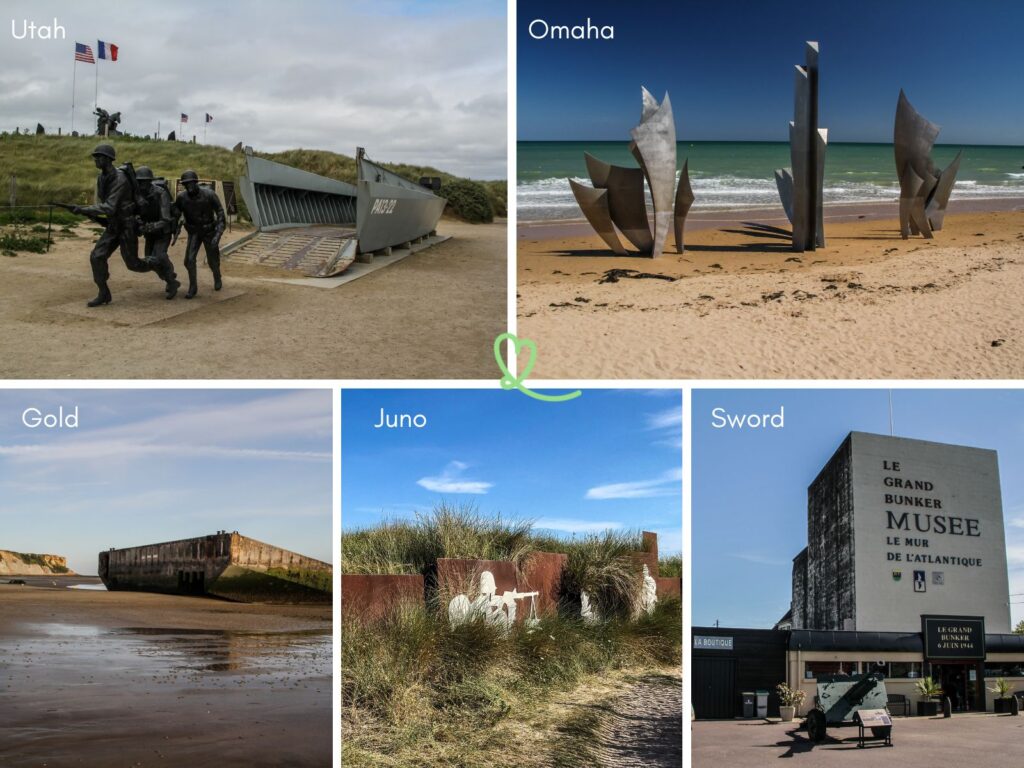
This guide is completely independent , based on our experiences. We visited the area anonymously, making our own choices, and paying all our bills in full.
Visit the D-Day landing beaches in Normandy : Map + tips
The 5 landing beaches – map and introduction.
Operation Overlord, a.k.a. the Normandy invasion, began on June 6, 1944. 5 main areas were strategically chosen by the Allies on the Normandy coast. They cover a section of more than 80km (50 miles). Code names have been given:
- Utah Beach, the easternmost beach where the American troops landed
- Omaha Beach where the American troops landed
- Gold Beach where the British troops landed
- Juno Beach where the Canadian troops landed
- Sword Beach where the British troops landed
Here is a short introduction video of each track:
The Battle of Normandy that followed lasted until the end of August.
Here is a map to help you locate them:
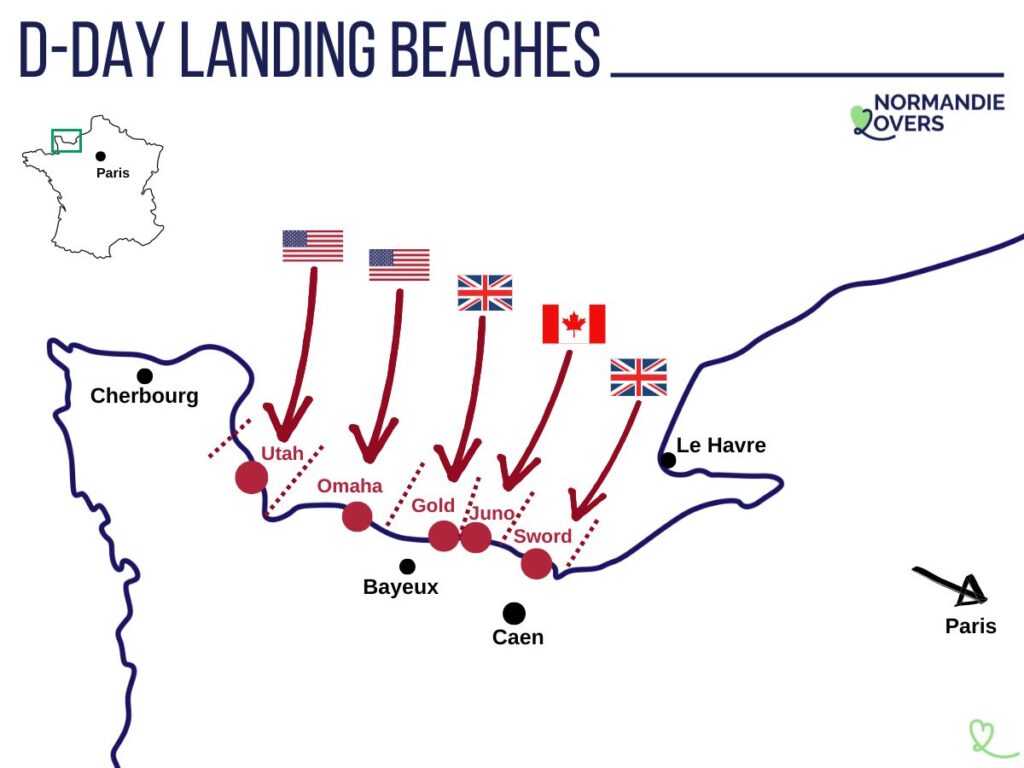
Which D-Day beach to visit?
Around these 5 beaches, you will find cemeteries, batteries, memorials and museums. They are all fascinating to discover. Depending on your family history, you can choose the one that interests you the most. And if you don’t know about special family ties, here are our opinions to help you choose:
- Utah Beach is the most fun : an open air museum, a battery and the new D-Day Experience not far away
- Omaha Beach is the most emotional : the magnificent sculpture on the beach, the intensity of the American cemetery. We didn’t expect to feel so many overwhelming emotions as we stood in front of all these crosses lined up.
- Gold Beach is the most fascinating visually: the remains of the temporary harbor that appear at low tide, the view from the cliffs…
- Juno Beach is the quickest to visit – if you’re short on time, the beach and museum are right next to each other
- Sword Beach is the most strategy oriented – no beach experience here, but the Antaltic Wall Museum in the Bunker is a unique experience and the Pegasus Memorial tells us more about this critical victory.

How to visit the D-Day beaches in Normandy?
We do not recommend public transportation to visit the landing beaches. There are some local buses, but not very frequent and with many stops for the locals. Your best options are:
- By car Visiting by car gives you a lot of flexibility in choosing where to go and how much time to spend at each place. You can rent at CDG or Orly airports, or Caen (see our tips ) or your point of arrival in France – note that Bayeux has very few choices (read more ).
OUR ADVICE FOR RENTING A CAR IN Normandy
- Compare prices on our preferred platform: DiscoverCars – one of the best rated sites.
- Choose a car that is comfortable enough (distances can be long) but compact (some parking lots and villages are narrow).
- Think of the complete insurance (some roads are tortuous and narrow).
- There is a lot of demand, book it early .
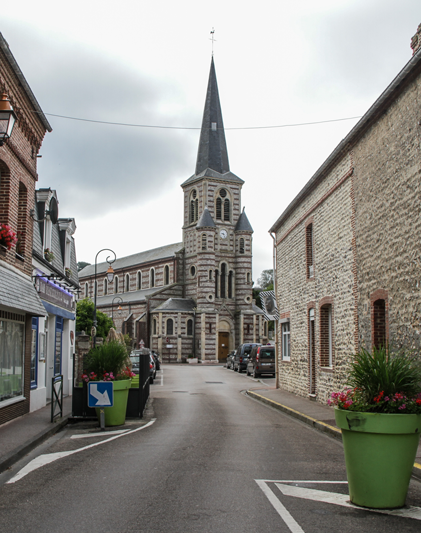
How long to visit the landing beaches
Let’s start by discussing a little bit about the driving times between locations. This will give you an idea of what is feasible:
- From Caen to Bayeux = 30 min drive
- From Bayeux to Utah Beach = 50 min
- From Utah Beach to Omaha Beach Beach = 45 min
- From Omaha Beach to Gold Beach = 45 min
- Gold Beach to Juno Beach Beach = 15 min
- From Juno Beach to Sword Beach Beach = 30 min
- From Sword Beach to Caen = 20 min
- Paris to Omaha Beach = 3h30
You can get an overview in one day. But for a more complete vision and to immerse yourself in the history we recommend 3 to 5 days, or even a week if you are passionate.

Which city is the most convenient to visit?
The most convenient cities to stay and visit all the landing beaches are :
- Bayeux, a charming little town inland see the best hotel offers
- Arromanches-les-bains, central and at the seaside, it is at the level of Gold Beach see the best hotel offers
- Caen is the largest city in the area see the best hotel offers
STAYING NEAR THE D-Day beaches
Option 1: Bayeux
The most practical option, in our opinion, is to base ourselves in the town of Bayeux. We recommend..:
- Hotel Domaine de Bayeux in an 18th century mansion – see prices, photos and availability
- see all top rated accommodations in Bayeux

Option 2: in the countryside
In the countryside around the D-Day beaches, you will find beautiful buildings with a lot of charm: farms, manors…
- Hotel Domaine d’Utah Beach – prices, pictures and availability
- Hotel Ferme de la Rançonnière – prices, pictures and availability

Option 3: next to one of the beaches
If you’re looking for a seaside holiday or are fascinated by one of the beaches, you can choose a more specific hotel:
- Hotel Villas d’Arromanches in Gold Beach Beach – prices, pictures and availability
- Hotel La Sapinière in Omaha Beach Beach – prices, pictures and availability

See all our advice on where to stay to visit the beaches
1. Utah Beach
The landing at utah beach – facts and figures.
Utah was the westernmost beach of the landing. It covered the section between Pouppeville and La Madeleine with the sub-areas Tare Green, Uncle Red and Victor. The section is 3 miles long (about 5km). 23,000 American troops landed here. Casualties were the lowest with 187 men killed or wounded.

Visit to the beach
The beach is easy to visit with a small dune, viewpoints and a large stretch of sand at low tide.

Barges and mannequins are installed not far from the museum, which allows to visualize a little better what the landing was like. But it’s hard to imagine this peaceful view with the sounds of gunfire, explosions and all the warships in the sea.

A little further down the beach, there are also some bunkers.

Museums around Sainte-Mère-l’Église
The main museum is the Utah Beach Landing Museum right on the beach. It tells in 10 sequences the events of D-Day. It is a chronological journey from preparation to victory. Open all year round

But the region is full of other museums and sites:
- The Airbone Museum with a superb scenography to understand the experience of the parachutists on the day of the landing Closed in December and January except during school vacations
- The D-Day Experience : an immersive museum with flight simulator Open all year round
- The Azeville Battery with an impressive underground complex Open from April to November 11
- The Normandy Victory Museum , about the Battle of the Hedges Open from April to October and partially in winter (weekends and vacations)
See more activities at Utah Beach .

Practical information to visit
Utah Beach is the most remote and scattered of the beaches. The museums are along the beach, in Sainte-Mère-l’église and in Carentan. You should plan at least one day but 2 days will allow you to cover more places. We stayed at the Domaine Utah Beach – Le Grand Hard hotel: a beautiful 17th century farmhouse turned charming hotel, with a restaurant known for its quality meat. A great time surrounded by nature! See photos, prices and availability Otherwise, there are hotels all around Sainte-Mère-l’église – see the best rated hotels aroundUtah Beach
USE OUR GUIDE TO PLAN A DREAM TRIP TO Normandy
All the information you need for your trip:
- 8 maps that make planning easier
- 160+ pre-selected locations
- Practical advice
- 300+ photos to help you choose
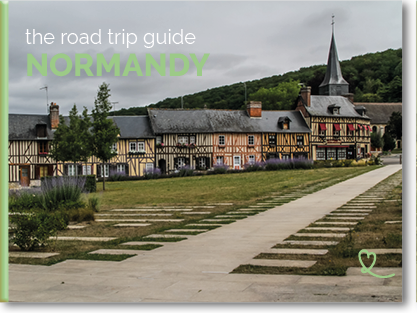
2. Omaha Beach
The landing at omaha beach – facts and figures.
Omaha, the largest, is probably the best known of the D-Day beaches. It covered the section between Sainte-Honorine-des-Pertes and Vierville-sur-Mer, with the sub-areas Charlie, Dog, Easy and Fox. The section is 6 miles long (about 10 km). 34,000 American troops landed here. Losses were highest, with 2,400 killed.

Omaha Beach is the most difficult to visualize. The beach has a promenade right on the edge and is very touristy with bathers. It is still one of the most photographed with the sculpture “The Braves”. It is composed of 3 elements: “Wings of Hope”, “Stand Up for Freedom” and “Wings of Brotherhood”. Created by Anilore Banon, it was installed in 2004, for the 60th commemoration.

The only signs of the war are the memorials and some bunker ruins.

Museums near Colleville-sur-Mer
- American Cemetery: 9387 perfectly aligned tombstones, garden, chapel, memorial, and a small museum giving the content of Operation Overlord. Open all year round
- Overlord Museum: near the American cemetery, one of the richest in terms of artifacts of the landing and the war. With a museography adapted to children. Closed in January and early February.
- The Pointe du Hoc: a strategic place of the German fortifications. The walk around the point takes you to see different bunkers above the cliffs. Open all year round
- Big Red One Assault Museum : museum dedicated to the 1st Infantry Division of the U.S. Army nicknamed “The Big Red One Open from March to November
- Maisy Battery : Battery rediscovered in 2006 with many underground passages. Open from April to September
- D-Day Omaha Museum – open from April to September
- Liberation House – open from May to September
- Omaha Beach Memorial Museum – open from June to September
Find out more about activities around Omaha Beach .

Omaha Beach is less remote but still requires a bit of a drive from Caen. The beach and the museums are grouped together, but to visit the Pointe de Hoc and the Maisy battery, you have to drive a little. You should plan at least one day but 2 days will allow you to cover more places. We stayed in Bayeux (25 min drive) at the Domaine de Bayeux: a charming hotel in the center of Bayeux surrounded by a French-style park. See photos, prices and availability Otherwise, there are hotels all around Colleville-sur-Mer – see the top rated hotels aroundOmaha Beach

MORE ABOUT THE D-Day sites
- The best landing sites to visit
- Visit the 5 D-Day landing beaches
- Where to stay – best hotels near the beach
- The best D-Day museums in Normandy
- German batteries to visit
- Car rental tips: Caen – Roissy-CDG – Orly – Beauvais
- Visit Omaha Beach
- Visit Utah Beach
- Visit Gold Beach
- Visit Sword Beach
- Visit Juno Beach (coming soon)
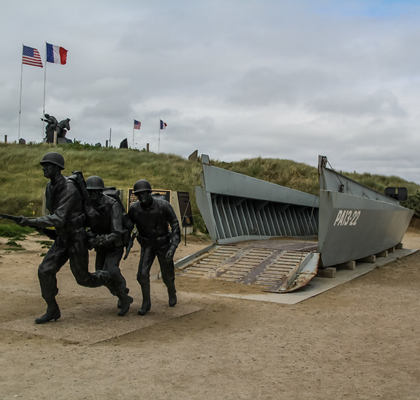
The Arromanches part of Gold Beach is one of the most visually interesting of the D-Day landing beaches. At low tide, pieces of the artificial harbor (Mulberries) appear clearly and you can approach them.

The beach of Arromanches is surrounded by cliffs. This allows to have beautiful views from the top of them.

And at the entrance to the beach, near the museum, you can appreciate several pieces of equipment.

Museums in Arromanches
- The D-Day Museum : presentation of the history of the British artificial harbor with the challenge of its construction and its key role in the victory. Closed in January
- The circular cinema Arromanches 360 : with 9 circular screens, the film “100 days of Normandy” plunges you during 19 minutes in the heart of the terrible battle. Closed in January
- The battery of Longues-Sur-Mer : a superb site on the cliffs with access to a fire command post, 4 reinforced concrete casemates and artillery pieces. Accessible all year round
- America Gold Beach Museum : dedicated to the first USA-France airmail link and the British landing in the “King” sector. Open from March to October
- Museum of underwater wrecks – open from June to September
Find out more about activities around Gold Beach .

The beach of Arromanches is very central. It is a good base to visit the landing beaches. The beach and the museums are grouped together. And the battery is only 15 minutes away. It is necessary to plan at least one day and to organize to visit the beach at low tide. We stayed at the hotel Les Villas d’Arromanches: a charming hotel in a 19th century villa on the heights of the city. A haven of peace with beautiful views of the sea. See photos, prices and availability Otherwise, there are hotels all around Arromanches – see the top rated hotels around Gold Beach

Subscribe to our Newsletter
- Get away from it all with Region Lovers’ beautiful destinations!
- Once a month
- Advertising-free
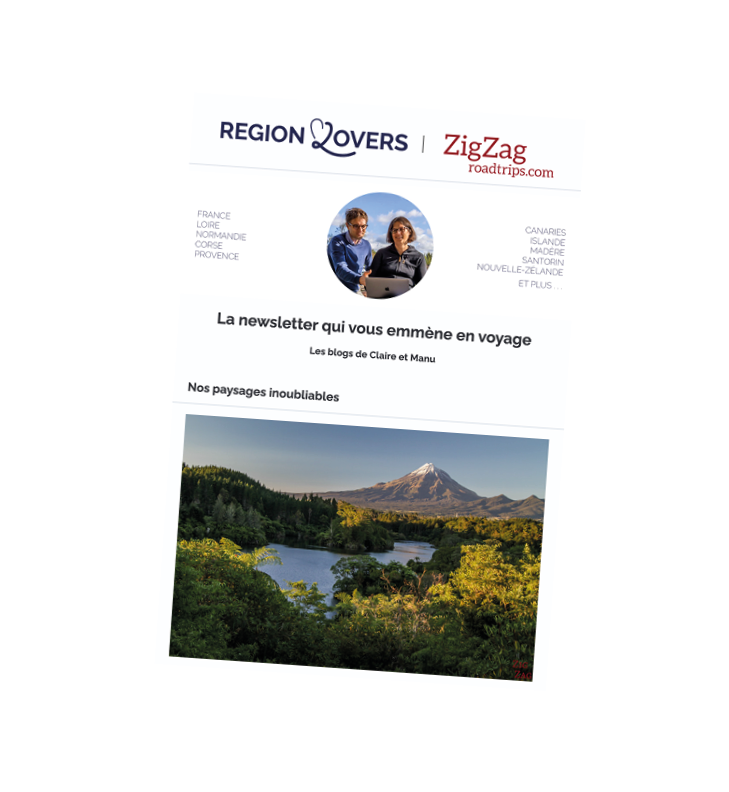
4. Juno Beach
The landing at juno beach beach – facts and figures.
Juno Beach was the landing site for the Canadian Army. It covered the section between La Rivière and Saint Aubin-sur-Mer, with the Love, Mike and Nan sub-sectors. The section is 6 miles long (about 10 km). 21,400 Canadian and British troops landed here. Casualties amounted to 1,200 wounded or killed (including 359 Canadian dead).

To reach the beach, you have to climb a small dune of white sand. The beach extends as far as the eye can see, when it is low tide.

The Cross of Lorraine is clearly visible. It was installed here to commemorate the place where De Gaulle first landed, an important turning point in the Battle of Normandy.

On the beach, not far from the museum, you can also see bunkers, tanks and representations of soldiers.

Museums in Courseulles-sur-Mer
- The Juno Beach Centre which focuses on the role played by Canadians alongside the Allied forces. You will discover a film and 5 permanent exhibition rooms. Closed in January Read more
- Beny-sur-mer Canadia War Cemetery : not far away you can visit the Canadian cemetery where over 2000 men are buried. Accessible all year round

Juno Beach Beach is surrounded by a very nice resort. It is a good base for a stay in Normandy. The museum is on the beach. And the cemetery is only 10 minutes away. You should plan for a half to a full day. We stayed at the hotel Ferme de la Rançonnière: stones and beams, everything that makes the charm of a Norman farm. See photos, prices and availability Otherwise, there are hotels in Courseulles – see the top rated hotels around Juno Beach
5. Sword Beach
The landing at sword beach beach – facts and figures.
The Sword Beach Beach landing was one of the most strategic because it was one of the main routes to northern France. It covered the section between Saint-Aubin-sur-Mer and Ouistreham, with the Oboe, Peter, Queen and Roger sub-sectors. The section is 5 miles long (about 8 km). 29,000 British troops landed here. Casualties amounted to 630 killed and wounded.

On the beach of Ouistreham, few traces of the war. It is a very large sandy beach with beach huts. On the other hand, the city is rich in museums.

Museums in Ouistreham
- Atlantic Wall Museum – The Great Bunker : Explore the former German headquarters in this massive bunker. The interior rooms have been reconstructed on all 5 levels. Closed in January and early February
- Pegasus Memorial : museum that presents the different missions of the 6th British Airborne Division, including the capture of the bridge of Bénouville called Pegasus Bridge. Closed from December 16 to January 31
- Museum No. 4 Commando : the history of French commando who joined the British troops and participate in their missions Open from April to early November
- Merville Battery: a German battery transformed into a museum with an excellent museography around bunkers, tanks, planes… Open from mid-March to mid-November
- Radar 1944 Museum (in Douvres-la-Délivrande): installed in the former German detection station, the museum presents the life of German soldiers during the occupation of Normandy as well as the history of radar. Open from April to mid-November
- And several cemeteries : La Délivrande, Hermanville, Ranville
Find out more about activities around Sword Beach .

Sword Beach Beach is in Ousitreham, a seaside resort with a huge beach. The museums are close to the beach. The Merville battery is 20 minutes away. Douvres-la-Délivrande is 20 minutes away. You should plan at least one day but 2 days will allow you to cover more places. There are many hotels and rentals in Ouistreham – see the top rated hotels around Sword Beach
Normandy beaches – D-Day in numbers
Just over 156,000 men landed on the beaches of Normandy.
The allied troops arrived
- Paratroopers: over 23,000
- By sea: over 133,000
The soldiers disembarked by nationalities
- Americans: approximately 73,000
- British: approximately 62,000
- Canadian: approximately 21,000
- and also soldiers from Belgium, Norway, Poland, Luxembourg, Greece, Czechoslovakia, New Zealand and Australia.
- And more than 170 French commandos
Casualty estimates – how many died on the beaches of Normandy
- Number of allied losses on June 6 at midnight (killed, wounded, prisoners…): more than 10 000
- Number of German losses on June 6 at midnight (killed, wounded, prisoners…): estimated between 4000 and 10000…

The equipment
- Support aircraft: over 11,000
- Combat ships: more than 1200
- Landing ships; over 4,000
- Merchant ships: over 800
- The ships were 80% British and 16% American
Frequently asked questions about beaches
Landing beach in 1 day.
If you only have one day to visit the D-Day landing beaches, it is best to choose one of the 5 beaches described in this article according to your interests:
- Omaha is the most emblematic of the beaches with the sculpture and the American cemetery
- Utah or Omaha for the Americans
- Juno for Canadians
- Gold Beach for the British
- Gold Beach for those interested in temporary port engineering
- Sword Beach and Utah Beach for the best museums (in our opinion)
What was the bloodiest beach on D-Day?
The losses on Omaha Beach were the worst on D-Day. American troops lost more than 2400 soldiers who were killed, wounded or taken prisoner.
Are the beaches of Normandy still stained with blood?
No. Without the memorials, bunkers and cemeteries, it is impossible to imagine what happened on these beaches in 1944. These are now beautiful sandy beaches where people swim in the summer.

Can we take sand from the beaches of Normandy?
No. As in many other countries, it is illegal to take sand or pebbles from French beaches.
Visit the D-Day landing beaches in winter
You can visit the D-Day landing beaches in winter. The winter atmosphere is more conducive to introspection on their history than the summer crowds… Please note, however, that almost all museums close at least in January and early February. Closing times depend on the museum. See our article on museums . However, the beaches and many of the bunkers remain freely accessible.
Films on the D-Day beaches in Normandy
The Longest Day (1962) A very realistic account of the landing at Omaha Beach. Take a look at it before your visit, to better contextualize everything you are about to see.
Saving Private Ryan (1998) War movie directed by Steven Spielberg with Tom Hanks and Matt Damon. It is inspired by the real-life story of the Niland brothers, American soldiers killed during World War II. In this fiction, the hero goes in search of the last survivor to bring him back to his mother.
Overlord (1975) Black and white film by Stuart Cooper. Story of a young recruit and his training before D-Day.
PLAN YOUR TRIP TO Normandy
Inspiration destinations
- Deciding where to go in Normandy – the best destinations
- Our weekend ideas: best-of , romantic , unusual , seaside , luxury , family
- 16 seaside hotels in Normandy
- The most beautiful charming hotels in Normandy

- Best things to do in Normandy
- Best cities in Normandy
- Most beautiful beaches of Normandy
- Most beautiful villages of Normandy
- Best castles of Normandy
- Best abbeys of Normandy
- Read our complete guide to visit the Mont-Saint-Michel
- Discover the D-Day sites

- Where to stay in Normandy – best places and hotels
- See our tips for renting a car at CDG airport , Orly airport , Beauvais airport , Caen , Rouen , Bayeux …

SHE MADE THE TRIP AND WROTE THE ARTICLE Claire
Region lovers' 10 commitments.
- Visit all the places we tell you about.
- For each city, stay in at least one hotel and visit the ones we recommend.
- For each city, eat in at least one restaurant, visit the ones we select.
- Pay all our invoices in full, refuse any partnership or sponsorship.
- Periodically update our articles, with the help of our readers.
- Enrich our articles with our first-hand experiences.
- Use 99% of our own photos
- Use digital tools in a reasoned and transparent way, feeding them with information verified on site.
- Provide information on the traveler/writer pairing that gave rise to the article.
- Tell you what we do, and do what we tell you!
Claire and Manu
Find out more about the team and our history.

SEARCH OUR SITE
Our multi-destination blogs.
Regionlovers.fr
ZigZagroadtrips.com
OUR OTHER REGIONS TO DISCOVER
LoireLovers.fr
CorsicaLovers.fr
ProvenceLovers.fr
CanariasLovers.com
CHANGE LANGUAGE
Legal Notice / Terms of Use / Privacy Policy
Commonwealth war graves commission Caring for the fallen
Commonwealth war graves Foundation Our charity site

- Search in War Dead
- Search in Cemeteries and Memorials
- Search in Website
Visiting the beaches of Normandy – WW2 guide
29 April 2024
Thinking of visiting the Normandy D-Day beaches? Here’s a handy guide on everything you need to know.
Normandy D-Day beaches to visit
With the Normandy 80th anniversary on its way, why not make a trip to see D-Day's landing beaches?

Where is Gold Beach?
Gold Beach was one of three Normandy landing beaches assigned to the Commonwealth forces on D-Day.
The landing zone stretched 8 kilometres from Port-en-Bessin in the west to La Rivière, Ver-sur-Mer in the East. The seaside resort of Arromanches lay in the west of the landing zone. Deeper inland from Gold sat the historic town of Bayeux.
History of Gold Beach
Wehrmacht forces occupying Gold Beach were tucked away in houses along the coast, particularly at La Rivière and Le Hamel. The landing beach was also in range of a gun battery located a kilometre inland, directed from a clifftop observation post at Longues-sur-Mer.
Gold comprised three sectors, running west to east: How, Item, Jig, and King. It was to be assaulted by the 50th (Northumbria) Division.
The 50th Division’s objectives were to capture Arromanches, cut the Caen-Bayeux Highway, and link up with the Canadians from Juno Beach in the east and the Americans from Omaha to the west.
Landing craft from the 50th Division hit Gold Beach at 7:25 am on the morning of D-Day. German defences had been softened by RAF and Royal Navy bombardment before the assault.
The infantry was supported by tanks and specialist Armoured Fighting Vehicles Royal Engineers (AVREs) to help clear beach obstacles and defences.

Image: 47 Commando comes ashore on Gold Beach, 6 June 1944 (© IWM)
At the same time as the main infantry assault, special forces of 47 Commando came ashore too. Its target was to capture the small harbour at Port-en-Bassin at Gold Beach’s western edge.
No German tanks were present on Gold Beach. Infantry resistance was minimal compared with other D-Day landing beaches. The Royal Navy and Air Force bombardments had softened up defences enough.
German forces at La Rivière had been subdued by 10.00 am. By mid-afternoon, Le Hamel had been captured. 47 Commando had pushed towards its objective at Port-en-Bessin but was unable to take the small port on D-Day itself.
One of the supporting Royal Navy vessels, HMS Ajax, had taken out the Longues-sur-Mer battery after a furious long-range duel.
By the evening of D-Day, the 50th Division had landed 25,000 men. The British had pushed 50 kilometres inland. They had also linked with the Canadians advancing from Juno Beach, but they had so far failed to cut the Caen-Bayeux highway.
The forces at Gold made a good start, securing an important beachhead for 400 casualties.
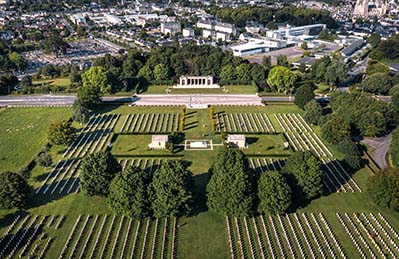
Bayeux War Cemetery
Bayeux War Cemetery , although started in 1952, has become one of the focal points for the commemoration of the Normandy campaign’s Commonwealth war dead.
Over 4,500 war graves can be found in Bayeux War Cemetery. D-Day war graves total around 500 of the Commonwealth burials here.
Within Bayeux War Cemetery stands the Bayeux Memorial, commemorating fallen officers and enlisted men with no known war grave. 1,800 servicemen are commemorated by name on the memorial.
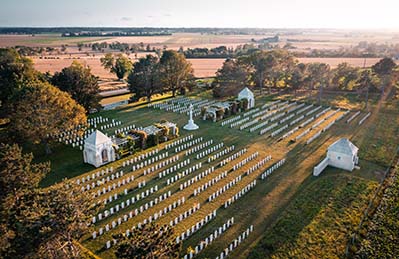
Ryes War Cemetery
Ryes War Cemetery lies close to Arromanches.
The first burials at Ryes were made just two days after the landings on Gold Beach.
Today, it contains around 650 Commonwealth war graves, roughly a sixth of which were casualties killed on D-Day itself. Interestingly, there are around 330 German graves at Ryes War Cemetery .
Getting to Gold Beach
Gold Beach is accessible via public transport using Normandy’s transport network or by road.
For travellers from the UK, the fastest direct route to Normandy D-Day beaches is by ferry from Portsmouth.
The vessel docks at Ouistreham, taking you directly into the heart of the D-Day battlefields and landing beaches.
From Ouistreham, Arromanches and Gold Beach is about a 40-minute drive. Depending on traffic, it takes but takes around four hours when driving from Calais. Reaching Arromanches and Gold Beach from Cherbourg takes roughly an hour and a half.
Sword Beach
Where is sword beach.
Sword Beach was the most easterly of the Commonwealth Normandy landing beaches on D-Day.
It lies on an 8-kilometre of the Normandy coast between Lion-sur-Mer in the west and Ouisteham in the east. It is around 15 kilometres away from Caen.
Sword Beach was and is very sandy, turning into dunes. In 1944 It had only been lightly fortified with beach obstacles and emplacements, although German defences stretched inland.
An artillery battery at Merville, 8 km to the east, overlooked the beach. A range of mortars, 88m guns and machine guns were also built inland.
History of Sword Beach
Sword Beach was divided into four sectors for the D-Day assault. From west to east, they ran Oboe, Peter, Queen, and Roger.
Assaulting Sword were the men of the British 3rd Division, made up of regiments including the Suffolks, South Lancashires, and East Yorkshires to name a few. Accompanying the main assault were the special forces units from the 1st and 4th Special Service Brigades.
3rd Division’s D-Day objectives were to land and push up the beaches to pass through Ouistreham. Caen, as the region’s major transport hub, was 3rd Division’s chief objective, however.

Image: 8.45am Sword Beach, 6 June 1944 (© IWM)
The special forces were to push inland toward the Orne River and Caen Canal Bridges and link up with Airborne forces already in Normandy.
Seaborne forces’ landing craft hit Sword Beach at around 7.25 am. Fighting on the beach was relatively light. Within 35 minutes, Sword had been cleared and combat moved inland.
In the early afternoon, the Commandos had managed to link up with the men of 6th Airborne.
6th Airborne had been in Normandy for hours already, dropping in behind enemy lines around midnight. It was their job to the Orne and Caen bridges to provide exit routes for the forces assaulting Sword Beach. Other units were assigned to knock out the Merville battery.
Both airborne objectives had been achieved by the time the amphibious assault began, making it easier for the regular army units to come ashore.
By the end of June 6th, the British had landed some 29,000 men on Sword Beach. Taking the beach and subsequent fighting cost the British around 630 casualties.
Caen remained out of British hands until the end of July 1944.
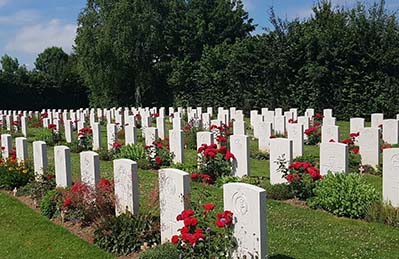
Hermanville War Cemetery
Hermanville War Cemetery contains many D-Day war graves , representing roughly a quarter of the 1,000 burials in the cemetery.
Hermanville is a small village that lies a short way behind Sword Beach.
It was occupied early on D-Day by men of the South Lancashire. Later that day, the Shropshire Light Infantry and tanks of the Staffordshire Yeomanry managed to capture Bieville-Beniville, around 4 kms to Hermanville’s south.
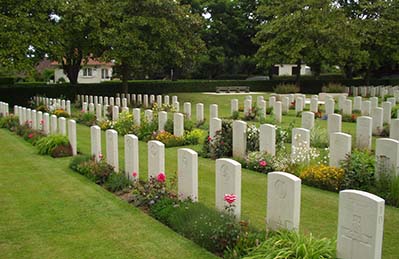
La Deliverande War Cemetery, Douvre
La Deliverande is only a short distance from Sword Beach, situated to the west of Hermanville.
The war cemetery was started not long after D-Day, with casualties from Sword Beach buried here, drawn from the beach’s Oboe and Peter sectors.
Over 1,020 personnel are buried at La Deliverande War Cemetery .
Getting to Sword Beach
Ouistreham is the quickest way to get to Sword Beach and the quickest way for UK visitors is via Portsmouth. The ferry from Portsmouth docks at Ouistreham.
Sword Beach is around three and a half hours by car from Calais and roughly the same by car from Paris.

Where is Juno Beach?
Juno Beach lies between Gold Beach to the west and Sword Beach to the East.
The landing zone stretched across a 10-kilometre front, stretching along the small fishing port of Courseulles-sur-Mer.
Several small conurbations and villages lay behind the beach’s sandy dunes or dotted the seafront. German forces occupied and fortified them with gun emplacements, fighting positions, and casemates.
Hidden beneath the sea on the approach to Juno were several natural obstacles, including reefs and shoals, making the approach tricky to navigate.
History of Juno Beach
Juno Beach was the third assigned to Commonwealth armies for Operation Overlord. The Canadian Army was tasked with taking Juno and forging inland, specifically the 3rd Canadian Division.
The Canadian D-Day objectives were to cut the Caen-Bayeux road, take the important Carpiquet airfield near Caen, and then link up with British troops making their way off Sword and Gold beaches.
Because of the natural hazards, Allied planners had to launch the Canadians later than desired so their landing craft could clear the reef on the rising tide.
The Canadians landed on Juno at 07.55 am on the morning of June 6th 1944. Not only were they 10 minutes behind schedule, but they were also three hours behind the optimal tide height.

Image: Canadian soldiers leave their landing craft on Juno Beach (© IWM)
This gave the Canadians a problem. Juno was littered in now partially submerged beach obstacles. The Royal Canadian Engineers were unable to clear an unobstructed path to the beach so landing craft pilots had to navigate by feel to get their men to shore.
Mines took a heavy toll on the Canadian landing craft. 30% of Juno landing craft were damaged or destroyed.
In contrast to Sword and Gold, the Canadians had a much tougher time getting off the beach. The German defences were more focussed on overlooking the coastline, rather than firing out to sea.
As the Canadian infantry made its way up Juno Beach, it came into enemy killing zones which reaped a terrible toll on the first wave. In the first hour of the assault, there was a 50/50 chance that each Canadian soldier become a casualty.
The Canadians never wavered, however, and by mid-morning they had captured the town of Berniéres and Saint-Aubin, getting off the beach.
Progress into Normandy was good. Success infantry waves supported by Canadian armour meant that by the end of the day, the Canadians had made the most progress of any Allied army in Normandy.
But that progress was not without cost. Off the Commonwealth forces on D-Day, the Canadians took the highest casualties, suffering 1,200 casualties (340 killed) for 21,400 troops landed on Juno.
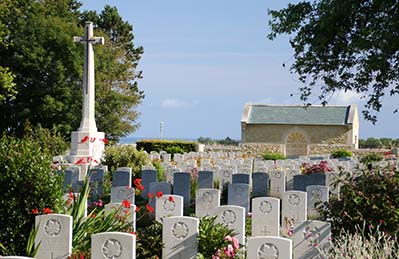
Beny-sur-Mer Canadian War Cemetery, Reivers
Beny-sur-Mer Canadian War Cemetery contains over 2,000 Second World War graves .
As the name suggests, most of the war graves in Beny-sur-Mer are Canadian.
Roughly 300 were killed on D-Day, either on Juno Beach or as the fighting turned inland.
How to get to Juno Beach
Most Canadians visiting Juno Beach will arrive in France via Charles de Gaulle Airport, around 25km north of Paris. From there, the quickest route would be a direct train to Caen or a three and hour drive from Paris.
Visitors from Britain are best to catch the ferry to Ouistreham as this will take you directly into the D-Day invasion area. Juno Beach is then a 25-minute drive, depending on traffic.
Reaching Juno Beach from Calais is roughly 3 hours and 45 minutes by car. From Paris, it can take up to 3 and a quarter hours, depending on traffic.
Omaha Beach

Where is Omaha Beach?
Omaha Beach was one of five landing beaches of the Normandy invasion. It was one of two assigned to the United States.
Omaha Beach stretched from Port-en-Bessin in the east to the mouth of the Vire River in the west, covering 10km.
The landing beach was overlooked by 30-metre-high cliffs. Some sections of the western beach were backed by a strong, 3-metre-high seawall as well. German Field Marshal Erwin Rommel had ordered Ohama Beach to be fortified as part of his Atlantic Wall.
The waters were mined, and beach obstacles were laid. German machine gunners peaked out over the beach from vast concrete bunkers and redoubts. Up the cliffs, a trench network wound its way inland.
Even today, numerous concrete strong points can be seen in and around Omaha, showing the area’s lethality.
The history of Omaha Beach
Omaha was assaulted by the forces of the US 1st Infantry Division, aka the Big Red One.
1st Division’s objectives were to capture the villages of Vierville, Saint-Laurent, and Coleville. It was to then push onwards toward the Bayuex-Isigny Road and continue heading west towards Pointe du Hoc.
The attack began at 06.30 on the morning of June 6, 1944. Choppy waters and strong winds drove landing craft off course.
Omaha turned into a killing field. American troops sought cover behind beach obstacles or wrecked vehicles, pondering whether to make the deadly run for the seawall.

Image: "Into the Jaws of Death", Robert F. Sargent's famous photo of the US 1st Division's assault on Omaha Beach (public domain)
The carnage was so bad that by 08.30, all landings at Omaha had stopped. Men on the beach were left on their own. Slowly but surely, the US soldiers began to form groups and scale Omaha’s imposing cliffs.
To alleviate the pressure, US Navy destroyers sailed up to the beach and began bombarding German positions at point-blank range.
By midday, German fire noticeably decreased as defences were flanked and taken from the rear. Allied soldiers could now begin opening each of Omaha’s five beach exits one by one.
Elsewhere in the Omaha sector, the US Rangers were given the job of assaulting Pointe du Hoc. Pointe Du Hoc is a rock escarpment jutting out into the English Channel which gave fantastic views of the American landing beaches at Normandy.
Atop were gun emplacements and casemates zeroed in on Utah Beach.
With rope ladders and grappling hooks, the Rangers scaled 100 sheer cliffs under heavy fire.
They managed to reach the top when, to their horror, they found empty casemates. Where were the big guns? Sweeping nearby, the Rangers thankfully found the German artillery, hidden in a sunken road, and disabled it.
By nightfall on D-Day, the US held ground around Vierville, Saint-Laurent and Colleville. The advance was far behind schedule, but the resistance had been incredibly tough at Omaha.
The US forces at Omaha had suffered 2,400 casualties but had managed to land 34,000 men.
How to get to Omaha Beach
Omaha Beach is around 40 minutes from Ouisreham, the disembarkation point of the Portsmouth-Caen Ferry. This would probably be the quickest way to reach Omaha Beach for UK visitors.
For those coming from Calais, the journey is roughly four hours by car.
American tourists paying a visit to the Normandy D-Day beaches are most likely to be arriving in France via Paris Charles de Gaulle Airport. By car, this will take between three and a half and four hours.

Where is Utah Beach?
Utah Beach was the most westerly of the five Normandy D-Day landing beaches.
It lies at the base of the Cotentin Peninsula, at the top of which lies the great Atlantic port of Cherbourg.
Utah covered 5 kilometres, running northwest of the Carentan estuary, along a ribbon of sandy, duned beach.
Four causeways exited Utah Beach, leading to the important crossroads towns of Carentan and Sainte-Mére-Église.
The land behind Utah is flat, open, and low-lying. To limit enemy movement, the Germans had flooded these areas and could control the flood levels with locks.
The history of Utah Beach
Of the Normandy landing beaches assaulted by US forces, Utah was the least heavily defended.
The assault began at 06.30 am, led by the IS 4th Infantry Division.
Their goal was to capture the beach, take control of the coastal roads, link up with Airborne elements dropped earlier in the day, and get ready for a later attack on Cherbourg.

Image: US troops wade ashore on Utah Beach (public domain)
The Utah landings were met with confusion. Strong currents blew the landing craft off course while the beach was obscured by smoke from the preliminary Allied naval bombardment.
Three control craft, essentially for guiding troops transports to the beach, were lost to mines.
Eventually, the Americans were able to land some 1,800 metres away from their designated area, leading commander Brigadier-General Theodore Roosevelt Jr. to declare “We’ll start the war from here!”.
This turned into a happy accident. The Americans had landed at a lightly defended section and within three hours had captured three of Utah’s four beach exits. By noon, they had linked up with paratroopers of the 101st Airborne.
By the end of D-Day, 20,000 Allied troops and 1,700 vehicles had landed at Utah.
How to get to Utah Beach
The closest ferry stop near Utah is Cherbourg, which is about 45 minutes away by car.
American visitors to Normandy’s historic D-Day beaches are likely to arrive in France at Paris Charles de Gaulle Airport. Then it is around a four-hour car journey to Utah Beach.
If driving from Calais, the journey to Utah takes around four and a half hours.
Normandy landing beaches map

Image: Map of the Commonwealth Normandy landing beaches with CWGC cemeteries and memorials highlighted.
Normandy beach tours
Guided tours are available where battlefield guys take visitors to the beaches.
These extend from week-long package deals to coach and minibus trips to day excursions to Normandy’s varied remembrance sites.
Self-driving tours are a very popular way history enthusiasts experience the beaches of Normandy. Cycle tours are also very common, taking in the beaches and the bocage.
Normandy boasts a wide network of tour operators and battlefield guides but at present Commonwealth War Graves does not partner with any tour operators in the region.
Visiting Normandy landing beaches from the UK & France
Ferry or Eurotunnel are possibly the easiest ways to visit the Normandy landing beaches from the UK.
There are multiple ferry crossings with some sea routes landing in Ouistreham (Caen), Cherbourg and Le Havre, which are all within a reasonable driving distance from the beaches.
Calais is a short ferry crossing. The Eurotunnel crossing also ends in Calais. However, the drive to Normandy can take up to four hours, depending on which beach you are visiting.
Normandy is accessible to the of France by its extensive motorway and railway network.
How long does it take to visit Normandy beaches of WW2?
The D-Day landing beaches stretch over 70 kilometres of the Normandy coastline. It may be difficult to fit all of them in just one trip.
There is a lot to see and learn at these locations and landmarks. Rushing through the sites may not be the best way to experience everything the beaches of Normandy have to offer.
Reports from tourists on sites such as Tripadvisor suggest two days should be enough to visit Normandy D-Day beaches.
What’s the best Normandy landing beach to visit?
That depends entirely on your particular area of interest or connections to the D-Day story.
For Canadians, for example, Juno Beach and the museum there will likely be the first port of call on a Normandy beaches trip.
UK tourists may prefer to visit Sword and Gold Beaches. For US tourists, their first interaction with Second World War history may have been through the stories of Utah and Omaha Beaches, so they may be more drawn to them.
Each beach is a location steeped in history. There are museums, old bunkers and gun emplacements, and artefacts of the Normandy landings at each.
In the case of the Commonwealth landing beaches, Commonwealth War Graves cemeteries and memorials are close by too, commemorating many of the men who were killed storming the beaches of Normandy.
What’s the best time to visit Normandy beaches?
Between April and October is considered by organisations such as Normandie Tourisme as the best time to visit the Normandy beaches.
Temperatures are generally mild through spring to autumn, averaging 15-28°C (55-85°F), so the weather should be pleasant.
The summer is when tourism will pick up, especially in June when D-Day anniversary events will be taking place across the beaches and at locations tied to the invasion. Normandy is likely to be very busy at times like this, so take that into account when planning a trip to Normandy.
For cooler weather and less crowds, try visiting in April/May or September/August.
What’s the best way to visit Normandy beaches?
Again, this is dependent on your circumstances, itinerary and how you like to engage with historical sites. You may wish to book a guided tour or visit at your own pace. There is no definitive “best” way to visit Normandy beaches.
Where to stay when visiting Normandy beaches?
The beaches are studded with many small villages and seaside towns, as well as larger places like Arromanches and Ouistreham.
Each is full of hotels, guest houses, and bed and breakfasts offering accommodation.
According to Camping France, there are 36 campsites near the Normandy beaches.
Do I need a guide to visit Normandy beaches?
You do not need a guide to visit Normandy beaches.
Can you visit Normandy beaches without a tour?
Yes, Normandy’s D-Day beaches are easily accessible to the public without tour guides.
Are you allowed to go on a Normandy beach? Yes, these are public beaches and open for everyone to enjoy.
At the height of tourist season, the beaches are covered in beachgoers enjoying their summer holidays with swimming and making sandcastles, intermingling poignantly with the reminders of the Atlantic Wall and D-Day landings all around them.
Other memorial sites to visit in Normandy
When it comes to Normandy memorial sites, you are spoiled for choice.
There are over 115 Commonwealth War Graves sites in the Calvados region of Normandy alone. They are reminders of the cost of D-Day and the Normandy Campaign.

Image: The Normandy American Cemetery (Public domain)
American troops are commemorated at the Normandy American Cemetery. It holds over 9,000 Second World War burials. A further 1,500 are commemorated on the Normandy American Memorial.
German casualties are buried at La Cambe German War Cemetery. Once an American war cemetery, La Cambe has been a German site since 1948 and holds 21,000 burials.

Lighting their Legacy
Across the UK, May & June
Discover our national programme of events and inspire the next generation.

The Great Vigil
Normandy, 5 June
Join the culmination of our D-Day events as we illuminate every CWGC grave in Normandy.
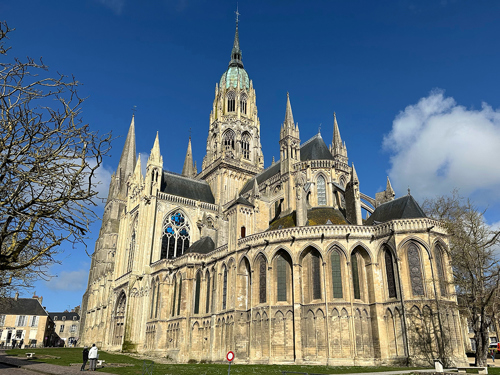
DISCOVER OUR 80TH ANNIVERSARY WW2 EVENTS
We're holding a number of events across the UK and in Normandy in the build up to the 80th anniversary of D-Day. Find out more about what we're planning and discover how you can get involved.
Must-see attractions in D-Day Beaches
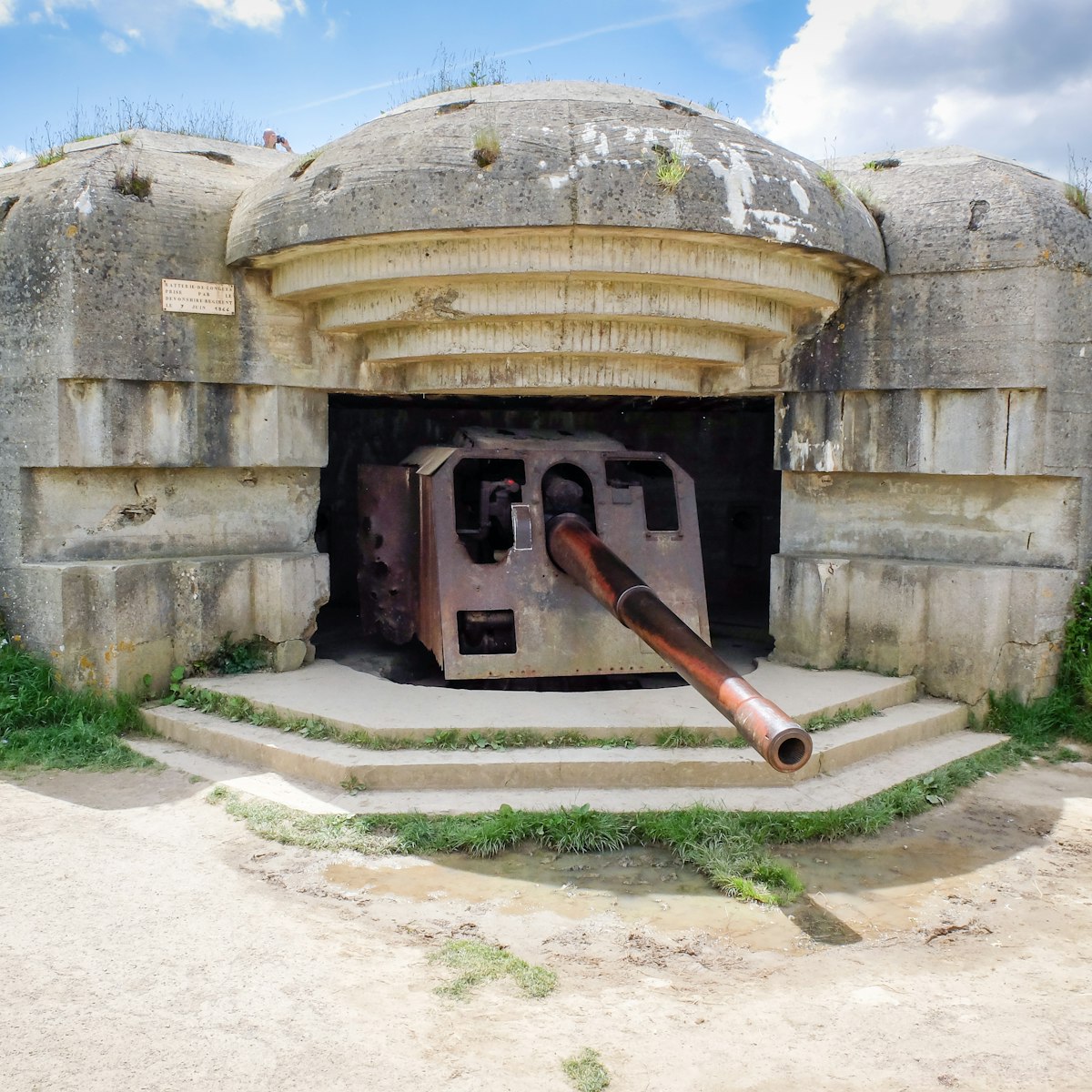
Longues-sur-Mer Battery
D-Day Beaches
These mammoth German artillery pieces remain in their colossal concrete emplacements – the only in-situ large-calibre weapons in Normandy. The first…

Normandy American Cemetery & Memorial
White marble crosses and Stars of David stretch off in seemingly endless rows at the Normandy American Cemetery, situated on a now-serene bluff…
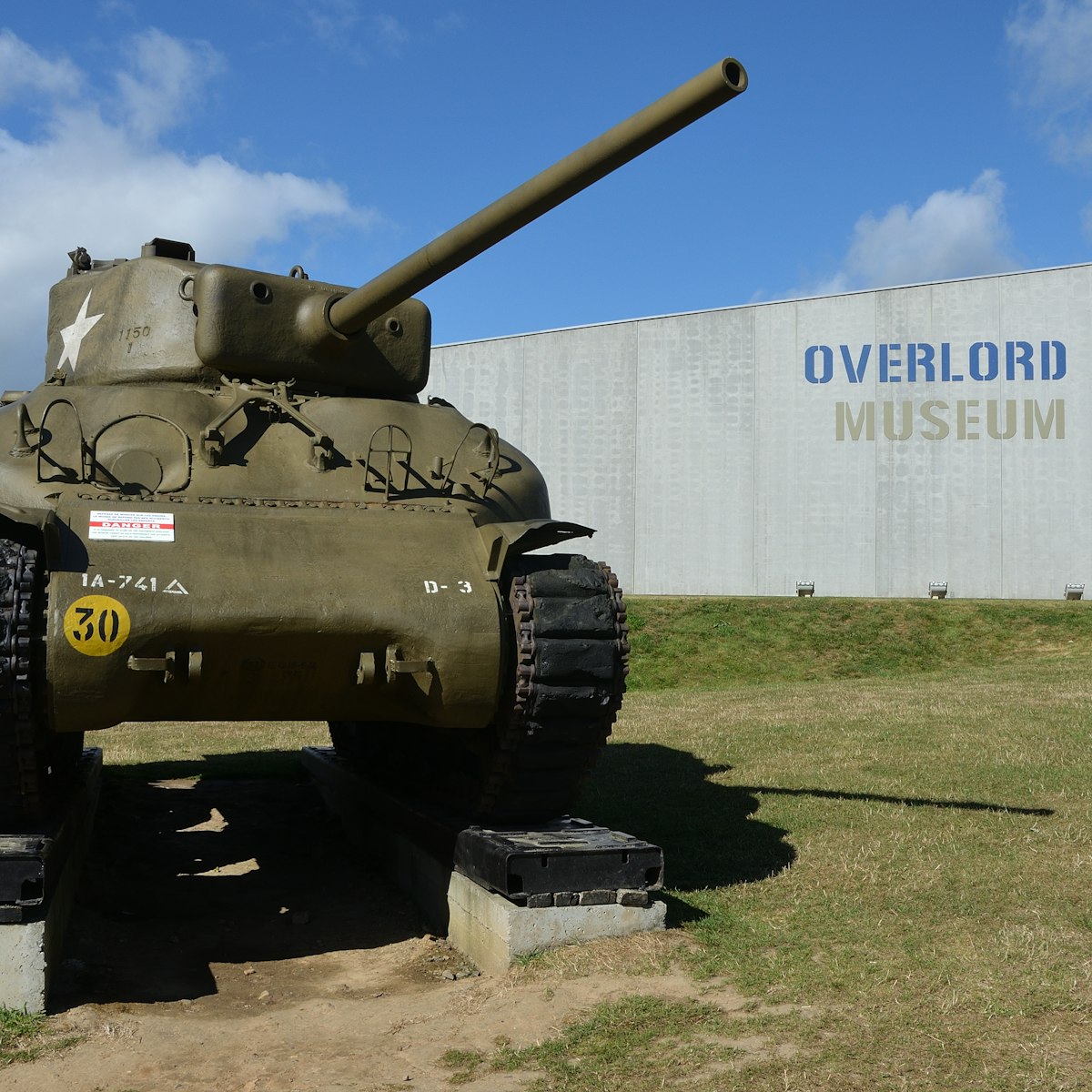
Overlord Museum
This excellent museum has an astonishing collection of restored WWII military equipment from both sides; the human dimension of the war is brought…

Pointe du Hoc Ranger Memorial
At 7.10am on 6 June 1944, 225 US Army Rangers under the command of Lieutenant Colonel James Earl Rudder scaled the impossibly steep, 30m-high cliffs of…
Juno Beach Centre
Juno Beach’s only specifically Canadian museum, the nonprofit Juno Beach Centre, has multimedia exhibits on Canada’s role in the war effort and the…
Musée du Débarquement
Down in Arromanches itself and right on the beach, the Musée du Débarquement makes for a very informative stop before visiting the beaches. Dioramas,…
Arromanches 360° Circular Cinema
The best view of Port Winston and nearby Gold Beach is from the hill east of town, site of the popular Arromanches 360° Circular Cinema, which screens…
Mulberry Harbours Caissons
The harbour established at Omaha was completely destroyed by a ferocious gale (the worst storm to lash the Normandy coast in four decades) just two weeks…
Musée du Débarquement de Utah Beach
This impressive museum is a few kilometres inland from the US landings at Utah Beach. Guided tours of the museum and of the landing site can be arranged…
Bény-sur-Mer Canadian War Cemetery
The Bény-sur-Mer Canadian War Cemetery is 4km south of Courseulles-sur-Mer near Reviers.
More destinations you need to see
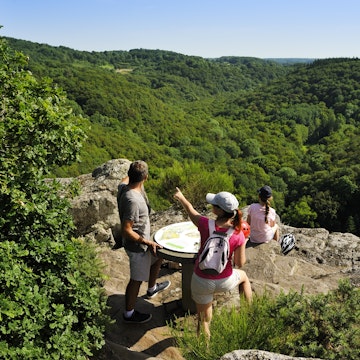

12 Top Normandy D-Day Beaches and Memorials
Written by Barbara Radcliffe Rogers Updated Mar 30, 2022
The allied invasion of Normandy on June 6, 1944 is not only one of the great epics of military – and human – history. D-Day was also the turning point that brought Europe out of the iron grip of the Nazis and all the bigotry, genocide, oppression, and inhumanity they stood for.
Establishing a western land front was crucial to the allies, and in a few short hours, and in the face of overwhelming odds, it was accomplished by the massive and heroic efforts of Canadian, American, and British forces joined by smaller contingents of Polish, Danish, and Free French troops.
The fact that the months of strategic and material planning and preparation for the code-named " Operation Overlord " was all carried out in secret, all the while feinting at an invasion elsewhere to divert German troops, is nothing short of a miracle.
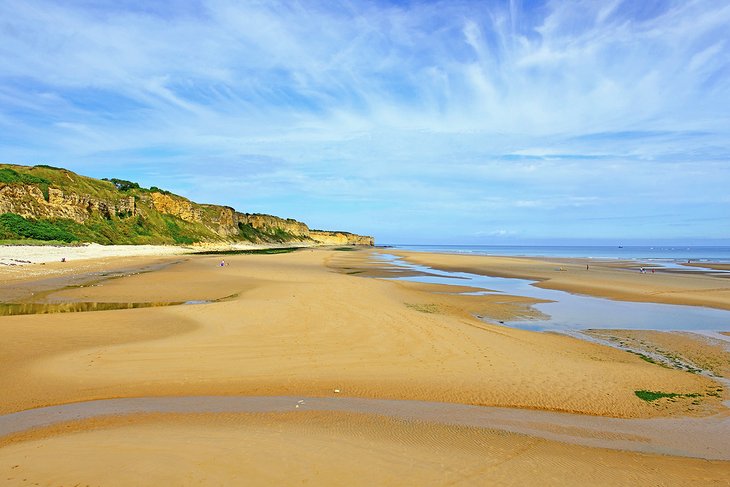
The landing sites lie between Pegasus Bridge in the east and Sainte-Mère-Église in the west and are described below in that order, east to west. Today, this stretch of Normandy's English Channel coast has returned to sandy beaches filled with laughing children and sun-seekers, but everywhere you go are reminders of those terrible days and the horrific toll of lives they took. Hitler's " Atlantic Wall " is still evident in tank traps and massive bunkers, some askew where they slowly settled into the dunes in more peaceful decades since, others made into some of the many museums that tell the D-Day story.
At each of the landing sites and all along the shore are monuments and memorials to those who fought and died, and each museum illuminates a different piece of the story. These are more than tourist attractions. They are moving scenes that lead visitors to deeper thoughts on mankind, its past and its future. They deserve the attention of every generation, and the museums reflect this.
Several have exhibits well-designed for young people, realistically replicating scenes and showing in videos or activated models how equipment worked. There are things to do as well as things to see: visitors can climb aboard historic landing craft, sit in a tank, step inside a replica glider, explore dark cavernous bunkers, and look for tank traps in the dunes. Or they can stand in silence at the Normandy D-Day beaches and memorials as they try to picture these scenes from history.
Although it's possible to visit some of the main landing beaches on a day trip from Paris , if you want to explore the coast and its World War II history more thoroughly, you'll need more time here. Plan your trip to the historic sites with the help of our list of the top Normandy D-Day beaches and memorials.
1. Caen Memorial Center
2. pegasus bridge, 3. sword beach and the atlantic wall museum, 4. juno beach, 5. arromanches, 6. omaha beach: american cemetery and overlord museum, 7. pointe du hoc, 8. utah beach and the museum of the landings, 9. sainte-mère-église and airborne museum, 10. gold beach and british normandy memorial, 11. falaise and the memorial to civilians in wartime, 12. memorial museum of the battle of normandy, map of normandy d-day beaches and memorials, tips and tactics: how to make the most of your visit to normandy d-day beaches and memorials.
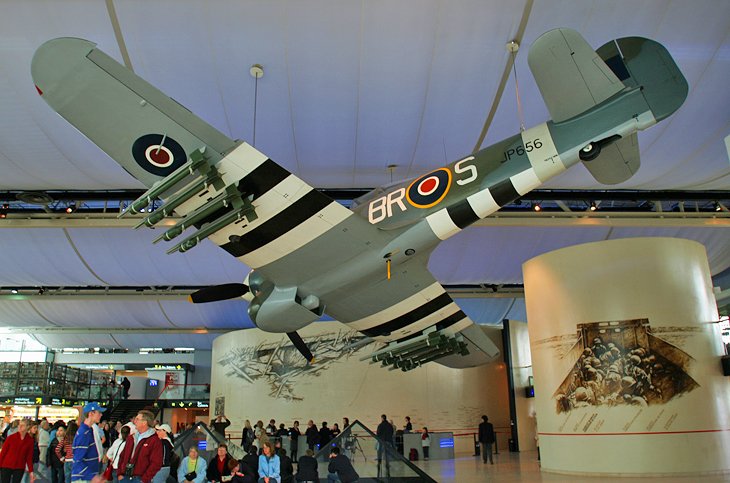
A good starting point for visiting the Normandy beaches is the excellent Caen Memorial Center, where you'll not only get an overview of the battle of Normandy, but a sense of the personal lives of the people who took part in it and were affected by it.
The museum begins its exhibits with the 1920s and the beginning of World War II in the aftermath of the First World War, examining the origins of war and the rocky path to peace, and carries the story though the uneasy Cold War years, putting World War II into its historical context.
War exhibits look at military personnel from both the allied and German armies, with intimate glimpses of their lives through letters and personal accounts. Special emphasis is on the Battle of Normandy. An excellent 19-minute film documents this battle with original historic footage.
Address: Le Mémorial de Caen, Esplanade Général Eisenhower, Caen
Official site: http://normandy.memorial-caen.com
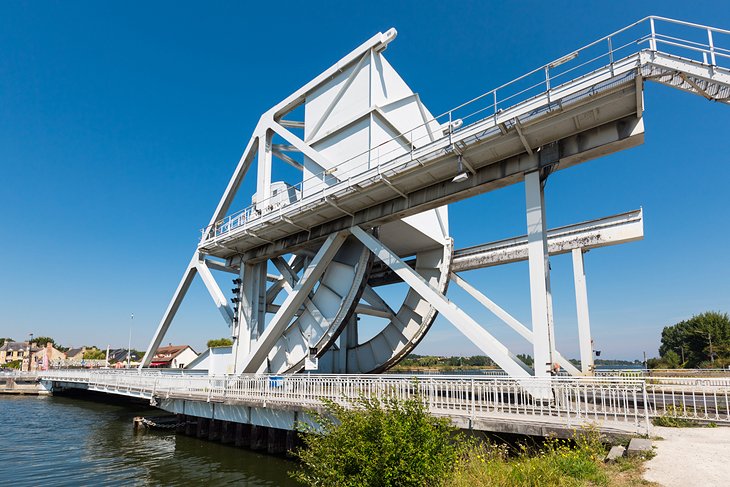
At 10 minutes past midnight on June 6, the first parachutist landed just east of Ouistreham and at 12:20am, six gliders crash-landed beside the Caen Canal with 45 men. Subsequent landings dropped a total of 6,000 men of the British 6th Airborne Division with supplies and weapons.
Their mission was to seize and hold the bridge over the canal to prevent German land reinforcements from reaching the assault target area, and at the same time keeping the bridge open and intact for allied forces to move eastward.
The current bridge looks very much like the original, which you can see - and cross - at the Pegasus Bridge Museum , on the Bénouville side of the canal, where there is also a full-size replica of a Horsa Glider and a large section of one of the originals used in the landing. Café Gondrée, the first house in France to be liberated, on the Ouistreham side of the canal, is now a tearoom and shop.
A short drive east of Pegasus Bridge in Merville-Franceville and guarding the coast at the eastern flank of the D-Day invasion, the Merville Battery consisted of multiple bunkers that had withstood repeated allied air attacks. The position was finally taken by British paratroopers, but the structures remained intact. You can tour the bunkers and become immersed in the attack in a sound-and-light show that includes realistic details such as smoke.
Address: Avenue du Major Howard, Ranville
Official site: www.memorial-pegasus.org
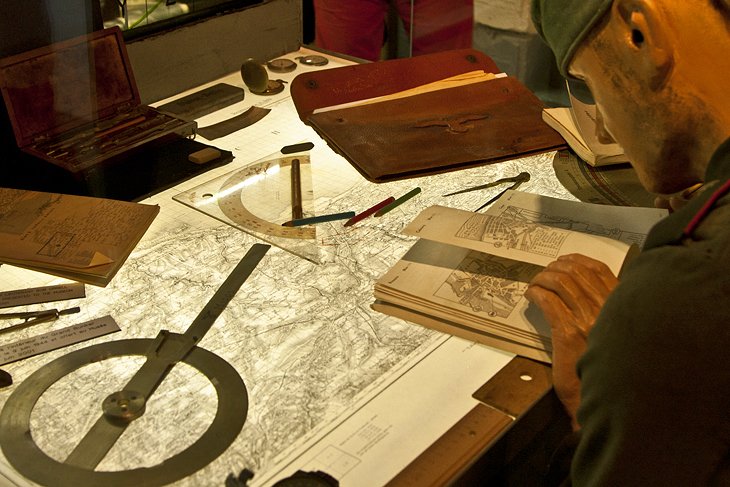
The easternmost D-Day landing beach is at Riva-Bella, part of Ouistreham and a short walk from the terminal where today ferries arrive from Portsmouth, England. Ouistreham has a small fishing harbor but is also home to the entrance of the Caen Canal, the outlet of the River Orne and the Port of Caen. The Atlantic Wall was especially strong here, with armed bunkers every 100 yards and beaches strewn with mines and tank traps.
The British and a contingent of Free French landed at 7:30am on June 6, and by 9:30, the Casino, seat of the German command force, had been cleared by Free French commandos. Still in operation was the German fire control post, a 52-foot-high concrete bunker that was not taken until June 9.
This bunker is now one of the most authentic museums of the entire coast, recreating in exact detail the appearance and work of each room in its six floors, including the observation post with its powerful range-finder and a 360-degree view over Sword Beach. Using actual equipment and furnishings, the bunker details the daily life of the soldiers stationed here, as they directed the fire from batteries covering the entrance of the Orne and the canal. Additional exhibits detail the building, extent, and camouflage of the Atlantic Wall.
On the beach, which is today a lively recreational beach with pony rides, go-carts, and rows of bright umbrellas, are monuments recalling D-Day, and near the rebuilt Casino, the No 4 Commando Museum tells the story of the only French forces that took part in the ground operations in D-Day landings.
Address: Avenue du 6 Juin, Ouistreham
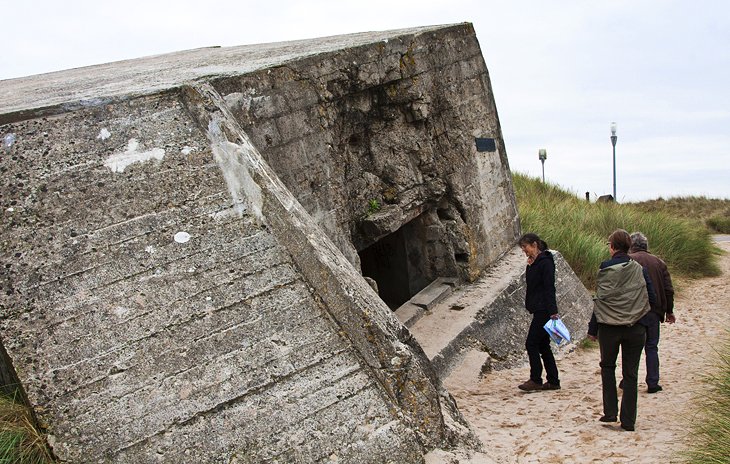
The coast of Courseulles-sur-Mer and its adjacent towns was unsuited to a solid frontal landing, so Canadian marine commandos landed first to attack and disable German positions. More Canadian forces landed with equipment and advanced inland to take an important German airfield. Sherman tanks came ashore at Courseulles-sur-Mer and by 5pm, the town was liberated.
Of particular interest to Canadian visitors, the Centre Juno Beach is a family-friendly series of exhibits, hands-on presentations, and films looking at the Canadian preparations and contributions to the allied effort through personal stories and interactive experiences. This center offers a unique Canadian perspective and includes an exhibit on Canada today.
From April through October, guides lead tours of remains of the Atlantic Wall, exploring its bunkers and the tunnels leading to the underground command post. You can see damaged bunkers on the beach independently.
At the western end of beach, look for the double-armed Cross of Lorraine, marking the site where Charles de Gaulle made a brief return to France on June 14, 1944, after his self-imposed exile in England upon the fall of France in 1940. At the other end of town, a Sherman Bold tank recovered in 1970 from more than a mile out at sea stands as a monument to the Canadian Hussars.
Address: Voie des Francais Libres, Courseulles-sur-Mer
Official site: www.junobeach.org
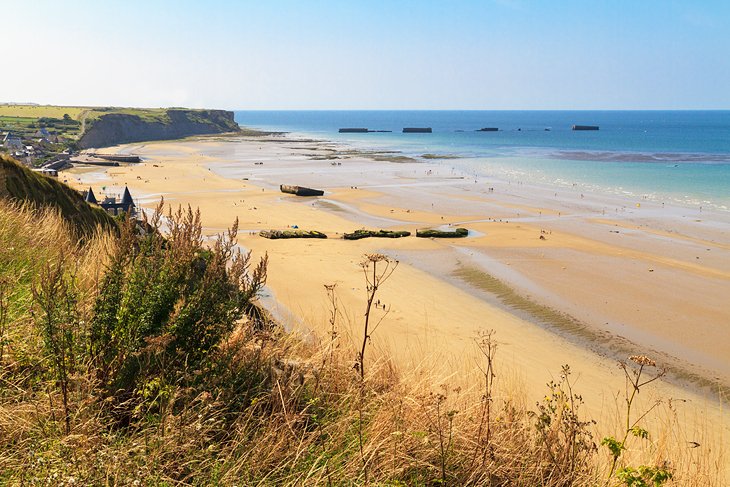
The lack of large harbors along this stretch of the Normandy coast was both a plus and a minus to the allied forces. While it allowed them the element of surprise because the Germans thought they wouldn't try a massive landing here, it also created the problem of how to get men and heavy equipment ashore on soft sand beaches and marshes that were both open and heavily defended.
The allied answer was to construct a massive artificial port. Huge concrete caissons were towed across the channel and sunk offshore to create a breakwater and a harbor inside its protection, where long floating roads were assembled to offload tanks and equipment. Remains of this Mulberry Harbor can be seen today at Arromanches, where British forces landed under brutal fire.
Despite heavy casualties, by 4pm on June 6, British tanks began rolling ashore here. Although one of the two Mulberry Harbors was destroyed in a storm, by the time it was replaced by the liberation of the Port of Cherbourg, more than 500,000 tons of equipment and supplies had entered this artificial port.
The D-Day Museum not only pays homage to the British forces and the other allies in the Battle of Normandy, but it illustrates the operation of the Mulberry Harbor through working scale models, complete with animated details such as rising and falling tides. Just west of Arromanches, at Longues-sur-Mer, you can visit sections of the Atlantic Wall, including a battery with a German range-finding post and four casemates, each of which housed a 150-mm artillery piece.
Address: Place du 6 Juin, Arromanches
Official site: http://www.musee-arromanches.fr
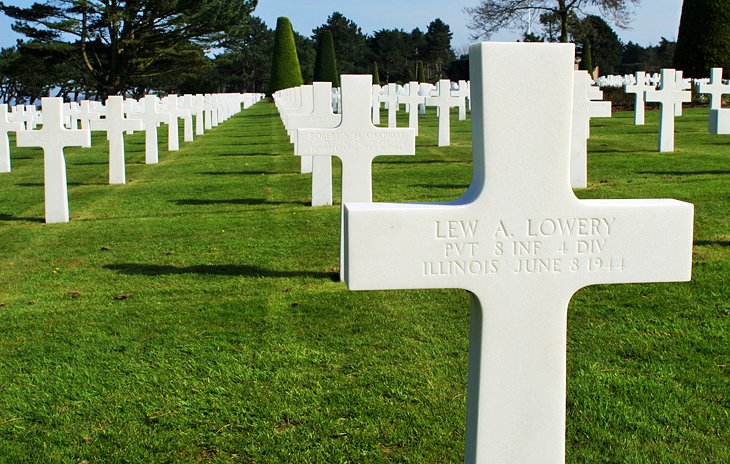
The landing at Omaha Beach went badly from the start and by the end of June 6, the Americans had lost 3,000 men, with as many more wounded or missing. But they had secured a narrow corridor to get supplies and equipment ashore.
It is fitting that this scene of so many casualties should be the location of the American Cemetery, where 9,386 graves are marked with perfectly aligned white marble headstones. You can also visit the Memorial, the Garden of the Missing, and a viewing platform that overlooks Omaha Beach.
In the Overlord Museum, 10,000 artifacts including vehicles, tanks, and cannons are used to create realistic life-sized replicas of scenes from the D-Day landings and the subsequent operations culminating in the liberation of Paris.
Giving it a human dimension are accounts, stories, impressions, and objects from those events. Sound and light effects add to the authentic equipment and artifacts, making the reconstructed scenes even more realistic. The museum is well-suited for younger visitors, with exhibits and programs that make history understandable.
Address: Rond-point d'accès du Cimetière Américain, Lotissement Omaha Center, Colleville-sur-Mer
Official site: www.overlordmuseum.com
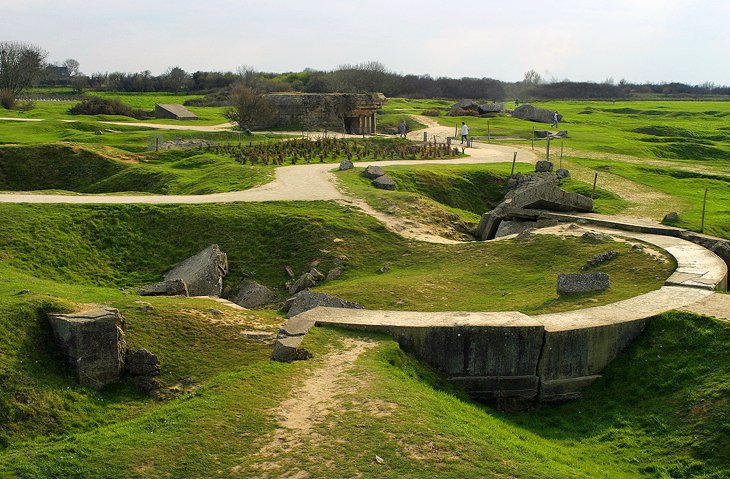
Although the magnitude of the invasion, the difficulty of the highly defended terrain, and its tremendous cost in human lives will strike you again and again as you tour these beaches, one of the most gripping relics of D-Day is atop the soaring cliffs of Pointe du Hoc. The entire clifftop is pocked with bomb craters, and huge batteries lie askew where they were exploded off their foundations.
Stand at the top of the rough 100-foot cliffs and imagine the US Rangers who scaled them after landing on the narrow beach below at 6:40am on June 6. The scene has been left as it was and is an official war grave for the men who still lie beneath the ruins.
This point was important because it was the highest land between Omaha and Utah beaches and could thus fire upon both of them. In fact, its long-range guns had been moved elsewhere, but the allies had no way of knowing this.
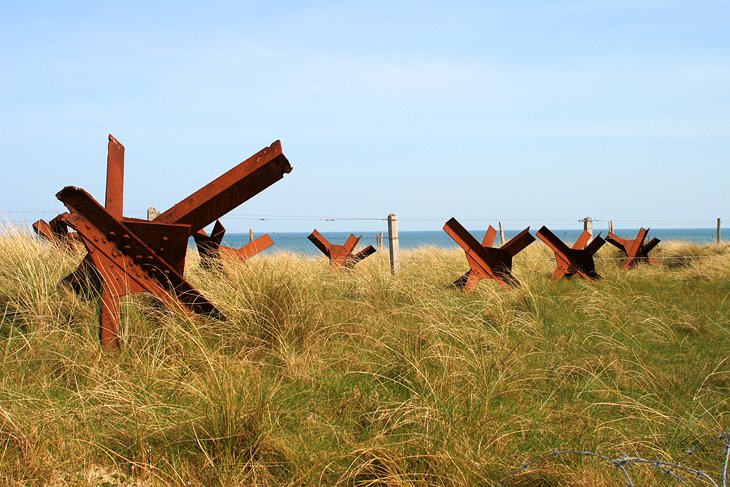
All things are relative, and measured by the tremendous casualties elsewhere, Utah Beach was almost easy. By the time the 4th Infantry hit the beach at 6:30am, the tide was low, and bombers and artillery from ships offshore had already battered the German coastal defenses and disabled much of their firepower.
This reduction in enemy fire secured their landing during low tide, creating conditions that made it possible to safely land all but two tanks by revealing the placements of "Czech Hedgehogs," "Rommel's Asparagus," and other landing obstacles, some of which you can still see in the dunes. By 1pm, the American 4th Infantry had joined up with the airborne units inland to secure the area.
A former bunker of the Atlantic Wall has been incorporated into the Museum of the Landings, where you can see one of only six remaining original B26 Marauder bombers and an LVT-2 Water Buffalo, the landing craft used to offload supplies from the cargo ships off the coast.
The exhibits are especially well designed to illustrate not just the operations at Utah Beach, but the entire Operation Overlord, and some pieces of equipment are accompanied by videos demonstrating how they worked. Among the several monuments here is Milestone 00, marking the beginning of Liberty Road , and commemorating the route of Allied forces from the Normandy beaches to Bastogne, Belgium.
The nearby Crisbecq Battery Museum is a semi-open-air museum set in 21 German bunkers that were part of the Atlantic Wall guarding Utah Beach. They were (and are) linked by a network of trenches, and some of the bunkers contain dioramas showing life in the battery.
Address: Plage de la Madeleine, Sainte Marie du Mont
Official site: http://www.utah-beach.com
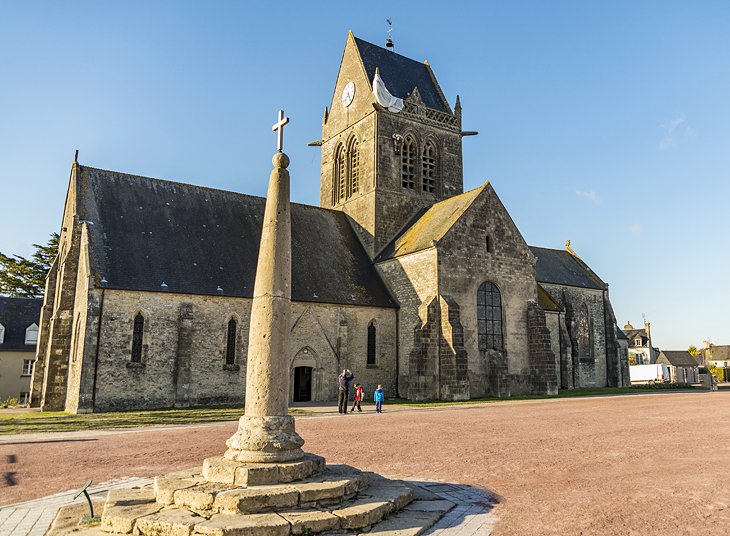
Inland from Utah Beach, and crucial to the success of the entire operation, paratroopers of the 82nd and 101st Airborne Division began the invasion well before dawn in and around the town of Sainte-Mère-Église. Like their British counterparts at the eastern edge of the invasion target, their job was to establish a western line to protect the liberated territory from being retaken by German ground forces.
The dramatic story of their dangerous mission is well told in the Airborne Museum, which re-creates some of the experiences of both the landing assault and the townspeople, as Sainte-Mère-Église became the first town in Normandy to be liberated. It was 4:30am when the American flag was raised over Sainte-Mère-Église, 15 minutes before the capture of the Merville Battery securing both ends of the landing zone.
The town's church still re-creates the scene villagers awoke to, with paratrooper John Steele suspended from his parachute on the church roof. Steele's medals, memorabilia from several generals and others who took part in the operation, and a C-47 Dakota used in the drops add to the collection of original artifacts used to immerse visitors in the reality of this historic assault that set Operation Overlord in motion.
Address: 14 rue Eisenhower, Sainte-Mère-Église
Official site: www.airborne-museum.org
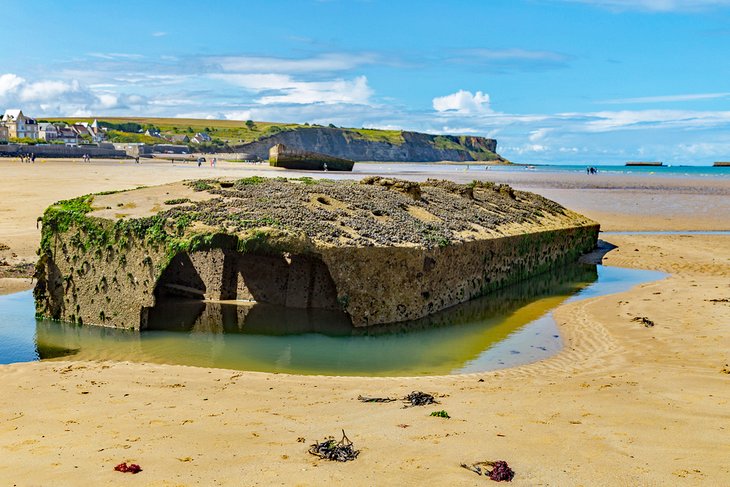
East of Arromanches, a series of beaches code-named Gold Beach stretches for five miles toward Courseulles-sur-Mer and Juno Beach. It was one of the hardest-won beaches, captured late in the afternoon of June 6 by units of the British 50th Infantry Division. Joining with the Canadian landing forces to the east, the combined forces were able to liberate Bayeux the following day.
Overlooking Gold Beach, just outside the village of Ver-sur-Mer, the British Normandy Memorial was dedicated on June 6, 2021. It records the names of all those men and women under British command who lost their lives in Normandy between June 6 and August 31, 1944. Dioramas and other exhibits at the Musée America Gold Beach in Ver-sur-Mer detail the landing and fight to control the beaches.
Address: 2 place de l'Amiral Byrd, Ver-sur-Mer, Normandy
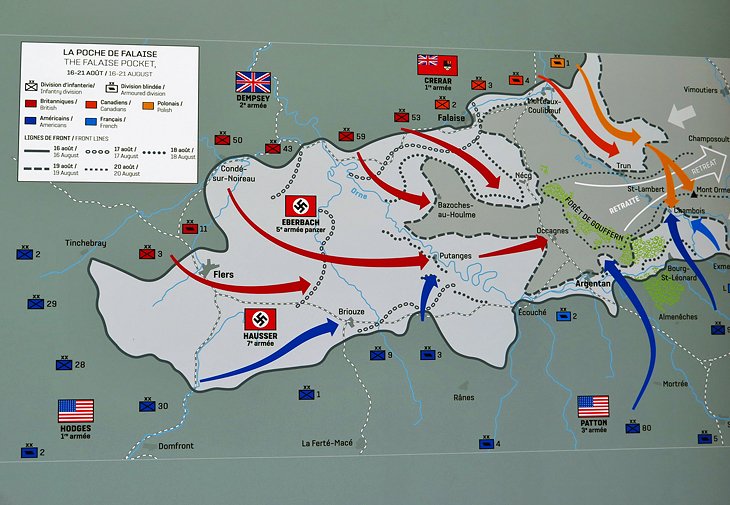
South of Caen and some distance from the landing beaches, Falaise had the misfortune of finding itself in the middle of a key Allied maneuver to trap retreating German troops in the weeks following D-Day. And it is the site of the newest museum of World War II, opened in 2016 to explore the experience of civilians during the German occupation, under the Vichy government, during the allied attacks, and after liberation.
The modern museum uses video interviews with people who lived through these events, along with photographs and often touching artifacts showing such things as propaganda for school children and chronicling the fates of resistance fighters and Jewish families. All audio and signage is also in English. A sound theater recreates scenes from the bombing of Falaise, its glass floor hovering over wartime ruins uncovered during the renovation of the building.
The museum also details the significance of the " Falaise Pocket, " where the last remaining German forces stood between the allied troops and Paris. Despite his armies being almost surrounded near Falaise and badly depleted, Hitler would not allow his commanders to withdraw through the slim corridor they still controlled.
Instead, he ordered them to attempt a counter-offensive. It failed, and their escape route was closed. Two days later, allied troops liberated Paris. The Battle of the Falaise Pocket was the final and decisive conclusion of the Battle of Normandy.
The museum is adjacent to the magnificent Falaise Castle , birthplace of William the Conqueror, well worth seeing while you're in Falaise.
Address: 12 Place Guillaume le Conquérant, Falaise
Official site: http://www.memorial-falaise.com
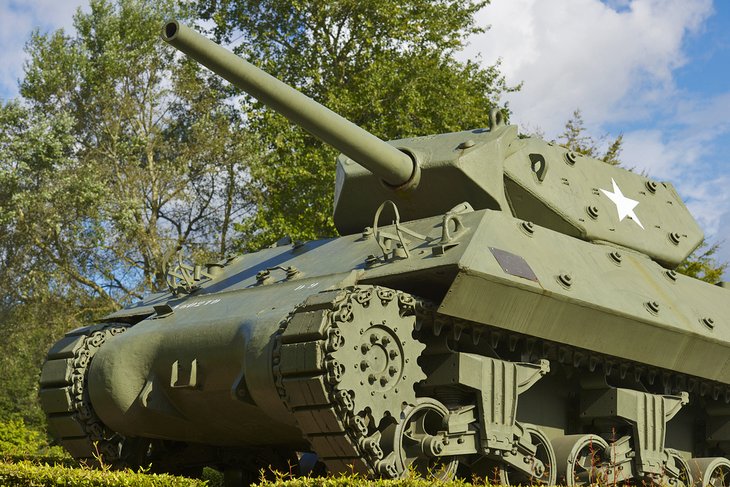
Recounting the Normandy Campaign from the Allied troop preparations to D-Day on June 6th, 1944 and the liberation of Paris on August 25 th , the 2,300-square-meter exhibition includes military equipment used on the landing beaches, as well as an excellent film "Normandy 44, a Decisive Victory in the West." This film, combined with the exhibits, puts Normandy's place in deciding the outcome of the war in the perspective of operations elsewhere, but deals mainly with Normandy's pivotal role.
While in Bayeux, be sure to see its best-known tourist attraction, the UNESCO inscribed Bayeux Tapestry , an 11th-century masterpiece of medieval embroidery depicting the story of the conquest of England in 1066 by William the Conqueror.
Address: Boulevard Fabian Ware, Bayeux
- Planning Your Trip : The main sites are between Pegasus Bridge, in Bénouville to the east, and Sainte-Mère-Église on the western end, and it makes sense to visit them in geographical order. The coastal road connects a whole series of beach towns, or if you are just visiting the main sights, you can reach them from a base in either Caen or Bayeux.
- Timing Your Visit : How long you should stay depends on how much time you plan to spend in various museums. While some of the material in the museums repeats, each one focuses on a particular landing site, event, invasion force, or part of the strategy. Be aware that some of the smaller museums close in the winter, usually from November through April. Most of these sights are today lively beach towns, with plenty of other things to do, especially in the summer.
- Visiting with Children and Teens : While young eyes may quickly glaze over at the details of the landings, a few of the more visual sights will bring the history to life. Begin at the Caen Memorial Center, where the film sets the stage for what they'll see later. Other sites with good visual appeal are Pégasus Bridge, where there's a full-size replica of a glider and the Atlantic Wall Museum, housed in a real 52-foot-high concrete bunker, showing the daily life and work of German soldiers as they directed the German fire. The Centre Juno Beach has hands-on exhibits and films, and kids can climb through ruined bunkers on the beach.
More Related Articles on PlanetWare.com
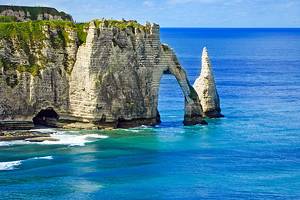
More Places to Visit in Normandy: While visiting the D-Day landing beaches, you are sure to be struck by the lovely countryside and coastline, which you can explore easily with our page on the top-rated attractions and places to visit in Normandy . You will also find our page on the top tourist attractions in Rouen and easy day trips handy in planning your trip, as well as our insider's guide to visiting Mont Saint Michel , on the western coast of Normandy.
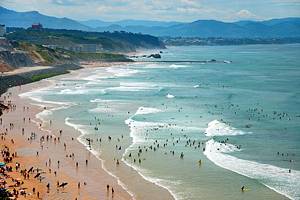
Places to Visit in France: To see more of the nearby tourist attractions of France , you can use our page on places to visit in Brittany . Like Normandy, Brittany is where you'll find some of the most beautiful beaches in France.

More on France

Top Cities and D-Day Beaches in Normandy
:max_bytes(150000):strip_icc():format(webp)/james-globe-56a3a1c05f9b58b7d0d2e4e5.jpg)
We independently evaluate all recommended products and services. If you click on links we provide, we may receive compensation. Learn more .
Normandy is a region of Northern France just west of Paris that's famous for its role in World War II as well as a number of other significant events throughout its history. However, its rugged coastline on the English Channel is also home to a number of picturesque small towns and villages perfect for an escape from the congestion of Paris, including Caen, Le Havre , and Rouen.
Among other top places to visit in Normandy are Mont Saint Michel —an island topped by a medieval monastery just off the coast—Omaha Beach, the site of one of the D-Day landings of Allied reinforcements, and Giverny , which is home to the gardens that inspired Monet.
Rich in culture and home to a number of historically significant sites, Normandy is a great destination for World War II buffs, beach enthusiasts, and tourists looking for a great event any time of year.
The Normandy Coastline: D-Day Beaches and Popular Towns
Normandy is perhaps most famous for the events that took place on five of its beaches on June 6, 1944—known around the world as D-Day . It was on this day that the Allied Forces carried out the largest seaborne invasion in history to seize control of France's crucial ports from the Axis Powers during World War II. The five landing sites of D-Day in Normandy are:
- Utah Beach : Westernmost beach of the five landing areas during the Normandy invasion where you can visit the Memorial de la Liberté Retrouvée (Liberation Museum) or tour Tatihou Island and Vauban Fort
- Omaha Beach: A little further east near the commune of Vierville-sur-Mer, Omaha was another beach invaded by Allied forces during WWII and is now home to a number of museums and memorials
- Gold Beach: The most central beach of the five invaded during WWII, Gold is located between Port-en-Bessin and La Rivière near the cities of Asnelles and Ver-sur-Mer
- Juno Beach: This beach spans from the border of Gold Beach in Courseulles to Saint-Aubin-sur-Mer, just west of the British beach Sword, and is home to the June Beach Centre, which is dedicated to the Canadian Army units that landed in Normandy during WWII
- Sword Beach: The easternmost of D-Day invasion beaches found just west of the city of Ouistreham, which is home to Le Grand Bunker, a museum dedicated to WWII artifacts that once served as a base for German Nazis
However, the Normandy Coastline—known as Côte Fleurie—is also a great destination for tourists of all types thanks to its picturesque villages, seaside resorts, and inspirational settings. Be sure to check out these popular destinations along the coast:
- Honfleur : A quaint artists' village that many impressionist painters visited to create art and find inspiration
- Deauville: A popular seaside resort with a casino that was originally established in the 1800s and has become one of the best destinations in northern France for beachgoing
- Trouville: This picturesque fishing port has a daily fish market and became a popular resort town about 100 years ago
- Cabourg: A Belle Epoque Edwardian seaside resort frequented by writers like Proust and Dumas
- Cherbourg: Once a little fishing village but now sports a large historic port; the Liberation Museum is nearby
- Granville: Another seaside resort and commercial fishing village, but everyone comes here for the Christian Dior Museum as well as Haute Ville , the high town, for picturesque views
Normandy's Top Cities and Towns
Inland from the coast, Normandy opens up to rolling hills dotted with quaint villages and bustling cities. Whether you choose an artsy and scenic town like Bayeux or you'd rather take a stroll through history in cities Caen or Lisieux, Normandy has something to offer travelers of every type:
- Rouen : An artists' city along the River Seine where Joan of Arc was burned at the stake during the Hundred Years' War; it is also home to a museum dedicated to famous French writer Gustave Flaubert
- Caen : Home to a William the Conqueror castle and two abbeys, but many come for the Peace Museum, Le Mémorial de Caen , which offers tours of some of the D-Day Beaches, and fewer come for les tripes à la mode de Caen , a beef stew made famous here
- Bayeux: The birthplace and home of the Bayeux Tapestry, which depicts over 50 scenes that took place in the year 1066, and many visitors enjoy the city's museums that are dedicated to the war and the artisan crafts made in the region throughout history
- Giverny : French painter Claude Monet's home for many years and the closest Normandy town to Paris
- Domfront: A compelling medieval town that features an evocative 11th century ruined castle on a hill and lots of half-timbered houses; it's a good place to stay if you like very small towns as there are fewer than 4000 inhabitants here
- Bagnoles: Famous for its hydrotherapeutic baths that date back to the medieval times as well as some fine Art Deco architecture from the roaring 20s, when Bagnoles came into its own as a tourist spa town
- Camembert: A small village famous for Camembert cheese dotted with half-timbered houses; this is a great destination for a picnic by the Sienne River Gawk at the half-timbered houses and picnic by the river with your Camembert and bread
- Evreux: Known for its massive Cathedral of Our Lady of Évreux found in the center of town
- Lisieux : Dates back over two thousand years and is known for its numerous religious buildings, especially those dedicated to Therese Martin as well as Le Domaine St-Hippolyte, where you can taste Normandy specialty dishes
- Le Havre: The largest city in the Haute-Normandie region and the second busiest port after Marseilles; it's also home to the Abbey of Graville, Musée des Beaux-Arts André Malraux, Musée du Vieux Havre, the Shipowner Home, and the Japanese Gardens
Getting to Normandy's Cities and Beaches
The closest major city outside of Normandy is Paris, and there are several ways you can access this northern region during your trip to France. While it's generally recommended that you rent a car to visit the D-Day memorials along the coast, there are also several transportation options to get around the countryside without a car.
You can take the train from Paris Saint-Lazare station to Vernon, the first stop in Normandy and the closest station to Giverny, which takes about 45 minutes and runs along the Seine River. To get to the D-Day beaches, stay on the train to Caen where you can rent a car or take a bus service to the coast. Caen is about 150 miles from Paris.
Alternatively, if you don't want to worry about navigating public transit in Normandy or driving a rental car, you can take a coach tour out of Paris or take the train to Caen to join the D-Day Tour, which includes tickets to the Peace Museum and transportation to and from the train station as well as a five-hour guided tour of the Anglo-American beachheads.
Guide to the Normandy Region of France
Best Beaches to Visit in Normandy
North Coast of France: The Ultimate Road Trip From Dieppe to Calais
Where to Stay Near the D-Day Landing Beaches in Normandy
One Week in France: The Ultimate Itinerary
France Guide: Planning Your Trip
Top Normandy D-Day Landing Beaches and World War II Sites
Caen: Planning Your Trip
The Top 15 UNESCO World Heritage Sites in France
The Best Christmas Markets in France
How to Travel From Paris to Deauville by Train, Car, and Bus
Top 20 Most Popular French Cities for International Visitors
Le Havre: Planning Your Trip
The 12 Best Day Trips From Paris
The Best Beaches and Coastlines in France
Brittany Region of France
- Skip to main content
- Skip to primary sidebar
- Skip to footer

8 Top Things to See at the Normandy D-Day Beaches in 2024
Debra Thimmesch Last Updated: September 26, 2023
D-Day, June 6, 1944, was one of the most pivotal days in world history. That day, thousands of Allied troops began their liberation of “the oppressed peoples of Europe,” as then-General Dwight D. Eisenhower put it. Today, you can explore this important place in history from Omaha and Utah Beaches to the American Cemetery and Point du Hoc. In this article, I’ll tell you about the top must-see sites at the Normandy D-Day beaches.
Pro Tip: Planning what to do on your trip to Paris? Bookmark this post in your browser so you can easily find it when you’re in the city. Check out our guide to Paris for more planning resources, our top Normandy tours for a memorable trip, and if a Normandy tour is worth it .
What You Have to See at the Normandy D-Day Beaches
“Your task will not be an easy one,” Eisenhower wrote to the Allied troops. Those words were part of his now-famous official order for the June 6, 1944, D-Day invasion. Indeed, it was not easy. In fact, according to the US Department of Defense, 4,700 of the 35,000 soldiers who first went ashore that day were wounded, killed, or declared missing.
The huge D-Day operation included the invasion and the push through Normandy then southeast to Paris . The invasion architects who selected Normandy as the landing zone gave it the codename Operation Overlord.
Gaining a strategic foothold in northwest Europe was essential to turning the tides in the war. Allied troops landing in Normandy were extremely vulnerable. The Germans had established positions, including bunkers, along the coast. They had also occupied cities such as Caen, the capital of Normandy.
Eisenhower warned the troops , “Your enemy is well-trained…He will fight savagely.” Therefore, it was up to the Allied forces to liberate the land and the French people. The battle that turned the tides of World War II started in Normandy.
In this article, I will explain why 50 miles of coastline in Normandy—which includes specific areas you can visit—held the key to victory. Here are 8 important sites from the Caen Memorial Museum to La Pointe du Hoc you won’t want to miss.
Not ready to book a tour? Find out if a tour of Normandy’s D-Day beaches are worth it .
8. Caen Memorial Museum
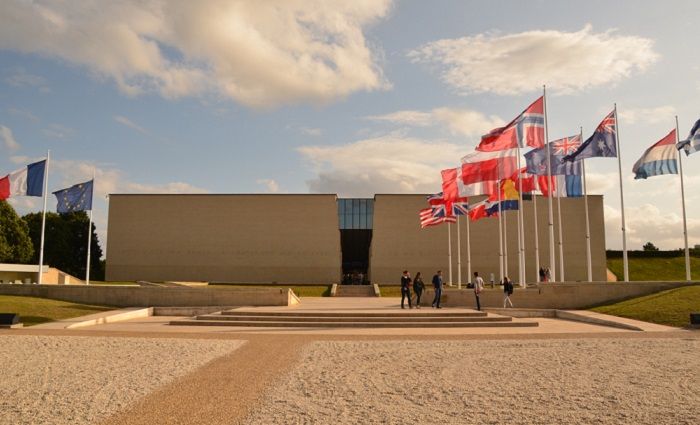
I recommend starting your Normandy D-Day Beaches visit in Caen. Caen is about 10 miles inland from the English Channel. It is the largest city in Normandy and played a crucial role in the war as it has in days past, such as when William the Conqueror once used Caen as his capital. It was heavily bombed by the Germans during World War II, and the city lost numerous historical buildings entirely.
The Caen Memorial Museum provides visitors with a comprehensive picture of the war in this part of France. Different areas of the museum tell different stories, so be sure to allow plenty of time here.
For example, you’ll learn about how civilians coped with the German Occupation. You’ll see objects related to the French Resistance, which was extensive. Finally, you’ll hear the stories of D-Day and the Battle of Normandy. The Caen Memorial Museum is the perfect place to get a full understanding of what you’ll see here at the Normandy D-Day Beaches before you head to Omaha Beach.
Address: Esp. Général Eisenhower, 14050 Caen Cost: starting at €17.50
7. Bayeux Battle of Normandy Museum
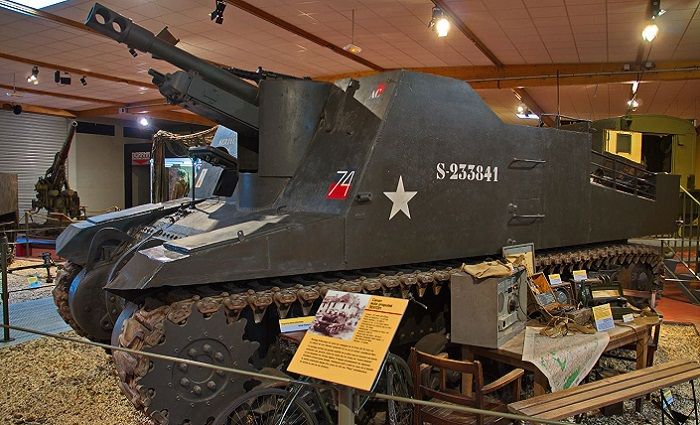
The Memorial Museum of the Battle of Normandy is a top place to see at Normandy. Bayeux is around 20 miles west of Caen on the inland side. This ancient city also hosts the famous Bayeux Tapestry.
Wondering what that is? Well, it’s not a tapestry at all but a famous embroidery that tells the story of the invasion of England by William the Conqueror. Thus, it seems apt that Bayeux would also tell the story of a more recent, historic invasion.
Bayeux’ museum focuses solely on the Battle of Normandy. Part of Operation Overlord, the Battle of Normandy took place over the summer of 1944. After the successful but bloody D-Day invasion, Allied troops pushed southeast across Normandy to the Seine river.
Their goal was to liberate Paris, and according to WWII historian Stephen Ambrose, Paris was liberated on August 25. The Germans retreated across the river to the east on August 30, 1994. That fateful event marked the end of Operation Overlord.
Address: Bd Fabian Ware, 14400 Bayeux Closed: Annually in January Cost: starting at €7.50 (buy in person only)
6. Artificial Harbor at Arromanches
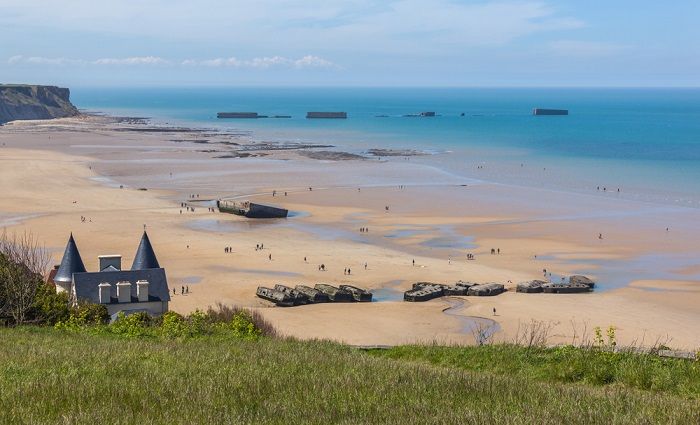
You might wonder how the Allied forces moved their vehicles and cargo across the English Channel and onto the shores of France. A key piece of their success was the genius installation of two portable, temporary harbors.
They named the first harbor at Omaha Beach Mulberry A. Then they built Mulberry B at Arromanches-les-Bains on Gold Beach. Today, you can see remnants of Mulberry B in Arromanches—the very same harbor the Allies used for over 10 months after D-Day. Incredibly, 2.5 million troops and 4 million tons of supplies came through Mulberry B, notes historian Jonathan Falconer.
A 17-minute drive from Bayeux gets you to scenic Arromanches. You have a splendid view of the artificial harbor from above. While you cannot walk on the remaining constructions, at low tide you can get quite near them. If you arrive around lunchtime, I recommend having fresh seafood at Restaurant La Maison du 6 . It’s just a short walk from the main square on Cale Neptune.
Address: 14117 Arromanches-les-Bains Cost: FREE
Not ready to book a tour? Find out how to visit the Normandy D-Day sites .
5. 360 ° Theater at Arromanches
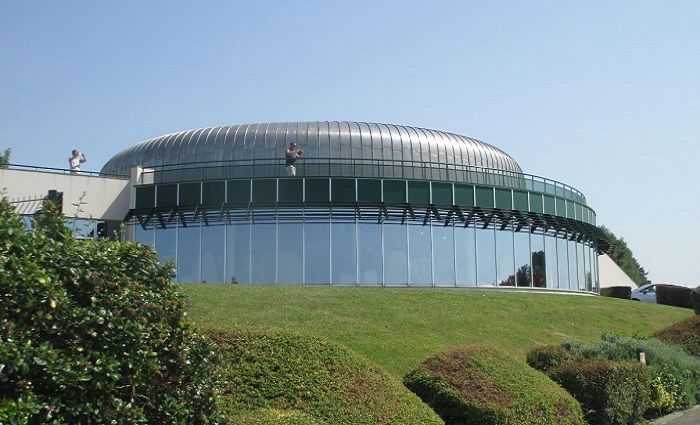
The impressive 360 ° Circular Cinema lies on the ridge above the city. The view of the artificial harbor and beach is stunning. So is the 20-minute film you’ll see in this remarkable theater.
“The 100 Days of the Battle of Normandy” is a breathtaking movie montage of footage from multinational archives. The film begins with the D-Day landings. It is projected on nine different screens, which place you at the center of the action. The experience is intense and deeply moving.
Address: Rue du Calvaire, 14117 Arromanches-les-Bains Cost: starting at €6
4. Omaha Beach
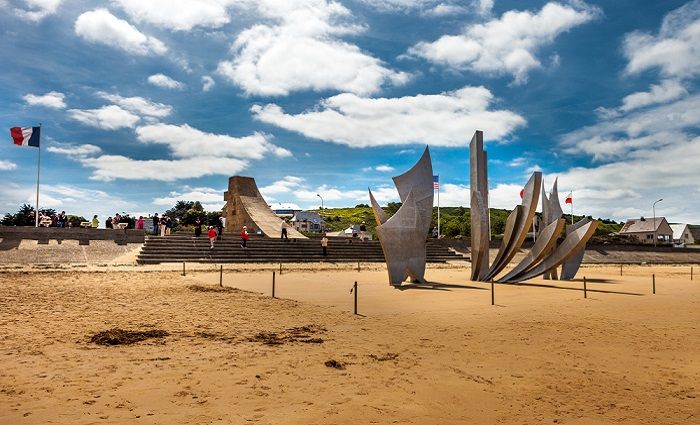
It goes without saying that Omaha Beach can’t be missed at the Normandy beaches. The Allied forces decided to call the beach landing part of the attack Operation Neptune. They designated five beaches as landing zones, and Canadian and British soldiers landed at Juno, Gold, and Sword beaches.
However, the Americans’ entry points were Omaha and Utah beaches, explains Ambrose. That’s just part of why these two beaches are the most recognized by Americans. But it’s also because the most intense fighting on D-Day took place on Omaha Beach .
The Germans had a superior position on the cliffs overlooking the beach, including concrete bunkers. In contrast, the invading troops had to enter the beach from the water—completely exposed. As a result, 2,400 lives were lost, according to the Department of Defense records. However, untold lives were saved by their heroic sacrifices. Today, Omaha Beach is peaceful—there is no sign of the violence and bloodshed of June 6, 1944, and the days that followed.
I recommend taking the D514 road parallel to the sea to get to Omaha Beach where visitors are free to explore. Whereas once you could walk down to the beach from the Normandy American Cemetery above, you must now arrive via Saint-Laurent-sur-Mer. Upon arrival, you’ll see the massive memorial sculpture titled Brave . It looks like gleaming silver swords and tongues of fire.
Address: Av. de la Libération, 14710 Saint-Laurent-sur-Mer Museum Cost: starting at €5
3. Normandy American Cemetery and Memorial
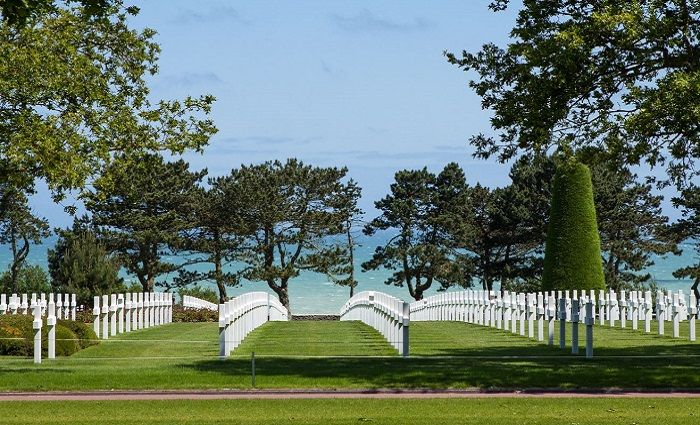
The Normandy American Cemetery and Memorial is located in Colleville-sur-Mer. According to the American Battle Monuments Commission, the Army constructed it on the site of a temporary cemetery for American soldiers in June of 1944. It was the first American cemetery on European soil in World War II. The 172.5 acre cemetery contains the graves of 9,386 dead. Most of the fallen died on D-Day and the days of battle that followed.
The Walls of the Missing on the east side of the memorial enclose a quiet, semicircular garden. The 1,557 names of the missing have been inscribed on those walls, and it’s worth taking some time to see it. Sculptures and large maps describe the military operations that took place in Normandy.
There is a beautiful reflecting pool and a small chapel. To the north, rising above the ocean, a table with a diagram of the beaches is available to help orient visitors. However, the lines of austere white crosses are by far the most poignant aspect of the cemetery and likely what you came to see here at the American Cemetery.
Address: Rte du Cimetiere Americain, 14710 Colleville-sur-Mer Cost: FREE
2. La Pointe du Hoc
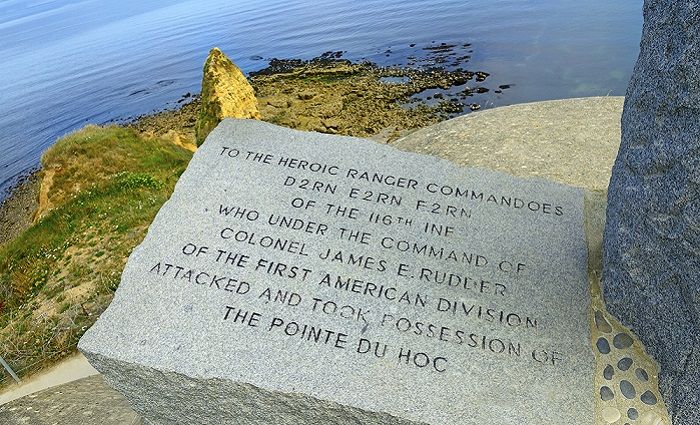
Drive further west of Omaha Beach for 15 minutes and you’ll reach La Pointe du Hoc. As a cliff overlooking the English Channel, Pointe du Hoc was enormously strategic for the Germans.
They had fortified it and built concrete bunkers that seemed completely impregnable. It was their front-row seat for the invasion of Normandy. Thus, the Allies knew that its position would prove a dire threat to the success of the invasion and determined to conquer it at all cost.
The massive battle that took place there left scars that you can still see today. As you stand at Pointe du Hoc, you’ll see huge craters created by the awe-inspiring and deadly assault of the Allied forces. The site is unimaginably eerie. You can walk alongside the craters and even climb down into the bunkers to get a feel for what it might have been like to stand guard there.
Address: 14450 Cricqueville-en-Bessin Cost: FREE
1. Utah Beach and Landing Museum
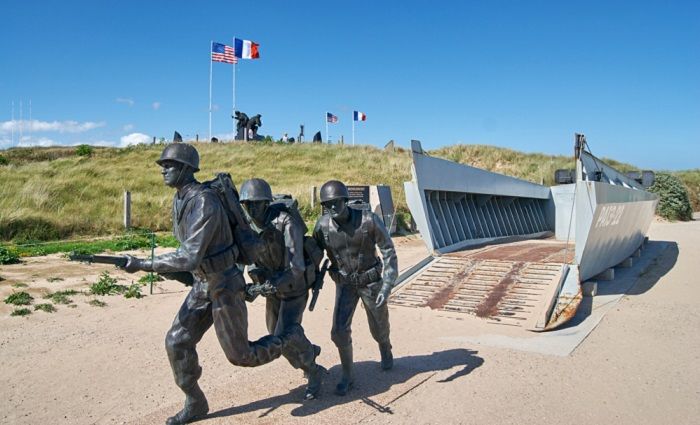
If you drive about 35 or 40 minutes west of Pointe du Hoc, you will reach the Cotentin (or Cherbourg) Peninsula where Utah Beach is located. Utah was the furthest west of the D-Day beaches. The decision to attack this beach was a late addition to the planning stages, notes Ambrose. Yet, it proved to be strategically essential due to its close proximity to the deep water port at Cherbourg.
Utah Beach was the first place the Allies landed on June 6, 1944. According to the Department of Defense, they only lost 197 men of the 23,000 troops who deployed on there. However, they succeeded in taking the beach and establishing a beachhead.
The Musée du Débarquement Utah Beach, or the Utah Beach Landing Museum, is another top place to see when you visit the Normandy D-Day beaches. First, the architecture of the museum integrates with the beach thanks to the huge windows that provide an immense view. You can’t forget where you are.
Second, the museum’s extensive collection of vehicles, equipment, and objects really gives you important context to the tragedy and heroism that occurred here at these sacred sites. Your trip to the Normandy D-Day beaches, museums, and cemeteries will be one to remember.
Address: La Madeleine, 50480 Sainte-Marie-du-Mont Museum Cost: starting at €5
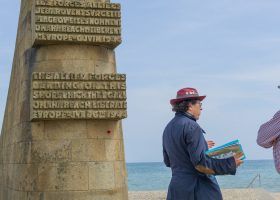
How to Visit Bath
Is it worth visiting the tower of london, where to stay in val d’orcia, tuscany, 8 things to do in florence off the beaten path, 12 astonishing facts you might not know about the medici family.
About Debra Thimmesch
Debra Thimmesch is an art historian, researcher, independent scholar, editor, and visual artist. She mentors undergraduate and graduate students in the history of art and is a published author. Her work has appeared in publications such as The Brooklyn Rail, Art Papers, and Blind Field and a variety of exhibition catalogs. Her BA, MA, and PhD in art history have provided only part of the broader, global view of the history of art that she has acquired through the years. As a world traveler, she considers herself a sort of pilgrim of great art and architecture. As a teacher and tour guide, she has led private tours and student groups to numerous sites in the US, the UK, and Europe.
Reader Interactions
Leave a comment cancel reply.
Your email address will not be published. Required fields are marked *
- Travel Guide
- In The Press
POLICY & TERMS
- Cancellation Policy
- Terms & Conditions
- Privacy Policy

- Skip to main content
- Skip to primary sidebar
- Skip to footer
Dreamer at Heart |
How To Visit The D-Day Beaches In Normandy France
Last Updated: October 31, 2023 By Alison Browne Leave a Comment
How to visit the D-Day Beaches in Normandy France is a question asked by many. Which landing beach should I go to first? How will I get the full experience and understanding of what transpired during the Allied invasion here during World War II on June 6, 1944?
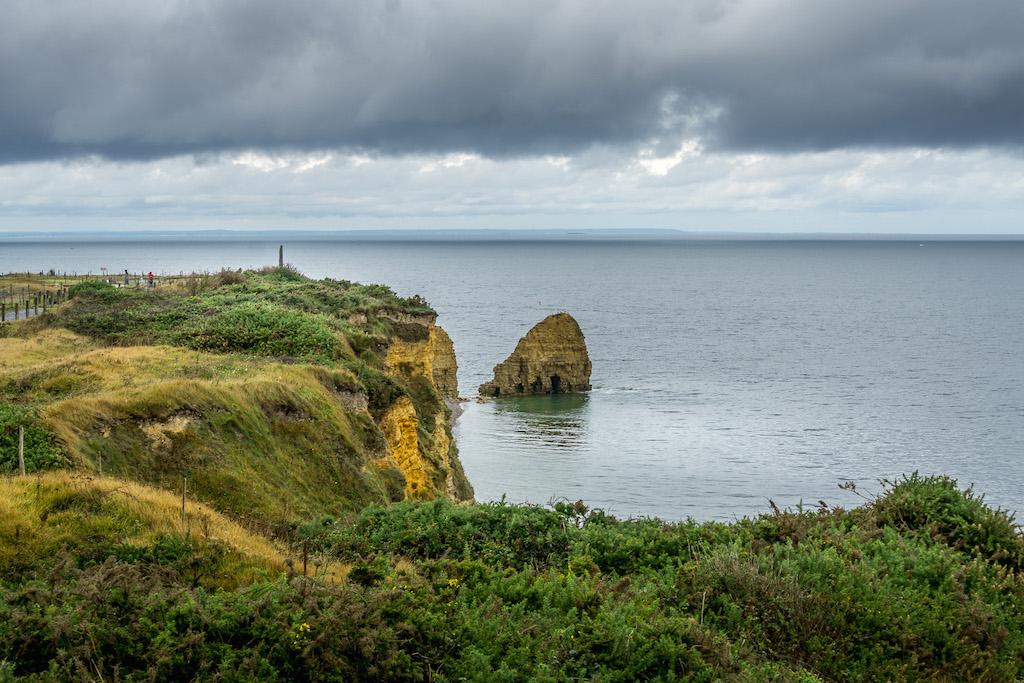
FAQ: How To Visit The D-Day Beaches In Normandy
How to visit the d-day beaches in normandy france: by car.
Although I did not visit the D-Day Beaches in Normandy by car, I know in my traveller’s heart that this is the best way to tour the Normandy beaches, especially if you have plenty of time. This allows you to choose which beaches, memorials, graveyards and monuments to visit. It allows you to go at your own pace and stay longer when you want to. It opens the avenue to visiting small towns that have photographs of the Liberation of France hanging on their doorways and along their streets. Rent a car.
Pro Travel Tip : There are more car rental agencies available in Caen than in Bayeux.
Rent your car in France for the best way to visit the D-Day Beaches.
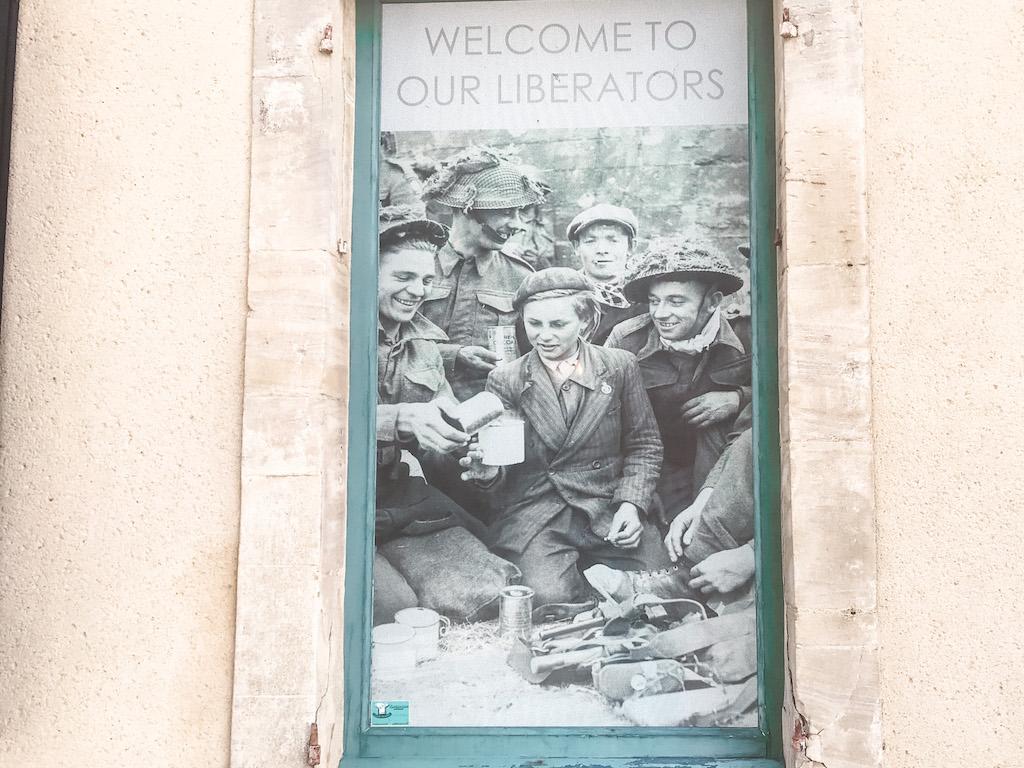
Visiting The D-Day Beaches In Normandy France: By Guided Tour
I arrived in Bayeux after having done some research on car rentals, guided tours, and buses. It was September in the year of COVID-19 and tourism was at an all-time low. I booked a small group tour with Gold Beach Company .
The advantage of taking a tour is, of course, the guide. My guide, Adeline, was a local history buff and knew how to make the tour engaging by telling stories and facts about D-Day and the D-day beaches. The D-Day sites are spread out over an extensive area, making a local guide invaluable in making the most of your time. It was worth every cent.
Pro Travel Tip : Many guided tours pick up in Bayeux.
Suggested Tours:
Normandy Beaches: From Paris – a full-day tour including lunch and From Paris – a full-day small group tou r
From Bayeux – American D-Day sites (4 to 8 hours)
From Bayeux- Canadian D-Day sites
How To Visit The D-Day Beaches In Normandy: By Local Bus
On this trip of mine through Normandy, I relied on the local buses and trains. But, the buses do not run very regularly, especially in the off-season to the D-Day sites. If you have a lot of time, I think it would be doable but you would have to pay very close attention to the schedules.
Where Is The Best Base For Visiting The D-Day Beaches In Normandy?
Both Bayeux (population of approximately 13 000) and Caen (population of approximately 106 000) make excellent bases for visiting the D-Day Beaches. Both cities are accessible by train from Paris. Getting to Bayeux involves one change in Caen. Book my train ticket
Hotels To Stay At In Caen and Bayeux:
Looking for a hotel? Check hotels in Caen here . Check hotels in Bayeux here . I stayed very close to the Bayeux cathedral in this bed and breakfast .
Read More: Here is my full article on what to see in Bayeux France.
Read More: If you are staying in Bayeux, be sure to visit the famous Bayeux Tapestry, almost 1000 years old. Here are some fascinating facts about it .
How Long Is Needed To Visit The D-Day Beaches In Normandy?
This, of course, is a personal preference. I only had one half-day and can honestly admit that it was a perfect introduction but left me wanting more. More stories. A chance to see additional sites. More photographs. A deeper understanding of this monumental event. More reflection time.
Planning Your Trip to Normandy?
Book your airline tickets with my favourite platform, Skyscanner. Normandy is serviced by three international airports: Paris Charles de Gaulle, Paris Orly, and Nantes.
Reserve train tickets to get from Paris to Caen or Bayeux.
A Few Facts About The Invasion Of Normandy
Operation Overlord was the name given to the overall plan for the Allied invasion of Normandy during World War II. It included both land and air components. Its primary objective was to establish a foothold on the continent and begin the liberation of Western Europe from German occupation.
Operation Neptune was specifically the naval component of the invasion. It involved the transportation of troops and supplies across the English Channel to the beaches of Normandy. The success of Operation Neptune was critical to the success of Operation Overlord, as it was the means by which the Allied forces were able to land on the beaches and establish a beachhead.
On June 6, 1944, the Allied Expeditionary Force, led by General Dwight D. Eisenhower, landed along the French coastline of Normandy in what was and still remains the largest seaborne invasion in history.
Critical Invasion Before The D Day Landings
The 82nd Airborne Division was a key unit in the Allied invasion of Normandy during World War II. On the night of June 5, 1944, more than 13,000 paratroopers from the division were dropped behind enemy lines in Normandy, with the objective of securing key bridges and disrupting German defences.
The mission was highly dangerous, as the paratroopers faced intense anti-aircraft fire, and many were dropped far from their intended landing zones. Despite these challenges, the 82nd Airborne Division was able to successfully complete their mission, with some units even capturing key targets such as the town of Sainte-Mère Eglise and La Fière bridge.
The Normandy Landing Beaches
The Allied troops landed at five different beaches along a 50-mile stretch on the Normandy shores. The beaches were all given a code name for the invasion and those names are still used today. The Americans landed at Utah Beach and Omaha Beach. The British landed at Gold Beach and Sword Beach and the Canadians landed at Juno Beach. The Normandy invasion beaches from west to east are Utah, Omaha, Gold, Juno, and Sword.
Read More | How The French Celebrate Armistice Day on November 11 each year.
Pointe du Hoc, Normandy France
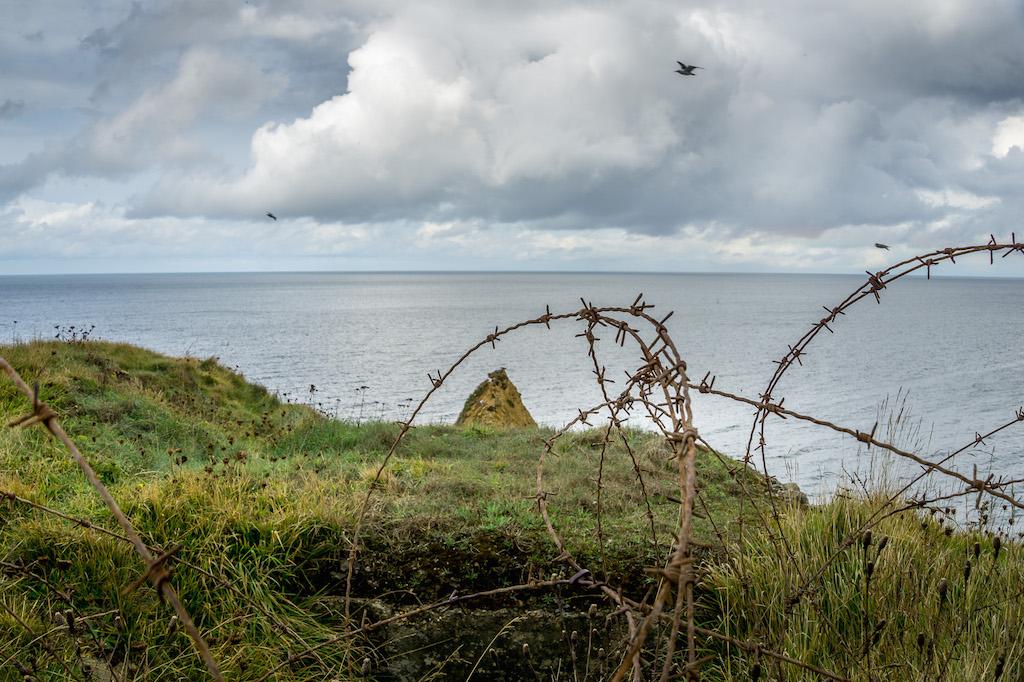
The first stop on our tour of D-Day beaches in Normandy was Pointe du Hoc. The deep craters in the landscape where bombs fell and the remaining German concrete bunkers make an immediate impression.
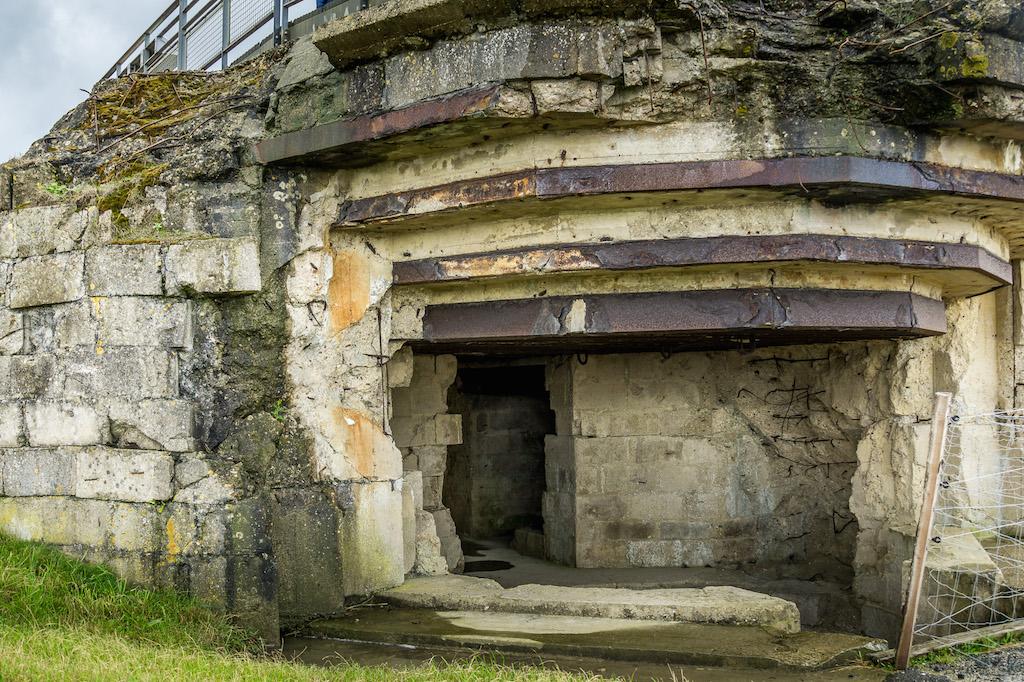
Here, on this bluff jutting into the sea between the D-Day beaches of Utah and Omaha, the 2nd Ranger Battalion soldiers carried out a plan that resulted in a terribly high cost of lives.
Over the course of three days, June 6, 7, and 8 1944, the Commandoes scaled the 100-foot cliffs with a mission to disable the German guns atop that could easily fire on Utah and Omaha Beaches. The Germans had already moved the guns further inland. The Rangers eventually found and destroyed the artillery.
The casualties were high. And after starting with 225 soldiers, only 90 remained standing.
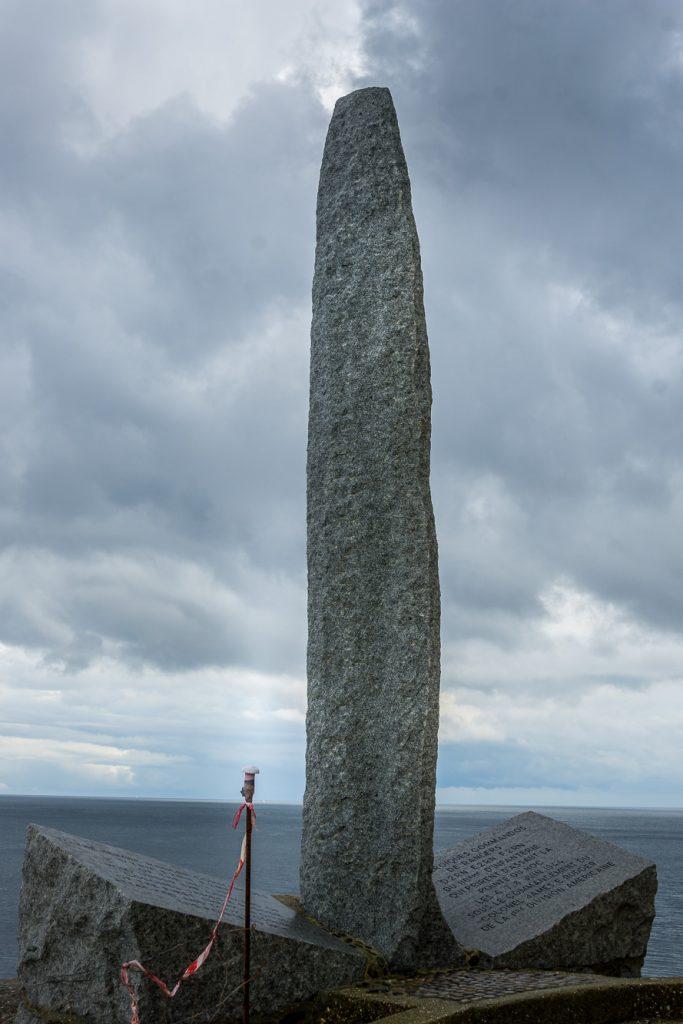
The Memorial at Pointe du Hoc: To the Heroic Rangers Commandoes D2RN E2Rn F2RN of the 46th INF who under the Command of Colonel James E. Rudder of the First American Division attacked and took possession of the Pointe du Hoc.
The United States: Utah Beach And Omaha Beach
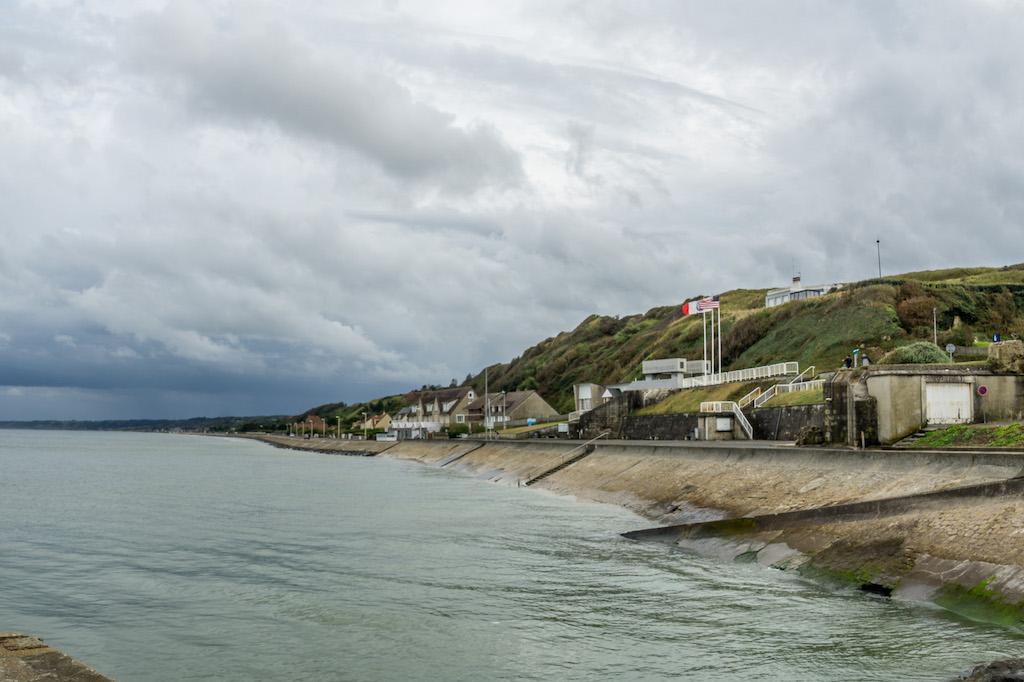
The 4th Infantry Division played a crucial role in the Allied invasion of Normandy during World War II. On June 6, 1944, the division was tasked with landing on Utah Beach. Despite facing heavy resistance from German troops, the 4th Infantry Division was able to secure the beachhead and begin their advance inland. The 4th Infantry Division’s actions at Utah Beach were a significant turning point in the war.
Of the five D-Day Beaches in Normandy, Omaha Beach was the bloodiest of all the landings. Standing on the beach under the bluffs it is hard to fully imagine what went on that Tuesday morning so many years ago.
I try to feel what it would be like to land in the water with my gun and hear German guns shooting down all around. I try to understand the sensation of my fellow soldiers dropping beside me, in the water, on the shore.
Looking up at the cliffs, I imagine a hail of German bullets, bombs and artillery raining down on the young American soldiers.
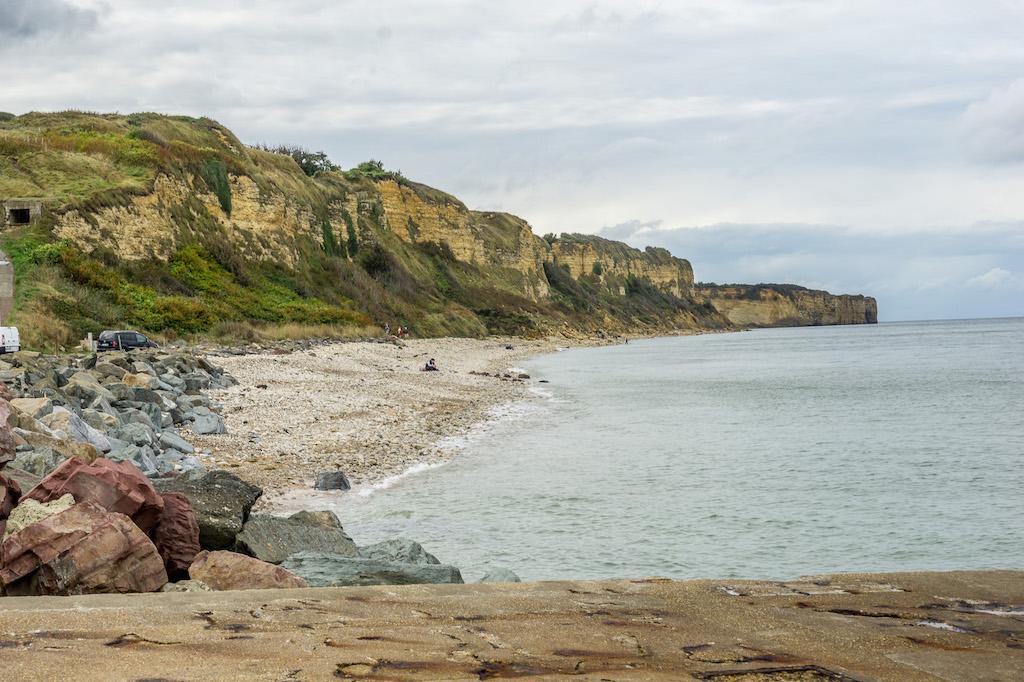
I know what I sense is a mere fraction of the reality.
But it isn’t hard to be in awe of the courage and dedication that each young soldier brought to the battlefield. It isn’t hard to imagine the fear and bravado all entangled. It isn’t hard to imagine the sea turning bright red. My heart stands still.
D-Day Beaches Itinerary: The Juno Beach Centre honours the 45 000 Canadians who lost their lives in WWII. Located in the small town of Courseulles-sur-Mer, it is a War Museum and Cultural Centre.
Visiting D-Day Beaches In Normandy: Les Braves
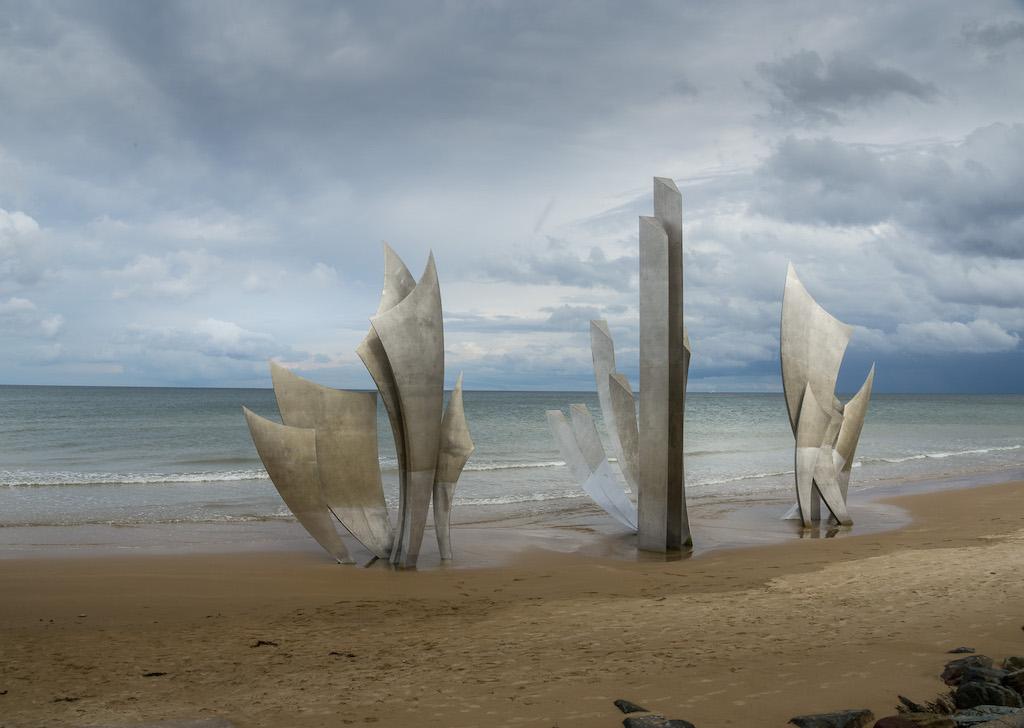
Our van was scooting past this memorial which is a little further down Omaha beach than where we had initially stopped. I had to ask the guide to stop.
As this monument, Les Braves rises from the sea, its impact is powerful. Standing on the shore where thousands of soldiers arrived to meet their death and the seas were cherry red with their blood, this monument demands something of the visitor. It is not a drive-by, nor a five-minute stop to check off the list. It requires one to stand in silence against the crashing waves and imagine what transpired here. It’s a time to let gratitude flow through you.
This Omaha Beach Memorial, created by Anilore Banon is called Les Braves. He is quoted as saying “I created this sculpture to honour the courage of these men: Sons, husbands, and fathers who endangered and often sacrificed their lives in the hope of freeing the French people.”
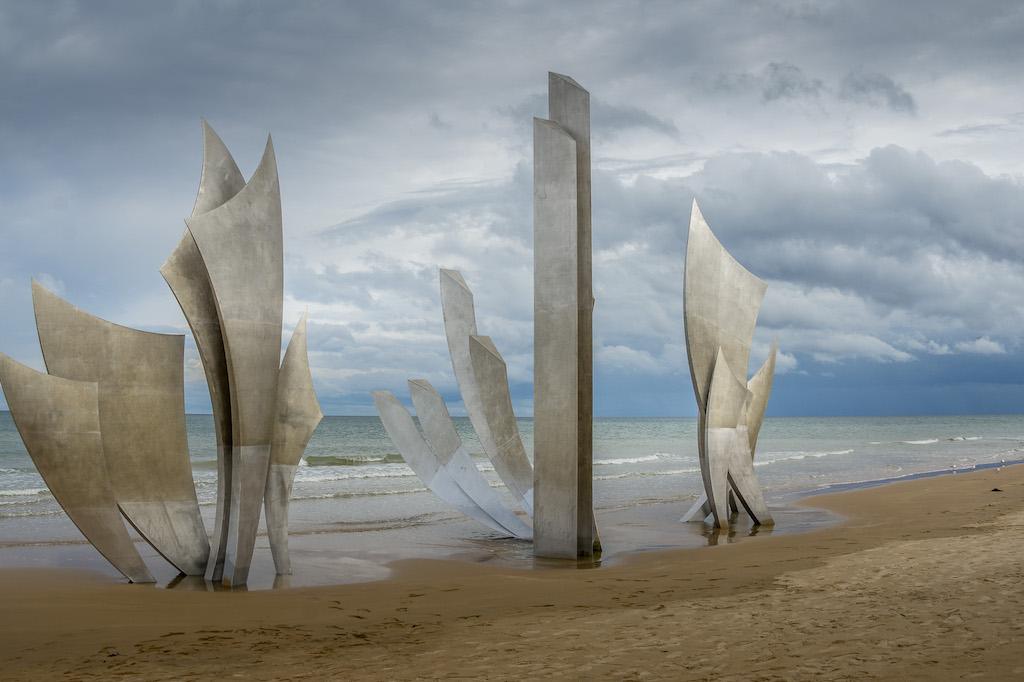
The sculpture is in three elements: The Wings of Hope to remind us that together it is always possible to change the future.
Rise, Freedom! Honouring those who rose against barbarity to help us remain standing strong against all forms of inhumanity.
The Wings of Fraternity to remember this surge of brotherhood reminding us of our responsibility towards others as well as ourselves. On June 6, 1944, these men were more than soldiers, they were our brothers.
Read More : Here are 13 other fabulous day trips from Paris .
The Normandy American Cemetery And Memorial
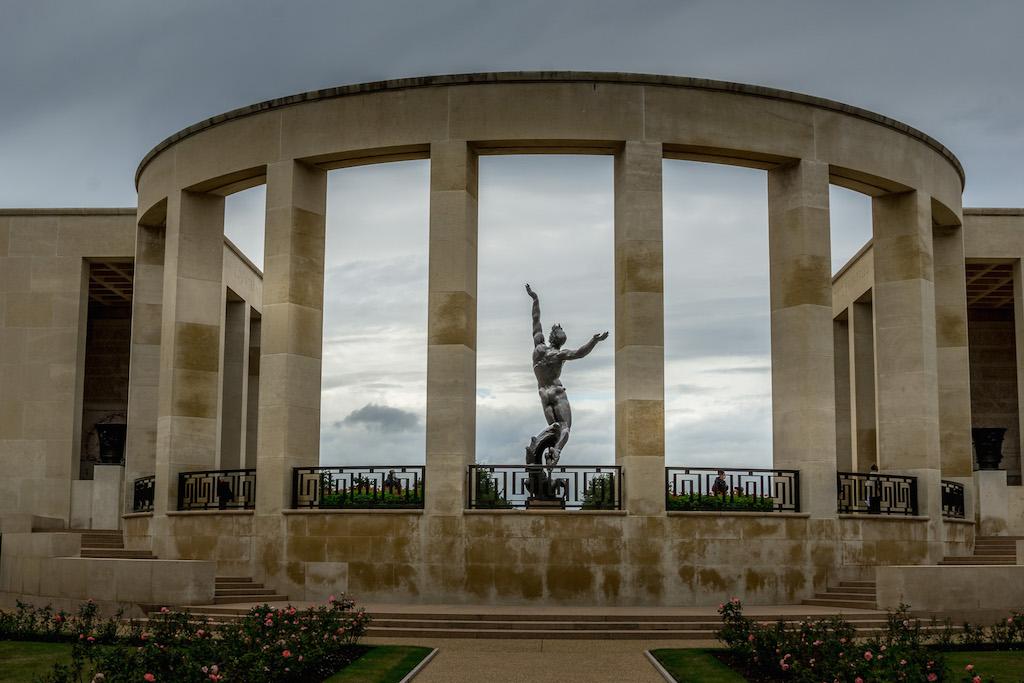
I had no idea what to expect.
The glorious statue, Spirit of American Youth, invites you to enter. And there, 1557 engraved names of soldiers missing in action encircle you. Those that have a rosette beside their name have since been found.
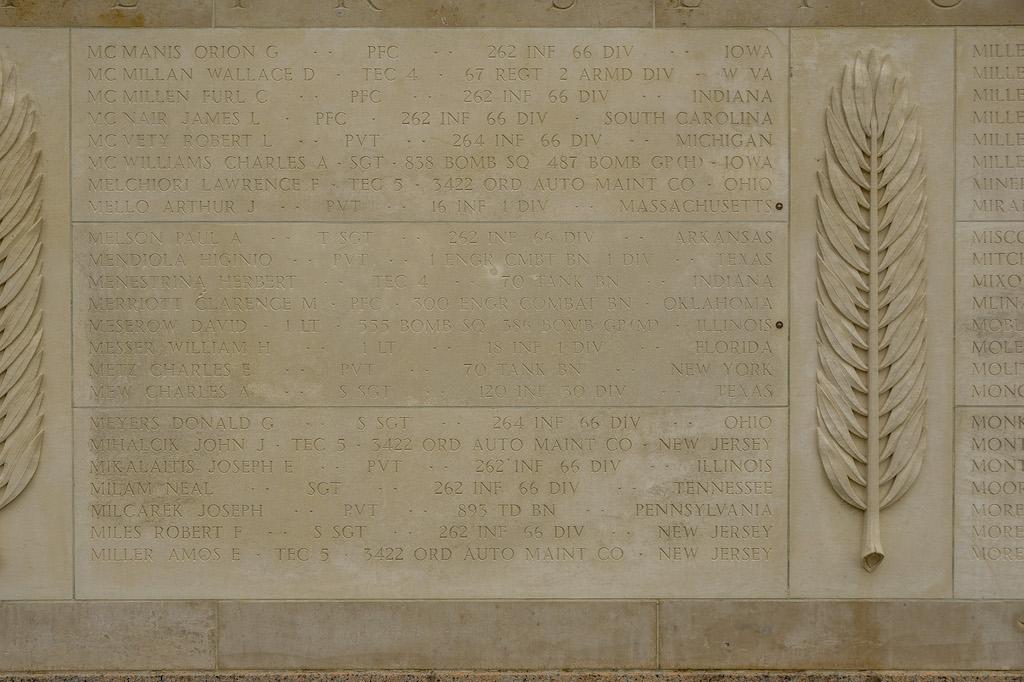
Ahead there are 9387 white headstones that stretch as far as the eye can see between the forest and the English Channel, perched over Omaha Beach.
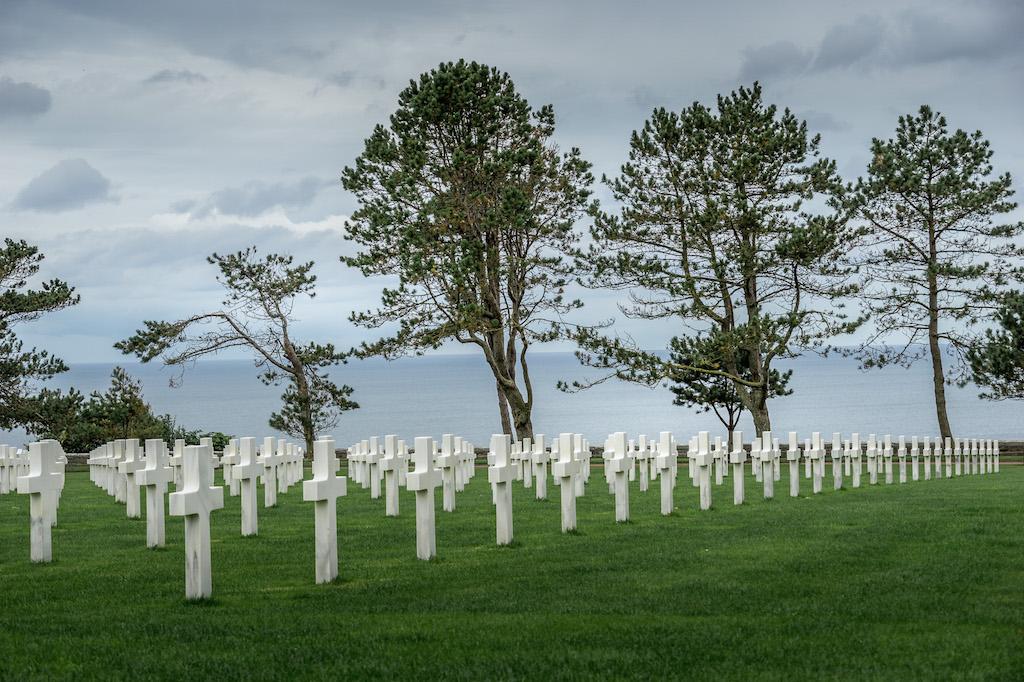
As a mother, as a sister, as a human being, it is impossible not to be impacted as standing amidst the rows of crosses.
The Artificial Harbour Near Arromanches-les-Bains
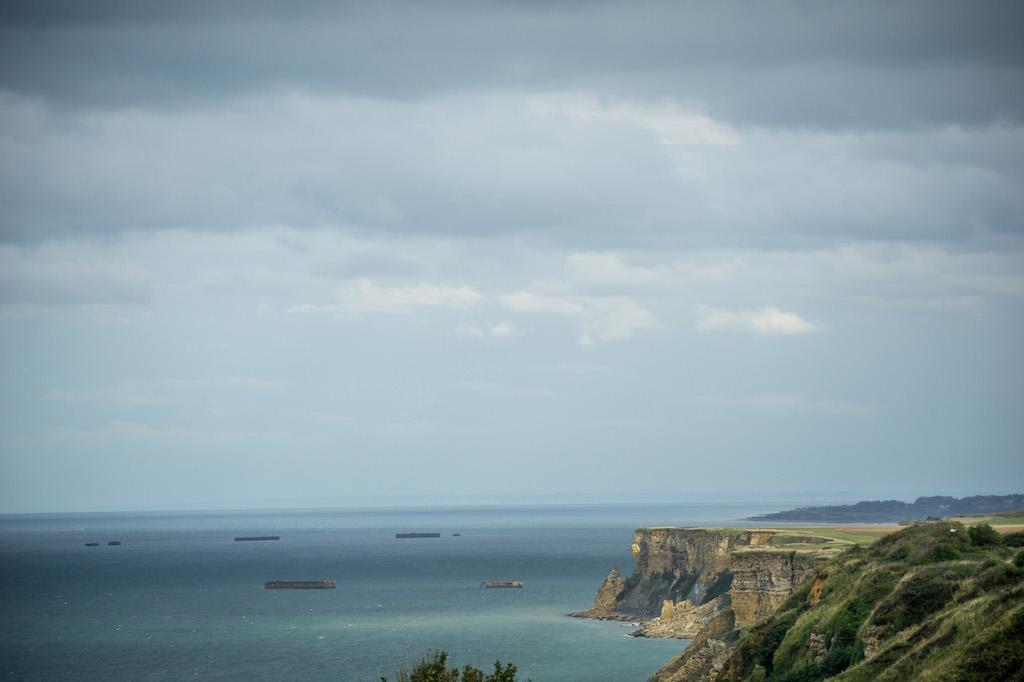
From a distance, our group viewed and listened to the ingenious plan of Sir Winston Churchill to create two fake harbours that also acted as a breakwater so that Allied troops could bring reinforcements and equipment to France.
On the morning of June 6, 1944, huge concrete chambers were towed towards the Normandy coast and then sunk into place creating Mulberry Harbour. German pilots saw the concrete chambers heading to France but could not figure out what they were seeing.
The concrete blocks still remain today and can be seen off the shores of Arromanches-les-Bains. The D-Day Museum here goes into detail about creating the Harbour, also known as Port Winston.
I went to the D-Day Beaches in Normandy to pay my respects, to stand and feel where recent history took place and to appreciate the liberties and freedom that I have today. I hope you enjoy visiting the D-Day Beaches in France as much as I did.
Until next time,

Liberté – Liberty: A Poem By Eluard
“Liberté” written in 1942 during the German occupation by French poet Paul Eluard:
an excerpt:
See the full poem here .
Lest We Forget…

More Travel Info
Planning your itinerary for normandy france.
You might also like this post, 19 Wonderful Things to do in Normandy .
There are also many individual articles on specific places to help you plan your trip to this incredible region of France.
Honfleur: An Authentic Taste of Normandy
The Magnificent Soaring Cliffs of Etretat
Deauville and Trouville-sur-Mer: A Seaside Day Trip From Paris
How To Eat Oysters Like the French
Visiting Mont-Saint-Michel: A Timeless Beauty
Movies About The D-Day Beaches in Normandy France were :
The longest day (1962).
Our guide recommended this movie as the most realistic account of the landing at Omaha Beach. I watched it recently and would say that for those of you who haven’t seen it, it is a must. Watch it before your visit, or after as I did or simply to get a glimpse into June 6, 1944.
Saving Private Ryan (1998)
Overlord (1975), like this post pin it.
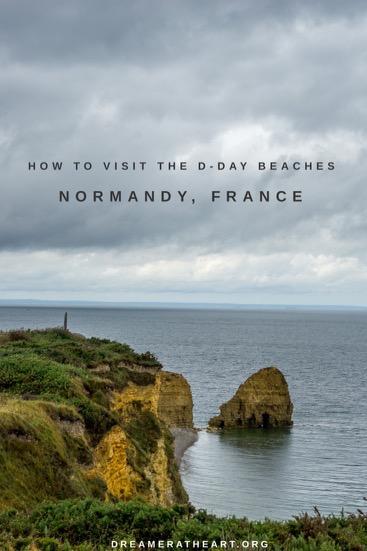

You might also like...

Alison Browne
Creator and Founder of Dreamer at Heart Alison, a Francophile from a young age, is following a long-held dream and has been living in Paris since 2020. Her passion for uncovering Paris and discovering the regions of France has resulted in an expertise about France that she loves to share in her articles. Also a solo traveller, Alison shares her experiences of solo travel to many corners of the world. Alison helps over 65000 readers a month plan their trips.
Reader Interactions
Leave a reply cancel reply.
Your email address will not be published. Required fields are marked *
Save my name, email, and website in this browser for the next time I comment.
Have Paris travel questions? France? Solo travel?
Contact me at

Dreamer at Heart is a participant in the Amazon Services LLC Associates Program, an affiliate advertising program designed to provide a means for sites to earn advertising fees by advertising and linking to Amazon.ca and affiliated sites. Amazon and the Amazon logo are trademarks of Amazon.com, Inc, or its affiliates.

- All Destinations
- United States
- European Theater
- Pacific Theater
- The Home Front
- The Holocaust
- Pearl Harbor
- WWII Events
- Wings, Wheels, & Weapons
- General WWII Travel Topics
- Work With Me
- Skip to main content
- Skip to primary sidebar
DESTINATION: WWII
A World War II Travel Blog
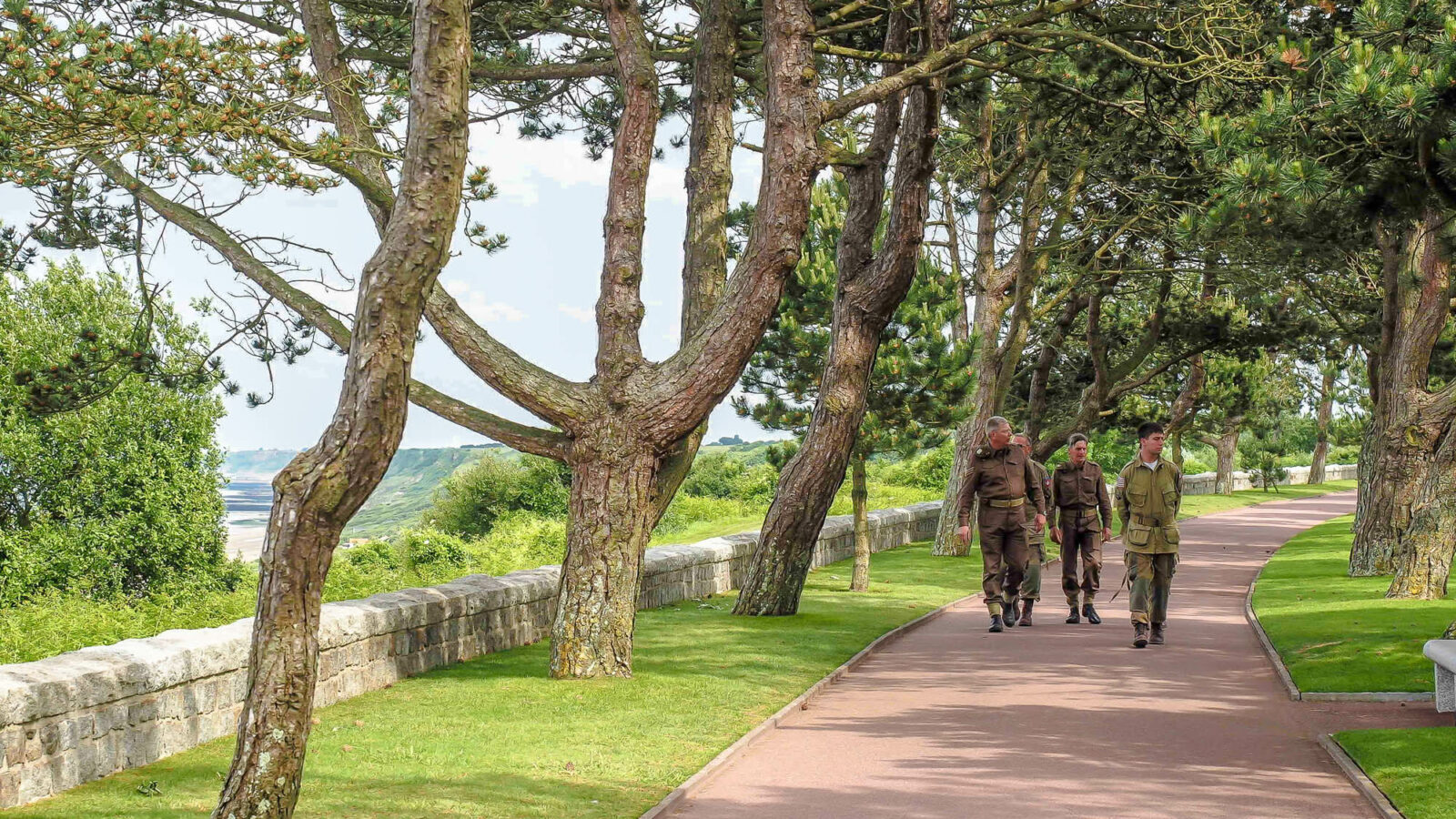
The 10 Best Local D-Day Tours in Normandy for 2024: Beaches, Battlefields, & Beyond
Last Updated: January 29, 2024 // by Ashley Smith 4 Comments
While many travelers can only squeeze in a day trip to Normandy from Paris , just as many others dedicate a couple of days here to take advantage of the many available Normandy D-Day tours. Booking a local day tour of the many worthwhile D-Day sites is the best way to get the most out of your visit.
Table of Contents
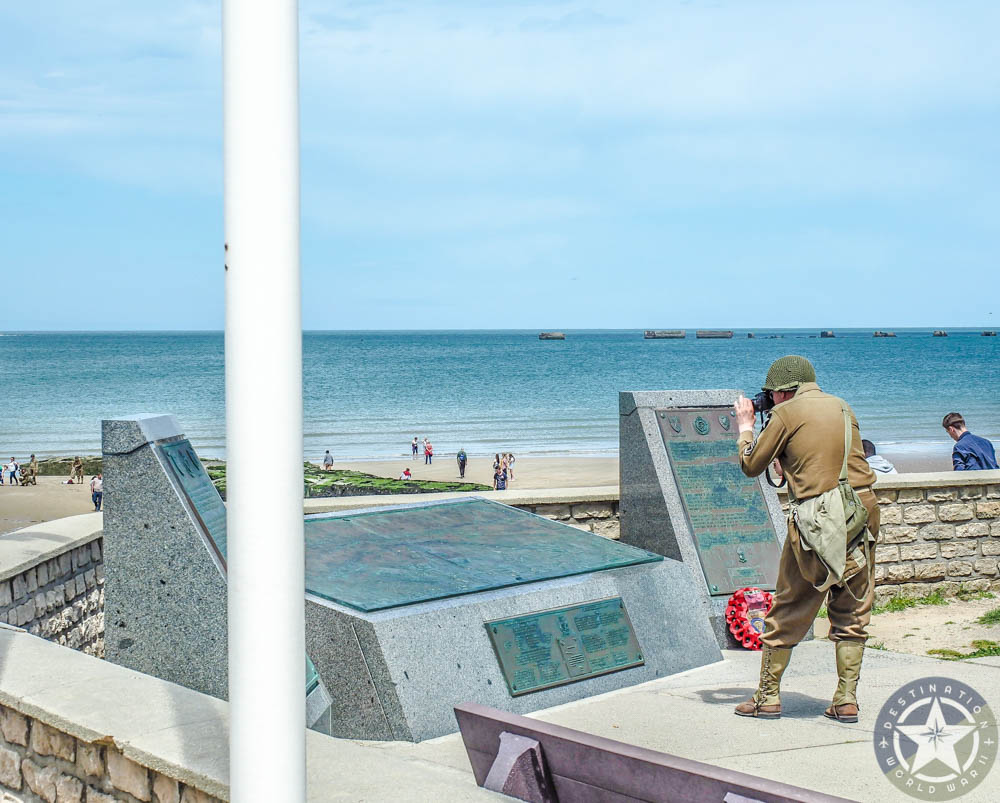
Why book one of the Normandy D-Day tours?
Day tours in Normandy are great for many reasons, for instance:
- Transportation – There’s not a lot of reliable public transportation here, so booking a tour will ensure you can get to all the sites you want to see without having to rent a car.
- Expertise – The Normandy tour guides are experts in their field and can provide loads of historical background on the sites you’ll visit.
- Planning – Or really, the lack thereof. Book yourself on a tour and you won’t have to deal with any of the logistical planning.
- Like-minded travelers – On tours like these you get to meet like-minded travelers excited to discuss the topics at hand and share these experiences. This is especially great if you’re traveling solo.
This post only covers D-Day tours originating in Normandy . You have to already be here to join them, or be able to easily get here before the start time. With the exception of two, all the rest start and end in the town of Bayeux . If you’re looking for Normandy day tours starting and ending in Paris, check out my post on Normandy day tours from Paris .
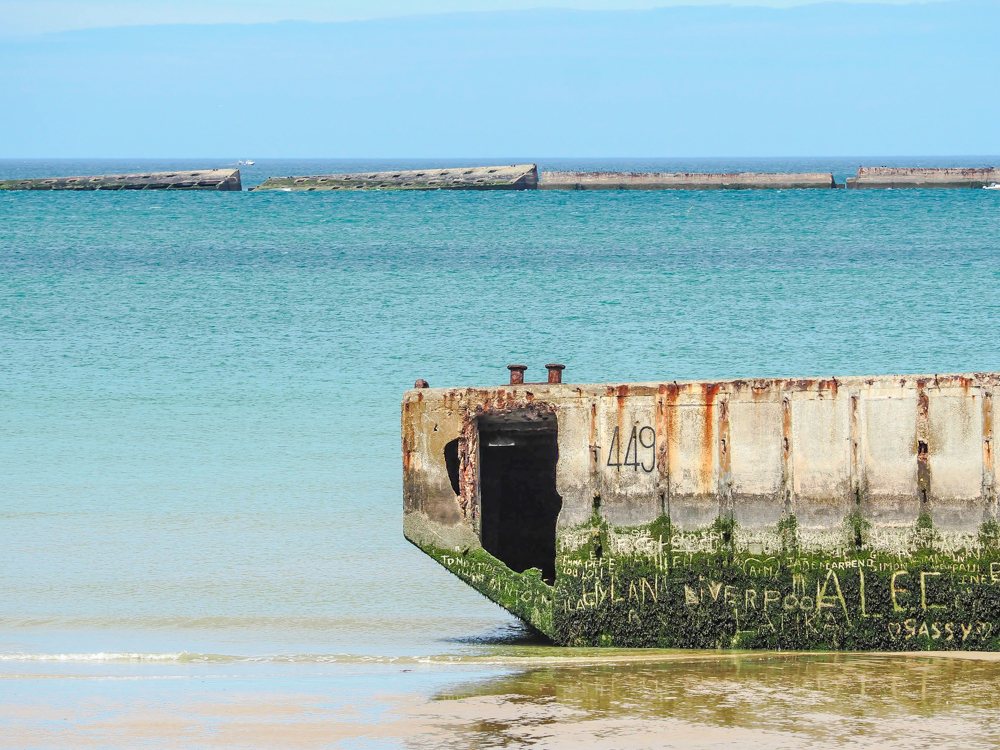
Choosing the best Normandy D-Day tours
But which of the many available tours out there are the best ones? Which ones go to the best places and cover the most ground? Luckily, you have a World War II travel expert at your disposal to scrutinize them all and help you choose!
I haven’t taken all the tours on this list, but I do have a keen sense of what the average Normandy visitor wants from a tour of the D-Day sites . To create this list, I’ve compared the many available tours against my stringent set of criteria. I’ve taken into account things like:
- Customer rating and reviews
- Length of the tour and start/end times
- Overall benefit (Is it worth your valuable time?)
- Topic/focus of the tour
- Ease of logistics
…and much more. All so you can be sure which of these Normandy D-Day tours are the most deserving of your precious time and money. All the tours in this post are English-language tours and all prices are listed in U.S. dollars.
So how do I go about choosing which tours are the “best?” Well, I’m extremely particular when it comes to booking travel. I’ll never recommend anything that’s rated lower than 4 out of 5 stars, anything with no reviews, or anything that’s offered by a company that looks less than reputable. As always, I only recommend the things I would personally book for myself. (And I’m a hard sell.)
And if you do find yourself in Paris, be sure to check out the many interesting WWII sites in Paris . There are some great museums and memorials here not to miss.

My favorite day tour companies
The two companies I always go to for day tours (anywhere I go) are Viator and Get Your Guide . I’ve booked many tours through them and have always been satisfied. They’re both well-known in the travel industry; Viator is owned by TripAdvisor. They’re both super easy to book with; most tours offer free cancelation; and they always have competitive prices.
I also like Tours By Locals for great private options. You can find some amazing guides here who are fully licensed, with history degrees, years of experience, and unique local perspectives.
So, let’s get to it! All things considered, these are my choices for the best D-Day tours in Normandy for 2024.
For more information on each of the sites and museums mentioned in this post, check out my articles on what to see at each of the five Allied landing beach sectors: Utah , Omaha , Gold , Juno , & Sword Beaches.

Best D-Day tours in Normandy: at a glance
In this post, I’ll dig into what makes these the best D-Day tours to take in Normandy. I’ll tell you why I picked them, what makes them stand out among the others, what they include (and what they don’t), and more. But first, here’s the quick list of my picks for the 10 best Normandy D-Day tours:
- Best overall : Normandy American D-Day Beaches Full Day Tour from Bayeux
- Best half-day tour : American D-Day Sites in Normandy Half-Day Tour
- Best private tour : American D-Day Private Tour with a Licensed Guide
- Best shore excursion : D-Day Landing Beaches Shore Excursion from Le Havre
- Best Band of Brothers tour : Omaha and Band of Brothers Full Day Tour from Bayeux
- Best tour for Canadian visitors : Full-Day Canadian Battlefields and Sites of Normandy Tour
- Most unique Normandy D-Day tour : Half-Day Sidecar Excursion to the Landing Beaches
- Best tour from Caen : Guided D-Day Sites Tour & Caen Memorial Museum
- Best D-Day tour for British visitors : British D-Day World War II Normandy Private Tour
- Best bonus D-Day sites tou r: Utah & Omaha Beaches D-Day Group Tour from Bayeux
That’s the simple list; now let’s dig deeper into which of these Normandy D-Day tours is going to be the best for you .
Also check out: 10 Things You Need to Know Before Visiting Normandy’s D-Day Sites

1. Best overall Normandy D-Day tour from Bayeux
My pick for best overall: Normandy American D-Day Beaches Full Day Tour from Bayeux
Without a doubt, my pick for the absolute best D-Day tour in Normandy is this one, for 3 main reasons: it’s a small group tour (maximum 8 people); it has a 5-star rating after almost 1,000 reviews; and it stops at all the right places.
What you’ll see on this tour
This tour includes stops at:
- Omaha Beach
- St-Mère-Église
- Pointe du Hoc
- Utah Beach and the Utah Beach Museum
- Normandy American Cemetery
- La Cambe German Cemetery*
*This stop isn’t listed in the tour description, but many recent reviews say they also stopped here. If you read my post on the best D-Day sites to visit , you’ll know why I recommend a stop at the German cemetery as well.
Why it’s the best
This tour includes all sites I absolutely recommend visiting and no unnecessary fluff. This tour is also ideal for American visitors since it focuses on the American landing zones of Utah and Omaha Beaches. If you have to choose just one day tour for Normandy, this is your best option!
I also love small-group tours because of the individual attention each visitor receives and it’s just a more enjoyable experience overall . (No being herded or not being able to ask questions, etc.) Plus, this tour has a 5-star rating and almost a thousand rave reviews ! Reviewers’ favorite aspects of this tour have been the knowledgeable tour guides and the choice of stops.
What to expect on this tour:
This is a full-day (9-hour) tour that starts and ends in Bayeux . It includes:
- Pick-up and drop-off in Bayeux
- Your own knowledgeable guide
- Air conditioned private transportation
- Free cancelation up to 24 hours before your tour’s start time
It does not include lunch, optional gratuities, or other personal expenses.
How much this tour costs
As of January 2024, this tour is offered 7 days a week and costs just $139 per person . All things considered, I feel this is a fantastic value for such a highly-rated tour that visits many of the best sites. I would absolutely book this tour myself.
A similar option
There’s another tour that’s similar to this one but that trades in the Utah Beach Museum and La Cambe Germany Cemetery for a visit to the small village of Angoville-au-Plain . If you’d like to visit a small local village where a lot of fighting took place (by the 101 st Airborne), check out: Utah & Omaha Beach D-Day Tour from Bayeux Station .
This tour also has a 5-star rating and tons of rave reviews and is also a small-group tour with a maximum of 8 people.
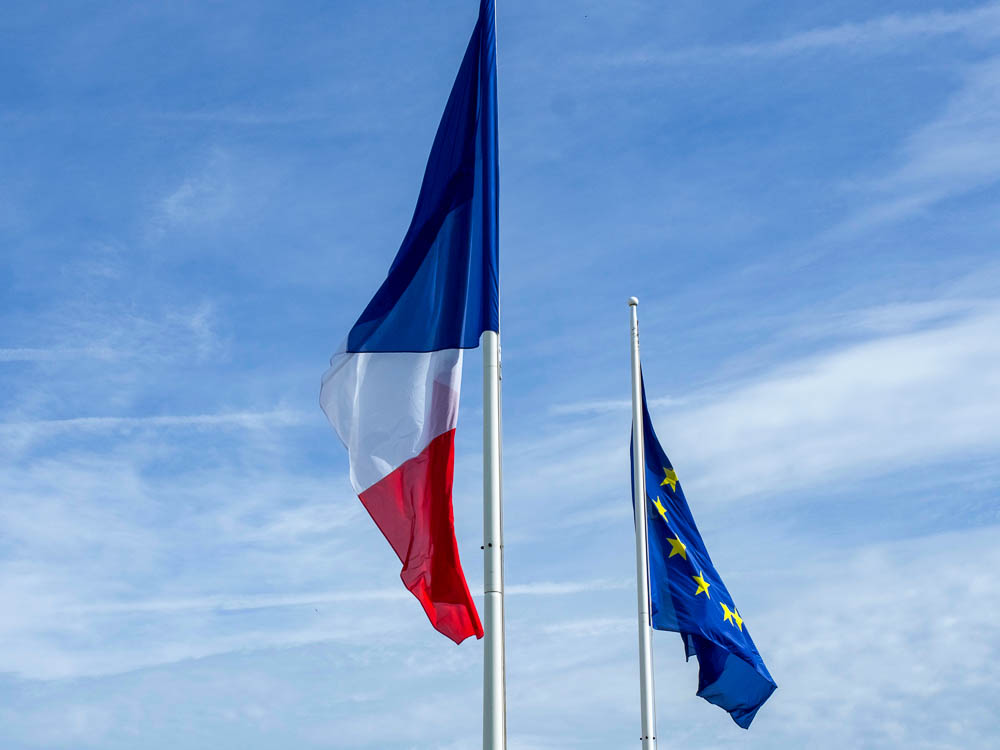
2. Best half-day Normandy D-Day tour
My pick for best half-day Normandy D-Day tour: American D-Day Sites in Normandy Half-Day Tour from Bayeux
If you find yourself on a time budget here in Normandy but still want to see some of the top D-Day sites, this is the tour for you. This 4-hour tour visits the key American locations, has a maximum of 8 passengers, and has a 5-star review rating.
This half-day Normandy tour includes stops at:
If you have limited time for a D-Day tour , these are three sites you shouldn’t miss . It caps the tour at 8 people for a more personalized experience, and it has a 5-star rating after hundreds of rave reviews . All the best reviews go to the tour guide Matt!
Another thing I love about this tour is that you can choose between morning or afternoon start times . Because it’s just a half-day tour, you can opt for either a 9:00 am start or a 2:00 pm start.

What to expect on this tour
This is a half-day tour (4 hours) that starts and ends in Bayeux . It includes:
- Pick-up and drop-off in Bayeux city center
- Private, air conditioned transportation
- Your own knowledgeable tour guide
- Free cancelation up to 24 hours before your tour
It does not include lunch, optional gratuities, or your own personal expenses.
As of January 2024, this tour is offered 7 days a week, two times per day, and costs $95 per person . For a small group tour that visits the three main American D-Day sites with a passionate and knowledgeable guide, this is a great deal.
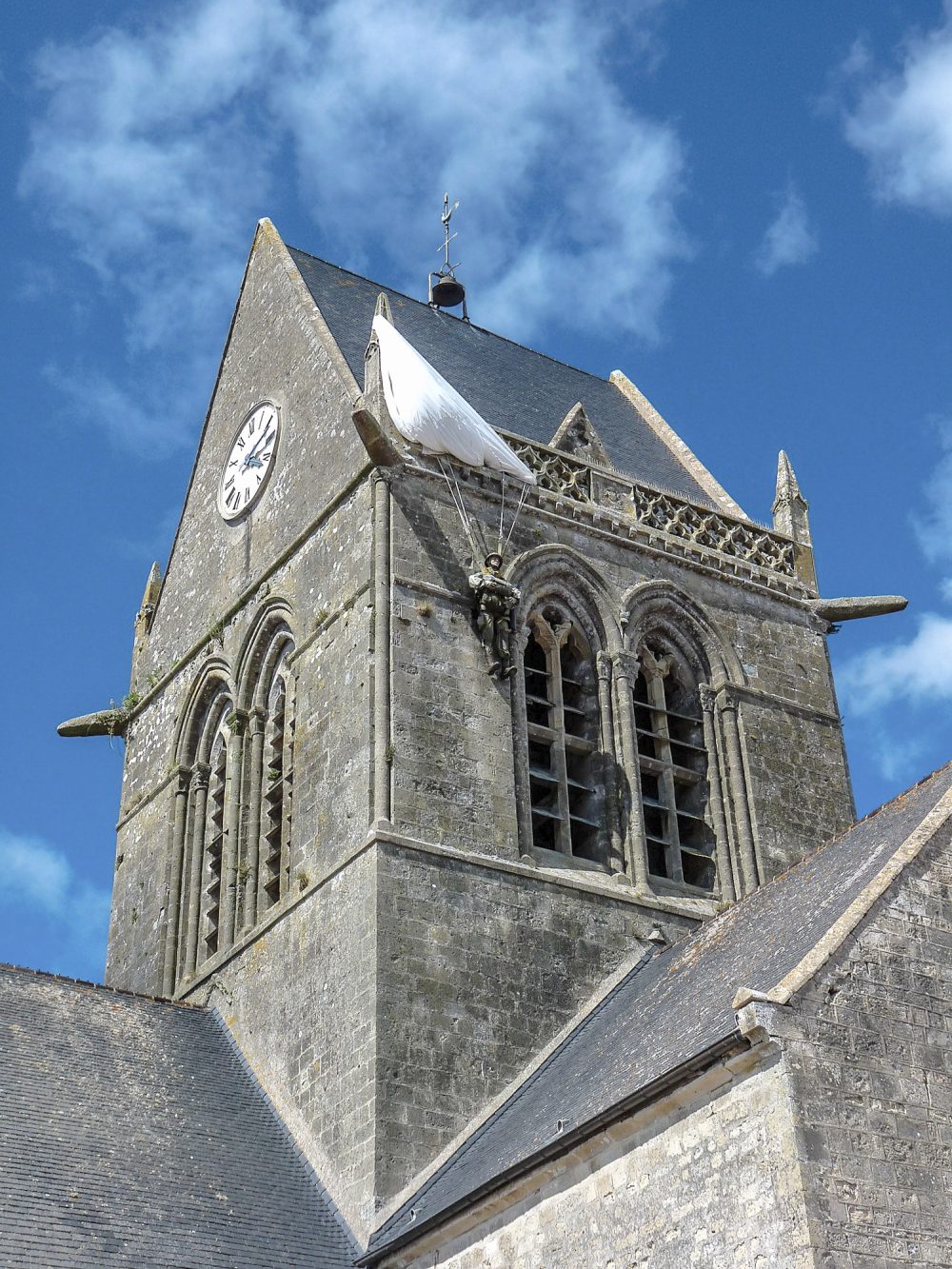
3. Best private D-Day Normandy tour
My pick for best private D-Day tour in Normandy: American D-Day Private Tour with a Licensed Guide (Pierre)
There was some stiff competition here for best private tour, but ultimately I chose this one offered by Pierre, a local who lives in Bayeux.
The greatest thing about hiring a private tour guide for Normandy is you get to choose which sites you visit . Most guides have a list of sites they think are the best, but all are open to amending your tour to your preferences. For instance, for this tour, Pierre plans to take you to:
- Utah & Omaha Beach (the two American landing beaches)
- Pointe du Hoc (American battleground)
- Sainte-Mère-Église
But again, he’s happy to work with you to choose which sites to visit in order to create the D-Day tour you’ve always wanted.
I chose this particular tour for the best private option for a few reasons. First, the guide Pierre has been a licensed D-Day tour guide for over 8 years. Not only that, his background is in political science with a master’s degree in American history . And because he was born in France and lives in Bayeux, you’ll be able to get a unique perspective on D-Day. You can read his bio here .
Additionally, this tour is available for groups up to 7 people (whereas many of the others can only accommodate 4) and as such is a much better value than many others
This is a full-day (8.5-hour) private tour that starts and ends in Bayeux. It includes:
- Fully customizable itinerary of sites that you choose (or go with the pre-planned ones)
- Your own private expert local guide with political and historical background
It does not include lunch and other personal expenses, optional gratuities, or museum admission if you choose to visit an extra museum.
As of January 2024, this tour costs $1034 for a group up to 7 people , for everything mentioned above. This is a great option for larger groups or families, but just as awesome for couples looking for a personalized experience.
Honorable mentions
In case this one doesn’t work for you or Pierre isn’t available on your required date, the other private options I considered are:
- American D-Day Beaches Full Day Tour from Bayeux for up to 4 people, with Karine , licensed Normandy tour guide for over 30 years
- American D-Day Beaches Tour for 8-16 people with Sabrina , national tour guide and lecturer
- Landing Beaches, Normandy, D-Day Full Day Private tour from either Caen or Bayeux with Jonathan , licensed tour guide with a master’s degree in French history. This tour costs much less than the other ones, and the caveat is that you pick him up and visit these sites in your own car. You’re booking the guide only here, no driver.
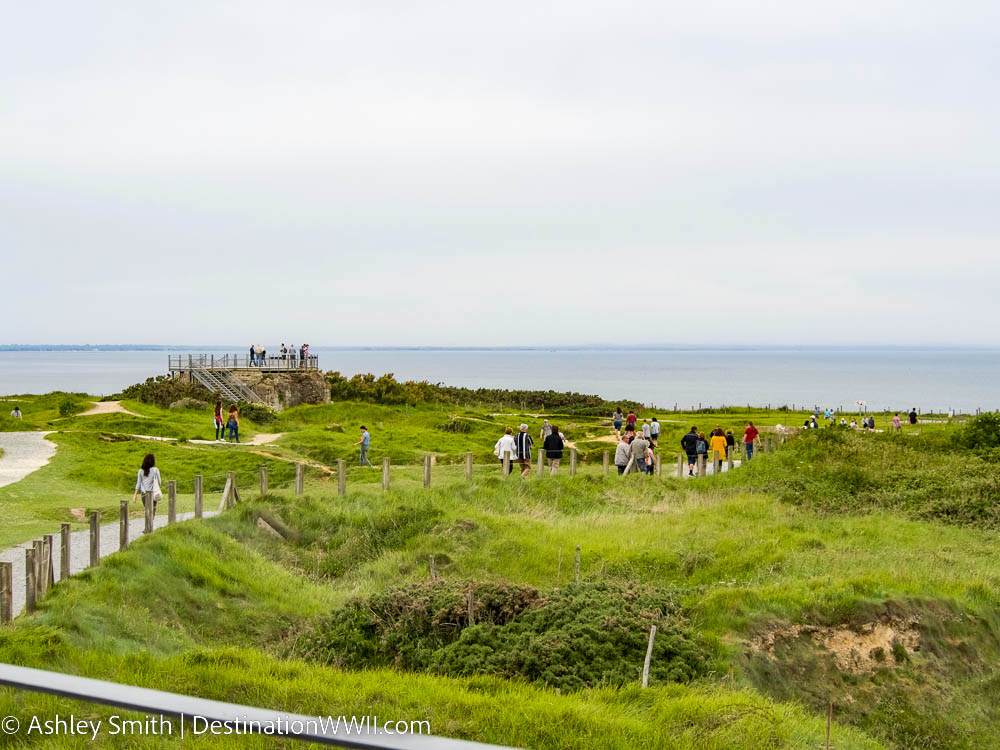
4. Best shore excursion Normandy D-Day tour
My pick for best shore excursion to Normandy’s D-Day sites: D-Day Landing Beaches Shore Excursion from Le Havre
If you’re planning to arrive to the area via cruise ship and are looking to spend a day exploring Normandy’s historic sites, this is the best D-Day tour for you, tailor-made for cruise ship passengers.
This full-day Normandy D-Day tour includes visits to:
If you’re visiting Normandy via cruise ship, you’ll most likely dock at the port in Le Havre. But seeing as how most Normandy D-Day tours leave from Bayeux, your options are limited. This particular tour is tailor-made for cruise ship passengers like you.
You’ll get picked up and dropped off right there at the port near your ship by a guide who understands your particular needs as a cruise ship passenger on a shore excursion . The three sites it includes are my top 3 recommendations for anyone visiting Normandy for any amount of time. And most importantly, it has a 5-star rating and rave reviews .
This full-day (10-hour) shore excursion starts and ends at the cruise port in Le Havre. It includes:
- Expert guide to tell you all about the sites you’ll visit plus the relevant history of Le Havre as well
- Round trip transportation to and from your cruise port
- Free cancelation up to 24 hours before your scheduled tour
As of January 2024, this tour ranges in cost depending on which month of the year you book, but starting rates are $209 per person (in the summer). When rates are higher (like in the spring), the price goes down the more people you have in your group. Take a look at their availability calendar to see the different prices.

5. Best Band of Brothers tour
My pick for the best Band of Brothers -inspired tour: Omaha and Band of Brothers Full Day Tour from Bayeux
There’s a good chance that if you’re here looking at Normandy D-Day tours then you’ve either read the book by Stephen Ambrose or watched the Steven Spielberg/Tom Hanks miniseries Band of Brothers . (And if you haven’t, go do that… NOW.) If you’re as big a fan of the story as I am, you’ll love this tour.
This full-day tour of Normandy’s D-Day sites includes visits to:
- Airborne Museum
- Plane crash site at Beuzeville-au-Plain
- Marmion’s Farm
- Brecourt Manor
- Angoville-au-Plain
- Drop Zone D
This tour is specifically tailored to intrigue fans of the show Band of Brothers so you’ll visit many lesser-known sites and learn more about the history.
You can watch Band of Brothers here on Amazon and it’s also currently available on Netflix, Hulu, and HBO Max.
This tour is operated by Overlord Tour, a leading tour company in the area specifically dedicated to D-Day history. Its itinerary and guides have rave reviews and it’s a favorite among Band of Brothers fans and WWII buffs in general.
I like that it visits the top sites, but also many more obscure sites that the majority of visitors don’t get to see or learn about . You’re sure to make some good friends on this group tour. I also really like the price point—good value here for sure.

This full-day (9-hour) tour starts and ends in Bayeux. It includes:
- Round trip transportation
- Small-group limited to 16 people
- Free cancelation up to 24 hours before your start time
It does not include the cost of lunch, any optional gratuities, or other personal expenses.
As of January 2024, this tour is offered 7 days a week and costs $158 per person . Something I’d like to note about the cost: When you book this tour directly with Overlord Tours instead of through Viator, the cost is slightly lower (€130 which, as of Jan 2024, is about $141 US ).
While this may be tempting, consider this: when you book through Viator , you get the benefit of a full refund if you need to cancel anytime up to 24 hours before the start of your scheduled tour.
When you book directly with Overlord, if you should need to cancel or you simply change your mind, you’ll be subject to a 6% cancelation fee no matter what. If you need to cancel within 14 days of your tour, you now owe a 50% cancelation fee . And if you should want to cancel within a week of your tour, you lose 100% of your booking cost .
That’s just something to think about. Don’t always be so quick to choose the lowest price without digging a little deeper. (Personally, I’d be happy to pay the $17 more for the peace of mind because I know how unpredictable travel planning can be.) By booking with Viator, you still get the highly-rated Overlord tour, but you also get a little bit more freedom and forgiveness.
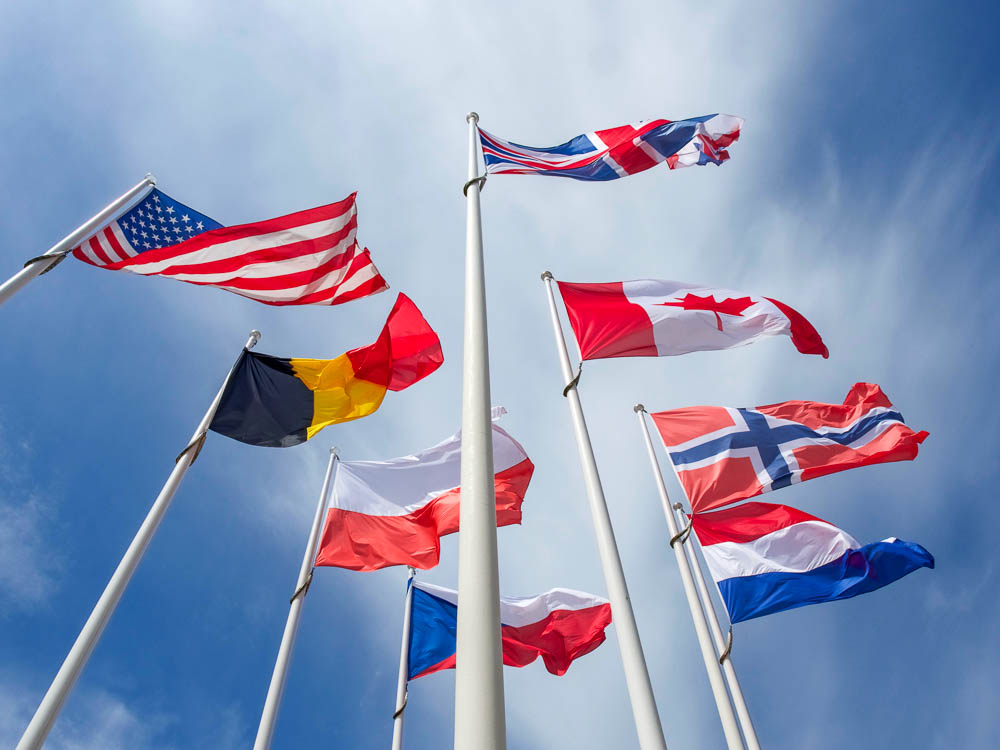
6. Best D-Day tour for Canadian visitors
My pick for the best D-Day tour for Canadian visitors: Full-Day Canadian Battlefields and Sites of Normandy Tour
You’ve probably noticed that most of these tours center around the American D-Day achievements, but Canada and Great Britain also participated in this monumental invasion. Canadian visitors, this tour focuses on the struggles and achievements of your fellow countrymen.
This full-day tour of Normandy D-Day sites includes stops at:
- Juno Beach and the Juno Beach Center
- Beny-sur-Mer Canadian War Cemetery
- The communes of Saint-Aubin-sur-Mer, Bernieres-sur-Mer, Authie, Abbey d’Ardenne, and Carpiquet to follow the Canadian advance
As far as Normandy D-Day tours go, there are very few that specifically focus on the battles and achievements of Canadian troops . This tour does not only that, but it also maxes out at 8 passengers , has a 5-star rating , and tons of rave reviews about the tour guides. Plus, the price tag makes this a fantastic value.
This full-day (8-hour) tour starts and ends in Bayeux. It includes:
- Your own expert tour guide
- Small-group tour of 8 passengers or less
- Pick-up and drop-off in Bayeux as well as transportation between the sites
- Juno Beach Center admission costs
It does not include lunch, gratuities, or other personal expenses. For a full refund, you must cancel within one week of your chosen tour’s start time.
As of January 2024, this tour is offered 7 days a week and costs $148 per person . This is a great deal, especially considering this is one of the only tours of its kind dedicated to Canadian-only D-Day sites.

7. Most unique Normandy D-Day tour
My pick for the most unique Normandy D-Day tour: Half-Day Sidecar Excursion to the Landing Beaches
For something quite different than all the other Normandy D-Day tours out there, check out this tour of the D-Day sites via fully restored vintage sidecars!
This half-day D-Day sites tour includes visits to:
- Arromanches-les-Bains (one of my favorite spots)
- Longues-sur-Mer
- The commune of Port-en-Bessin-Huppain
And all of your travel between the sites will take place aboard some awesome vintage sidecars. What a unique way to explore Normandy!
I love this tour because it’s something totally different from the rest. Rather than drive between the sites in a sedan or multi-passenger van (or worse, a giant tour bus), you get to see Normandy from a totally unique (and fun!) perspective .
Beyond that, this is one of the few Normandy day tours that visits Arromanches-les-Bains and the German battery at Longues-sur-Mer . The commune of Arromanches is located in the Gold Beach sector and is famous for being the location of the artificial harbors that helped the Allies win the war (which you can still see out in the ocean today).
The Longues-sur-Mer battery is another great site I recommend visiting. Here, you’ll find the most intact German battery that still exists and it really helps to put German defense of the “Atlantic Wall” into perspective.
This tour also has a 5-star rating and nothing but rave reviews . I also love how hard they work to make visiting these somber locations fun and interesting.
This half-day (4-hour) tour starts and ends in Bayeux. It includes:
- Private, round-trip transportation
- Use of vintage helmets, gloves, glasses, and jackets for some fun photo ops
- Fully licensed and insured professional tour guides
- Maximum of 8 people on this tour
- Full refund if canceled up to 24 hours before your tour’s starting time
It does not include the cost of lunch, gratuities, or other personal expenses.
As of January 2024, this tour is offered 7 days a week and costs $244 per person (through April) and then increases to $271 per person from May 1st onwards. For such a unique and fun tour, and one of your only chances to visit Arromanches and Longues-sur-Mer, this price point makes sense, even if it is just a half-day tour. This will definitely be an experience you’ll never forget.

8. Best Normandy D-Day tour from Caen
My pick for the best Normandy tour from Caen: Guided D-Day Sites Tour & Caen Memorial Museum
It’s true that most of the best Normandy D-Day tours start and end in Bayeux, but what if you’re staying in Caen? Rather than having to make your way to Bayeux to start your tour, check out this one that starts and ends in Caen.
This full-day tour includes visits to:
- Caen Memorial Museum
This is one of the only available Normandy D-Day tours that includes a self-guided visit to the Caen Memorial Museum, widely believed to be the best World War II museum in France . I personally consider this museum a must-visit, so I love that this tour includes it. I also like that the museum portion of the tour is self-guided since everyone visits museums in their own way.
This is another small-group tour (capped at 7 people) and it has tons of rave reviews, especially of the guides (5/5).
This full-day (7-hour) tour starts and ends in Caen. It includes:
- Admission to the Caen Memorial Museum
- Maximum of 7 people total
- Full refund if canceled within 2 days of your tour
As of January 2024, this tour is offered 7 days a week and costs $129 per person all year long. Since this includes museum admission (about $22 US), that makes this tour one great value to visit these top locations.
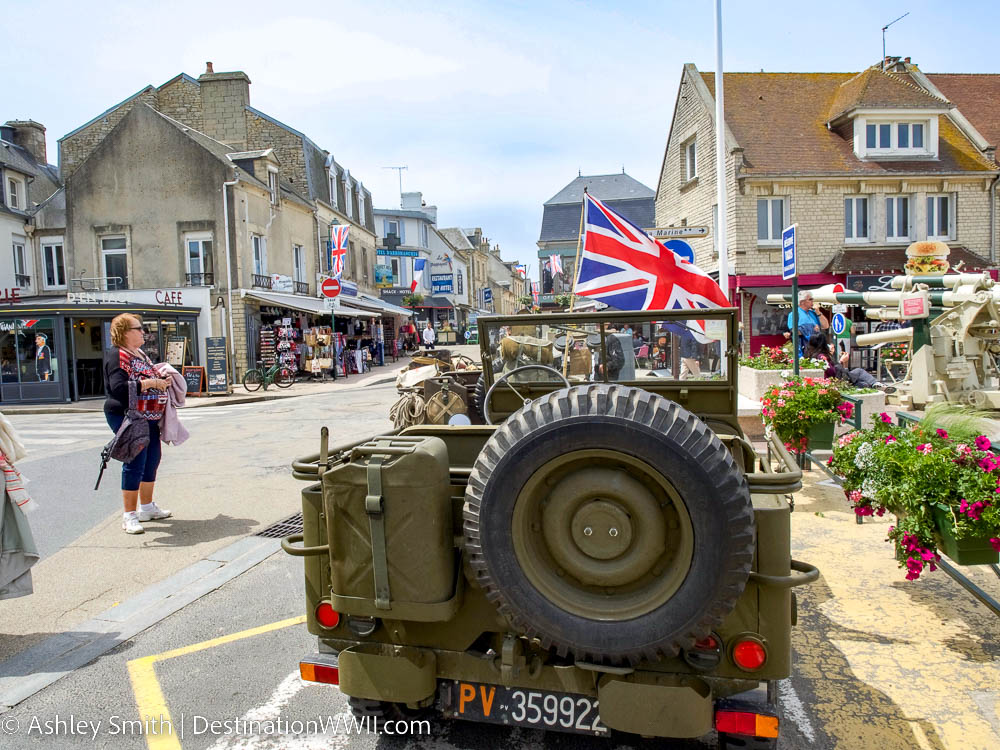
9. Best tour for British visitors
My pick for best D-Day tour for British visitors: British D-Day World War II Normandy Private Tour
Despite the fact that Great Britain was a massive participant in the D-Day landings, landing at two of the five beaches, there are shockingly few tours that focus on the British sectors. However, if you’re willing and able to opt for a private tour, this one is a great option.
- Pegasus Bridge and Memorial
- Main British airborne sites in Ranville
- Ranville War Cemetery
- Sword Beach landing sites and German headquarters
- Juno and Gold Beaches (pass by)
But since this is a private option, you have the ability to customize it to your preferences. Care to also visit Arromanches-les-Bains? Talk to your guide about it!
So few Normandy D-Day tours visit the British sectors and this one is great because you can customize it with the sites you most want to visit. You also have Eric as your guide, a fabulous Scottish tour guide who has lived and tour-guided in Normandy for the past 20 years.
Also, because you can fit up to 8 people on this tour, that makes this one of the best-priced private tours out there!
This full-day (8.5-hour) tour starts and ends in beautiful Bayeux. It includes:
- Pick-up, drop-off, and round-trip transportation between all sites
- Private transportation
- The ability to customize the tour the way you want
It does not include lunch or other personal expenses.
As of January 2024, this tour is offered 7 days a week and costs $899 per group up to 8 people . This is the best per-person rate of all the private Normandy tours I’ve seen.
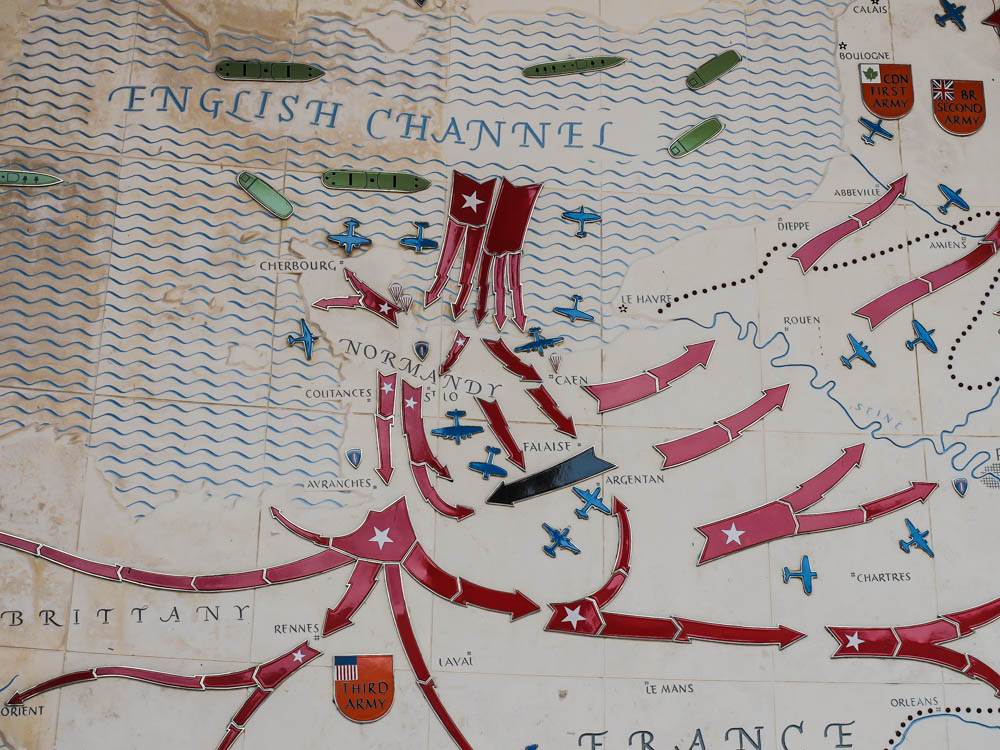
10. Best bonus D-Day sites tour
My pick for best bonus D-Day sites tour: Utah & Omaha Beaches D-Day Group Tour from Bayeux
This tour visits many of the same sites as the others, but I’m calling this a “bonus” tour because it passes by a number of additional sites you might not otherwise see. Even though these are just “pass-by” stops, they still might interest you.
- Commune of Angoville-au-Plain, drop zone of the 101 st Airborne
- Site of the hedgerows battle (pass by)
- Major Richard Winters Memorial (pass by)
- Sainte-Marie-du-Mont (pass by)
On this tour, even in between stops you’ll get to see interesting things like the famous hedgerows (“bocage”) and the monument to Maj. Dick Winters whom you may know from Band of Brothers .
This tour also has a 5-star rating and is one of the most popular Normandy D-Day tours on Viator (with over 1,100 rave reviews).
This full-day (8.5-hour) tour starts and ends in Bayeux. It includes:
- Admission to the Airborne Museum
- Round-trip transportation
- Air conditioned minivan
- Professional tour guide
This isn’t necessarily a small-group tour since it has a maximum of 20 passengers (if it fills up). It does not include lunch, gratuities, or other personal expenses.
As of January 2024, this tour is offered 7 days a week and costs $159 per person . This price point is par for the course and you get to see so much.

Other Normandy D-Day tours
If you have questions about other Normandy D-Day tours that I didn’t cover in this post, let me know! I’ve examined nearly all of them. So if you find one you’re curious about, leave a comment below and I’ll tell you why it didn’t make the list .

More info for your Normandy D-Day trip
- Hotels: Read reviews and find great places to stay here on Booking.com (my personal favorite). Hotels.com and Expedia usually have good deals too though.
- Save lots of money and time by getting some Paris GoCity passes .
- Rental cars: Check out the best local rental car deals here.
- For more Normandy D-Day tours, check out all the options from Viator and Get Your Guide .
- Don’t forget a France guidebook and this must-have France customs and culture guide !
Have a great time on your tour of Normandy! I hope I’ve made planning your trip a little easier.

Save this info, pin this image:

Subscribe to DWWII
About Ashley Smith
Ashley is a World War II historian and travel expert who has visited 33 countries. She specializes in quick trips throughout Europe and the Americas with a focus on World War II museums, memorials, battlefields, and other sites of interest. Originally from Memphis, TN, she currently lives in Boston with her husband and two feline commanders.

Reader Interactions
April 28, 2024 at 1:30 pm
what itinerary would you recommend if you have a day and half to visit the area. I’ll be staying in Bayeux.
April 29, 2024 at 4:55 am
Hi Ray! I would definitely check out the sites in this post , and then add in another museum or two according to your interests. Check out this post to see which area you might want to focus on.
April 29, 2024 at 12:48 pm
Thanks Ashley. Can you recommend a private tour for my second day?
April 30, 2024 at 2:33 am
Yes – take a look at the many options here on Tours By Locals . They always have great reviews and are usually customizable.
Leave a Reply Cancel reply
Your email address will not be published. Required fields are marked *

Paris WWII Sites Map
- Top Destinations
- Mexico City, Mexico
- Tokyo, Japan
- Paris, France
- Rome, Italy
- London, United Kingdom
- All Destinations
- Upcoming Experiences
- Walking Tours
- Small-Group Tours
- Tours for Kids
- Museum Tours
- Food, Wine and Market Tours
- Newly Added Tours
- Audio Guides
- Pre-Trip Lectures
- Admin Dashboard
- My Favorites
- Cookies Preferences
- Client Orders
- Monthly Commissions
- My Advisor Profile
- Advisor Toolkit
- Guide Dashboard
Credit Balance
Transactions are based on current exchange rates and performed in USD. There maybe slight variations in the price estimates.
Visiting the D-Day Beaches: With Normandy Beach Map

Learn more about the historic Normandy Beaches during Context's Full-Day Private Tour with Private Car Service
Over one million people visit the beaches of Normandy every year to pay respects to the soldiers who lost their lives and experience the site of one of World War II’s most crucial turning points.
When was the D-Day Invasion?
D-Day, also known as Operation Overlord, was a significant event in history that took place on June 6, 1944. It marked the beginning of the Allied invasion of Normandy during World War II – which continued until July 24, 1944.
On this day, a massive amphibious assault was launched on the beaches of Normandy, France, by British, American, Canadian, and other Allied forces. D-Day represented a pivotal moment in the war, as it opened a crucial front against Nazi Germany and ultimately led to the liberation of Western Europe from the control of the Axis powers.
If you’re interested in touring this historic site, here’s what you need to know about planning a visit to the D-Day beaches in Normandy.
Can you visit D-Day Beaches?
Visitors can walk the beaches, but those inclined to learn more about history can visit dozens of nearby museums and monuments. Planning ahead will help you optimize your itinerary and ensure you get the most out of this impactful experience.
Context offers a Full-Day D-Day and Normandy Beaches Tour so you can explore key Normandy landmarks, including Normandy Landing Beaches, Pointe du Hoc, Omaha Beach, The Normandy American Cemetery and Memorial, and the Mulberry Harbour at Arromaches.
An expert on D-Day history leads the full-day tour, and it is a meaningful and educational opportunity to learn more about the events of June 6, 1944 and their impact on European liberation.

What were the 5 beaches on D-Day?
Code-named Operation Overlord, the Allied Operation included over 156,000 American, British, and Canadian troops landing on five beaches along a 50-mile stretch of coastline occupied by Germans. This meticulously planned amphibious military assault is widely considered the turning point in World War II and ultimately led to the liberation of France and the rest of Western Europe.
1. Utah Beach
Utah Beach was a last-minute addition to the plan due to its proximity to Cherbourg, a port city. Sadly, many U.S. paratroopers perished when their heavy equipment weighed them down in the flooded marshlands near the beach. Others landed outside their drop zones, but they eventually secured the beach’s only four exit points.
2. Omaha Beach
Because U.S. troops suffered massive casualties at Omaha beach, it is named the bloodiest beach on D-Day. About 2,400 U.S. troops were dead, wounded, or missing once the battle ended. Omaha beach was flanked by steep cliffs and was heavily defended, making it a perilous and devastating battle scene.
3. Gold Beach
British troops stormed Gold Beach, located in the middle of the five D-Day Beaches, about an hour after Utah and Omaha (due to the direction of the tides). While the Germans initially had a stronghold on the beach, British warships, aerial attacks, and armored vehicles proved victorious.
4. Sword Beach
Canadian and British troops invaded Sword Beach’s eastern flank and took out key bridges to prevent German reinforcements from arriving. The Germans answered with moderate fire, but the British and Canadian troops took out critical German artillery resources.
5. Juno Beach
Rough seas made for a challenging landing at Juno Beach, giving German soldiers the initial upper hand. Canadian troops faced monumental casualties as Germans fired from seaside bunkers. However, as soon as German resistance slowed, Canadians quickly advanced inland and captured several towns.

World War II Sites to Visit in Normandy
Did you know that D-Day was only the beginning of the Allied Invasion of Normandy? For twelve more weeks after June 6th, Allied forces continued to fight . Normandy played a large role in World War II, so it's no surprise that history buffs flock to the area to see the many significant locations across this region firsthand.
Omaha Beach
The serenity of Omaha Beach today starkly contrasts the violent scene that occurred here nearly 80 years ago. Visitors walk the coastline and honor those who lost their lives in a wartime battle that lives in infamy.
Visitors can also see remnants of the artificial harbor constructed by the Allies, known as Mulberry Harbour, and view the German bunkers and fortifications that remain on the beach. There are also several museums in the area, including the Omaha Beach Memorial Museum.
Normandy American Cemetery
Just beyond Omaha, the Normandy American Cemetery honors the American troops who gave their lives on the D-Day beaches. It is a poignant way to pay tribute to the legacy of those U.S. troops who never had the opportunity to return home.
Each of the 9,386 headstones contains the name, date of death, service unit, and country where he volunteered, except for the 307 who have no name. There is also a monument to the 1,557 servicemembers whose mortal remains were lost.
Caen Memorial Museum
As you make your way across the D-Day sites, plan a visit to the Caen Memorial Museum . The Museum focuses on the Battle of Normandy and 20th-century history, offering visitors unique insights into the events that marked World War II.
With a range of exhibits that provide a glimpse into the wartime life of troops and civilians, the Museum offers multimedia experiences, films, and a firsthand look at personal items from soldiers.
Arromanches-les-Bains
Today, this picturesque town is known as a seaside resort, but its coast, Gold Beach, played a major role in the Normandy landings.
Gold Beach was one of the beaches designated to receive man-made landing harbors on D-Day, also known as Mulberry Harbours. The harbors were specially created to float across the English Channel and serve as temporary harbors on D-Day. Many of the large concrete blocks remain in Arromanches today as a reminder of its significance to World War II.
Longues-sur-Mer
Longues-sur-Mer was a battery built by the German navy and strategically positioned between the Omaha and Gold Beaches. On D-Day, Longues-sur-Mer was the site of an extended gunfight between the Allied fleet and the Germans. British troops eventually landed at Gold Beach and captured both the position and the surviving German soldiers.
Visitors today can see the original cannon and take in the view from the firing command. Longues-sur-Mer is one of the best-preserved World War II sites anywhere in France, giving visitors an unparalleled view not just of the Bay of Seine, but of what life was like on that fateful day in 1944.
Map of D-Day Beaches
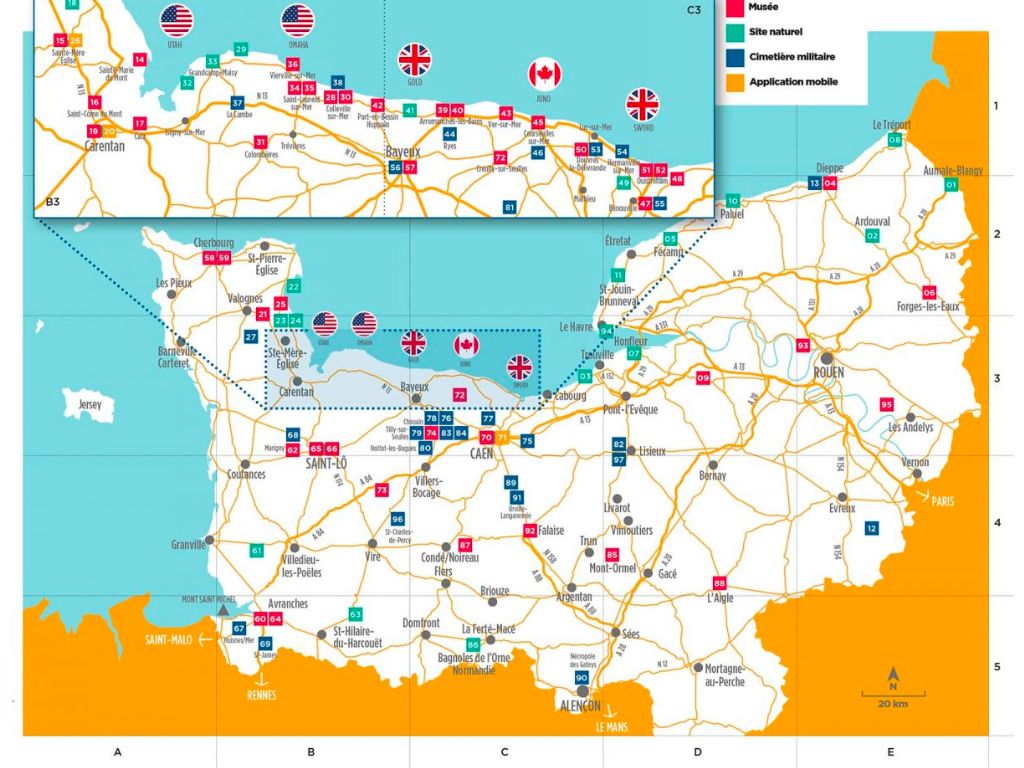
Each beach has its own unique history, and as you examine the map you’ll gain a deeper understanding of the scale and scope of this historic operation.
To look at a Normandy Beach map is not just a lesson in geography; it’s a lesson in understanding what happened on June 6, 1944. Looking at the map, you can imagine the struggles, triumphs, and heart-wrenching losses suffered on the sand.
Whether you’re zooming in for a closer look at each beach’s remaining craters, or as you stand in person on the hillside above a neverending sea of white headstones, you’ll come away with a sense of gratitude, awe, and respect for those who gave their lives on the beaches of Normandy.
Tips and Tricks for Visiting the Normandy Beaches:
- Hire a Context Tour Guide, with Private Car Service: A knowledgeable local historian can offer unique insights into each landmark’s significance to WWII and provide you with a more personalized experience. Additionally, while it is possible to visit the beaches using public transportation, it's much more convenient to rent a car and book a tour. This will give you more flexibility to explore the area at your own pace.
- Dress appropriately: Wear comfortable clothes and shoes for walking, and bring a jacket in case it gets cold or rainy. Because you will be along the coastline, wind gusts can be an important factor when planning your wardrobe.
- Pack snacks and water bottles: Weather conditions can be brutal, especially during the summer. While most museums do offer concessions, it’s important to be prepared with adequate water and snacks to keep yourself comfortable throughout the day.
- Consider visiting early or late in the day: To avoid crowds, it's best to visit the beaches early in the morning or later in the afternoon.
- Allow plenty of time: Plan to spend a full day or more exploring the Normandy beaches. There is a lot to see and learn, and rushing through the sites won't do them justice. You’ll also want to consider the seasonal tides so that you can safely walk along the beaches.
- Respect the sites: The D-Day beaches and surrounding areas are sacred places. Show respect by not littering, staying on designated paths, and not disturbing any artifacts.
- Take a moment for reflection: The D-Day beaches are solemn places that hold somber historical significance. Take a moment to reflect on the sacrifices made by the thousands of brave souls who fought and died there.

Tour the D-Day Beaches
Enhance your Normandy experience with a guided tour of the D-Day Beaches with a local expert. Our Full-Day D-Day and Normandy Beaches Tour has exclusive insights into World War II history to ensure you leave Normandy with a complete understanding and appreciation for its pivotal role in the war.
If you’re looking for other opportunities to learn more about Normandy, take our Full-Day Mont-Saint-Michel Tour and see this gravity-defying medieval monastery with an expert guide.
Learn more about the Normandy Beaches with Context Learning
Are you planning a trip to France? Check out Context’s Upcoming Online Seminars and Courses about France – which feature local experts in WWII History, Archaeology, and Art History.
Or, stream French History and Culture content instantly through Context On-Demand – hosted by the same local experts who lead our tours.
You May Also Like:
- Exploring the Coast of Normandy: Top Sites for History Lovers
- Timeline of the Normandy Invasion
- Reflections on the 75th Anniversary of D-Day
- 10 Best Day Trips from Paris
- Vive la France: Bastille Day
- How to Spend 36 Hours in Paris
Read More Stories
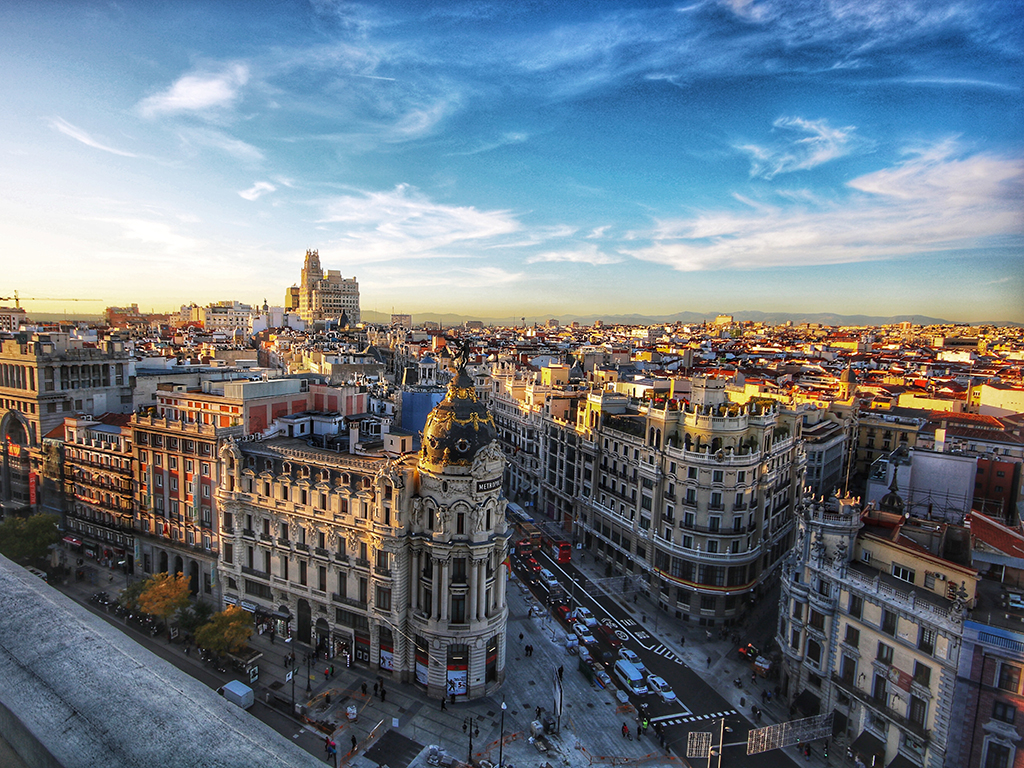
Even More from Context
Subscribe to our Newsletter
Keep Exploring

Explore Tours
Join walking tours with top experts all over the globe.
Browse Our Cities
- Our Experts
- Working with Context
- View All Cities
- Sustainable Tourism
- Refer a Friend for $50
- Travel Updates
- Advisor Login
- Expert Portal
- Privacy Statement & Security
- Cancellation Policy

Visiting the beaches of Normandy: D-Day landings and WW2 sites – your ultimate guide
Visiting the beaches of Normandy, with its wealth of D-Day and world war 2 sites, was on our bucket list of things to do while in France and it’s one of those places that are well worth the visit.
They can be accessed easily from either the UK or other parts of France (and as such, the rest of Europe) and each year they get more and more visitors eager to learn of what happened on 6th June 1944, or as it’s now known – D-Day.
This article probably contains affiliate links. This means that if you buy or book after clicking, I may get a commission at no extra cost to you. Thanks!
I hope our guide to visiting these WW2 sites on the French coast of Normandy will be helpful and inspiring to anyone planning a visit and also anyone with a passing interest in our recent history.
Essentials for your D-Day explorations:
- Guide book with background info on the D-Day Sites
- Normandy Road map
Guided tour from Bayeux
- Half Day Small group tour to Omaha Beach
Our guide to visiting the beaches of Normandy and WW2 sites
The words have become almost normal now – incorporated into our everyday speech – D-day, beaches of Omaha, Utah, Sword, Gold and Juno. Strange to think that 100 years ago, these words meant nothing in the context that we now think of them.
That’s what’s so moving about visiting the beaches of Normandy , the fact that it was so recent, that there are still people alive who remember those days, lived through them and either were there themselves or heard the news about it. As time moves on fewer are around to tell the tale first hand, so it’s all the more important to keep the stories alive and to give weight to those words.

I knew of D-day, of course. I grew up with fairly limited knowledge of the history though, I had heard the term but only really learned about the operation when our son developed a passion about the time period. We watched films, documentaries and tv series about the war – I thought I knew what we were going to see when we visited Normandy!
What remains of World War 2 in Normandy today is sombre, touching and hopeful. Sombre because it was the scene of many deaths, not just fallen men, but brothers in arms (to coin a phrase), comrades and friends. Touching because there are still memories of a time gone by scattered around. Hopeful because it’s a reminder of what can be achieved by humans in the pursuit of a better world.
Pin for later!
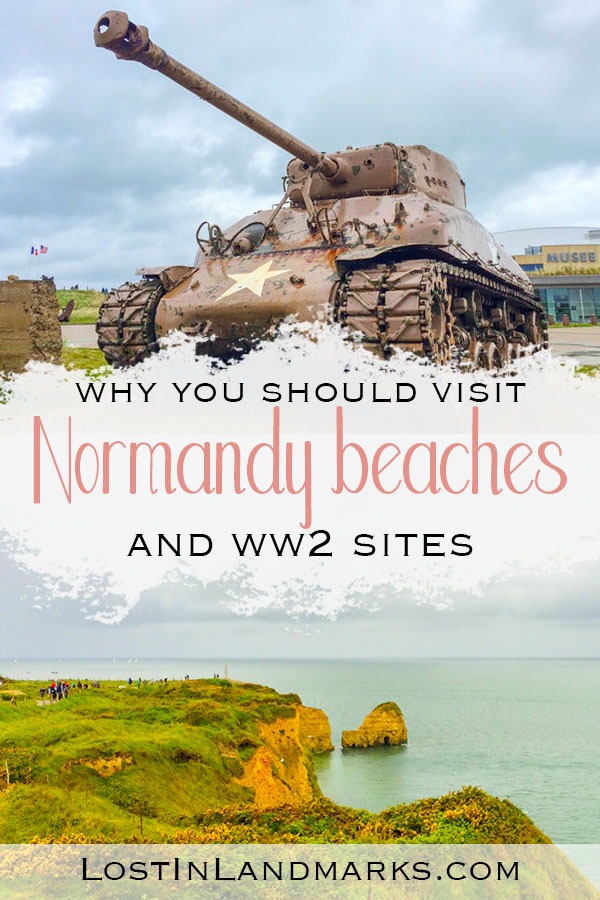
It’s not all about the war in Normandy though. If you’re planning a trip with those who aren’t quite as interested, or perhaps with children who might not cope with days learning about death and fighting, the area has so much more too. Gorgeous little towns, beautiful scenery and of course that amazing French food!
Normandy Invasion – a super quick history
Ok, this will be quick as I imagine if you’re interested in visiting the Normandy D-Day beaches you have a slight inkling of the history involved.

It was one of the largest organised invasions of all time that incorporated naval, air and land troops and it was a turning point for the Allies in World War 2. The Normandy invasion on D-Day, 6th June 1944, were truly immense undertakings from the armed forces of not only Britain but also the USA and Canada.
Prior to it happening, France was under occupation from the Germans and their advancement throughout Europe was continuing. The Allies needed to have a foothold in Europe in order to have any hope of turning the tide. What’s interesting is that the Germans actually knew that an invasion was likely to be happening, but they didn’t know where from and where the Allies would land. There were many attempts to throw off the scent and the Germans did think the invasion would come further up the French coast in Calais or Dunkirk where it was much closer to the UK coast but of course that never happened.
It was so much more than D-Day itself though – there was months of preparation which included simulating the Normandy coastline in areas of the UK coast, practicing their manoeuvres and training the personnel. This was an immense undertaking. Further to this there was an operation whereby the coastal defences were bombed in advance of the invasion.
On the day itself, the Allies began by parachuting in airborne forces behind the enemy lines where they took strategic points and would meet up with the troops that began to land in the early hours of June 6th. They fought with the soldiers and guards of the Atlantic Wall that Hitler built. It certainly wasn’t easy but eventually they took the areas one by one, strategic towns and points were gained and the Allied forces pushed the Germans back.
Although the operation as a whole was a success there were many stories within D-Day where it seems the opposite. Many, many lives were lost on both sides which is a terrible tragedy no matter the outcome.
A note on the names of the beaches in case you don’t know.
There were many different areas of the coastline that troops landed on but they were generally split in to 5 sections and each had a different armed force in charge of landing there.
Each area was given a code name – Utah, Omaha, Sword, Gold and Juno. The Americans were charged with the Utah and Omaha landings. The British landed at Sword and Gold and Juno was mainly Canadians. The overall operation was called Operation Overlord and the landings themselves Operation Neptune.
The history of this time is vast and I’ve researched thoroughly for this article but I’m not a historian so please forgive me if there are any inaccuracies – and also let me know so I can put it right! For more in depth research of this time period Wikipedia is a good start and from there explore their related links at the bottom.

Why visit the D-Day beaches in Normandy?
Of course D-Day has been immortalised in films and tv series over the years and it’s one of the biggest and most well known operations from the Second World War.
It’s an iconic moment in history and one where we can look back and see the huge sacrifice that was made actually did make a difference. If D-Day hadn’t turned out as it did the outcome of the war might have been very different. As such it’s a huge part of our history.
I feel that we must always remember the sacrifices made for us and while watching documentaries, reading books and enjoying movies about it can keep the stories alive, visiting the sites really gives a new dimension.
You can know that soldiers lost their lives on a beach, but it’s just words. Seeing that area and visiting the nearby graves really brings home the personal sacrifices.
For many of us it’s important to visit because we have a personal connection to the day too. Many people come as a pilgrimage to pay their respects to family members who fought there.
For others, and I include myself personally in this, it’s just a really interesting place to go. This is recent history and an important piece of the huge story that is the second world war. No matter what I know about a place or piece of history I can’t fail to get something out of experiencing the place in real life.
Museums help to keep the information of each area in an organised manner and you’ll find many enthusiasts willing to speak to you about the history if you take the time to ask. By supporting these places you’re also helping to preserve the historic sites for future generations – definitely worth it.
Lastly, Normandy is a beautiful place in its own right. I’m focusing this guide on the D-Day beaches and the war history of the area, but there’s so much to enjoy here that’s not just war related so go enjoy the food, the countryside and the people too!
What are the Top 10 must see sights at the D-Day Normandy beaches?
Here’s the places you really shouldn’t miss on your tour of the D-Day beaches in Normandy – I’ve listed them in order from west to east rather than importance:

The first beach that you’ll get to if you are coming from Cherbourg or doing the tour West to East is Utah.
This beach was landed by American troops and was the more successful out of the two the US were dealt. The reasons are most likely geographical, the Germans were defending a wide open coastline here, flat with no difficult to reach areas they could attack from. Overall there were less than 200 casualties for the Allies here and it was a relatively quick victory.
Utah beach is one that isn’t in a built up area and the beach itself is nice to walk along if you get good weather with many remains of the German defences scattered along and lots of monuments to the battalions and units present there. There’s also a museum which attracts most people with an interest in the time period and is fairly inexpensive.
Utah Beach Landing Museum – learn about the chronology of the landings, see a B26 bomber.
Winter opening hours (Oct 1st – May 31st): 10am – 6pm. (It is closed for the majority of December, opening from the 26th – 30th only)
Summer opening hours (June 1st – Sep 30th): 9.30am – 7pm
Get tickets here
Sainte-Mère-Église
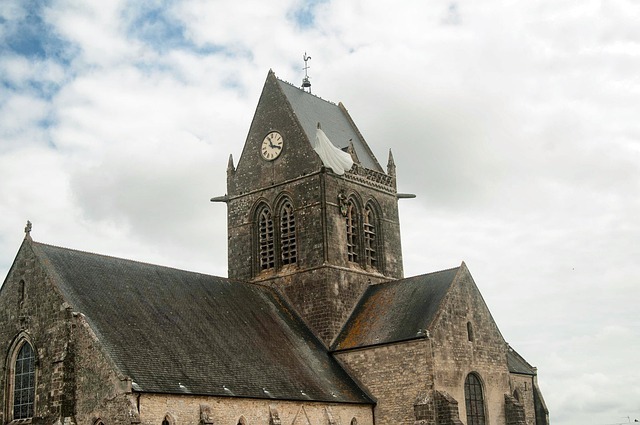
A big part of the operation at Utah beach was the destruction and capturing of many of the strategic points in the area from the airborne divisions who landed at various places including Sainte-Mère-Église, a small Normandy town.
Some of the 82nd Airborne division landed at Sainte-Mère-Église in the very early hours of the 6th of June 1944, unfortunately too close to where they planned to land. Many of them died as some buildings on fire in the town lit up the parachutists descending and were easy targets for the Germans. One interesting tale is about the soldier, John Steele, who found himself caught on the steeple of the church as he tried to land. He was shot in the foot, in lots of pain and could only watch some of the others in his company as they were killed. He dropped his knife so could not free himself and so had to pretend to be dead while the fighting was going on around him. He eventually was rescued from his precarious position by the Germans and he became a prisoner of war until he escaped a few days later. Despite early German dominance the town of Sainte-Mère-Église was taken soon after on June 7th 1944 and it also has the honour of being the first liberated town of the Normandy invasions.
In the town itself there’s a museum dedicated to the 82nd and 101st Airborne division – if you’ve watched Band of Brothers, 101st Airborne is portrayed in it.
It’s well worth spending some time there with plenty that will keep kids happy (both of mine enjoyed their time there) and provide an insight in to what happened in the area for those interested to learn more. Lots of replica planes and gliders to get a sense of what was involved!
The church keeps the story of the parachutist alive by keeping a fake dummy of a soldier on its roof top.
It’s a pretty town to explore round with many tourist shops selling world war 2 memorabilia, some restaurants and cafes too. We really enjoyed our time there.
Airborne Museum – learn about the airborne attack, how they liberated the town and also see some of the gliders and planes used.
Opening times:
- May – Aug: 9am – 7pm
- April and September: 9.30am – 6.30pm
- October – March: 10am – 6pm (the museum is closed throughout December and January)
See here for more information
Pointe du Hoc

One of the areas of Normandy that remains much as it was during the time of the landings is Pointe du Hoc. It’s a steep cliff edge and the highest point of the area which sat between the beaches of Utah towards the East and Omaha which lay to the west. As such it was heavily fortified and protected by the Germans despite it having been bombed prior to D-Day.
The United States Army Ranger Assault group were charged with the scaling of the cliffs at Pointe du Hoc and removing the German artillery with the help of the British to land them at the scene. Before even landing there were problems straight away with the sinking, and subsequent loss of those on board, of one of the amphibious DUKW vehicles. On landing the Germans fired heavily on all of the troops with disastrous effect and on reaching the base of the cliffs the Rangers were at half the initial numbers. To reduce the risk of them being fired at as they grappled up the cliffs, navy ships from the US and British navies fired on the German defences. On reaching the top the soldiers struggled with yet more set backs: their radios didn’t work and their objective of removing a main artillery defence was already gone. After intense fighting the finally overpowered the remaining guns and destroyed them. They held off lots of counter attacks from the Germans over the next couple of days until they got relieved by further US troops on the 8th June.
Pointe du Hoc is one of the stories I personally didn’t know much about but which I’m so glad I learned about.
The museum at Pointe du Hoc does a really touching video which explains what happened. Reading about the words often don’t convey the sense of what happened, but listening to the stories from the soldiers who scaled the cliffs themselves, watched their friends get fired upon and who came home to tell the tale brought tears to my eyes.
There’s lots to see at Pointe du Hoc as well as the visitor centre – the remains of the casemates built by the Germans can be explored and you can imagine how it might have looked to them as the enormous amounts of D-Day troops descended on the area. Craters litter the site too where it was heavily bombed.
Visiting Pointe du Hoc
Open daily throughout the year
- April 15th – September 15th: 9am – 6pm
- Rest of the year: 9am – 5pm
Pointe du Hoc is one of the few free things to do in Normandy related to WW2 – if you’d like more information about visiting see here .

Maisy Battery
I have such a soft spot for parts of history that are covered over and forgotten about for years and Maisy Battery is one such place.
It was a very important German defensive position situated between the Utah and Omaha beaches and consists of over 2 miles of tunnels, bunkers and trenches. The history of the site is still coming to light with all the war documents being released over the years – it seems that it was an unknown site to the Allies and that the Germans used Pointe Du Hoc as a ruse to confuse them and with the removal of the big guns that were expected to be there, this could certainly be true. It was lost to the world for over 60 years and was only rediscovered as someone found an old map to it in a veteran soldiers trousers. That discovery combined with the opening of war files has opened up an exciting and interesting chapter!
If you drive past you might miss it – it’s completely camouflaged from the casual viewer! Nowadays you can walk round the site, explore the tunnels, see some old guns, cannons and weaponry. It’s a great day out and quite different to many of the other WW2 sites around Normandy.
Visiting Maisy Battery
Opening times
- April 1st – May 31st: 10am – 4pm
- June 1st – Aug 31st: 10am – 6pm
- September 1st – September 30th: 10am – 4pm
- Closed from October – March (although you can contact them with a possibility of visiting)
See here for more details and tickets
Omaha beach

The US Army had the objective of securing the Omaha beachhead however a catalogue of mistakes and confusion led to this being an extremely difficult operation with huge numbers of soldiers losing their life. It started with the naval bombardment of the German defences – it wasn’t enough as they navy didn’t want to risk hitting the landing crafts. The landing troops were also blown off course quite a lot on the morning of the invasion due to the weather and this did not help matters. The intelligence about the defences were flawed, they had trouble bringing vehicles on land with many of them being swamped as they tried to land and finally many of the soldiers were wiped out as soon as they did land due to heavy gun fire from the Germans. As many as 2000 lost their lives (some sources report up to 5000) on that day. After many days of fighting the objectives were completed, the beach secured and it was eventually used as a harbour to bring artillery and troops in to France and to help the push against the Germans.
Nowadays there’s a few remnants of the war still visible. There’s many monuments to the regiments that fought along this stretch of land and who also lost lives as well as a memorial museum. At low tide you might also be able to see the remains of the harbour that they built but not as prominent as the one at Arromanches.
Omaha Beach Memorial Museum
- February: 10am – 5pm (opens mid February – check their site for dates if travelling round then)
- March: 10am – 6pm
- April – May: 9.30am – 6.30pm
- June: 9.30am – 7pm
- July – August: – 9.30am- 7.30pm
- September: 9.30am – 6.30pm
- October – November: 9.30am – 6pm (closes mid November)
- Closes from mid November – mid February.
See more information here
American cemetery

Overlooking the beach at Omaha is the American Cemetery which holds a great number of US soldiers who died in the second world war and with many of them being in the time of the Normandy landings. It’s a beautiful place which overlooks the sea and it’s a heartbreaking visual reminder of the loss of life suffered.
Of course, it’s not the most cheery of places to visit and we couldn’t stay long as our daughter didn’t want to go (always something to bear in mind when visiting these WW2 sites with kids) but it’s a very important place that should be included in your itinerary if you can.
There’s a visitors centre there too which tells the stories of the soldiers and is free to enter.
Normandy American Cemetery Visitor Centre
Admission is free – see more info about the site here
Gold beach & Arromanches sur les bains

This was my favourite site of our trip (see below for our thoughts on what to visit if you can only visit one beach) and it provides lots for anyone visiting Normandy with hopes of seeing WW2 history – there’s lots still visible!
The landings at Gold beach are slightly to the east of Arromanches and this was on of the two beaches that was taken by British troops. The day started like many of the others with bombardment and bombing of the area the night before and the troops landed in the early hours of the morning of 6th June. Choppy and rough seas meant that like many other beaches the men landed slightly off course and the vehicles they tried to bring ashore would get bogged down in the sand. There were many casualties at Gold with around 1000 reported. At the end of the day, almost 25,000 troops landed, they took Arromanches and eventually used that site to build a mulberry harbour which allowed them to bring in more weaponry to mainland Europe for the rest of the war.
There’s lots to see at this area. We really enjoyed our visit to the town of Arromanches-sur-les-bains as you can see lots of the remains of the mulberry harbour. This was the temporary harbour that was built to move tanks, weapons and soldiers in to the country. There’s also a really good museum in the town too which I recommend to learn more about this area and how they landed and used the town. Longues-sur-mer battery is also a well preserved German defence area that is worth visiting if you’re around this section.
Longues-Sur-Mer Battery
Freely open to look around – there are guided tours as well at the following times of year:
April, May, June, September & October: weekends only
July & August: daily
Tours run in both English and French – see here for more details.
Musée du Débarquement / D-Day Museum in Arromanches – learn about the mulberry harbours and the d day landing beaches
- January: Closed
- February: 10am – 12.30pm & 1.30pm – 5pm
- March: 9.30am – 12.30pm & 1.30pm – 5.30pm
- April: 9am – 12.30pm & 1.30pm – 6pm
- May – August: 9am – 7pm
- September: 9am – 6pm
- October: 9.30am – 12.30pm & 1.30pm – 5.30pm
- November & December: 10am – 12.30pm & 1.30pm – 5pm
See here for more details

The responsibility of the Canadian army was Juno beach which was located inbetween Gold and Sword. The familiar story of the sea conditions causing delays and problems to the landings also applied here and the beaches were heavily protected by the Germans. Although there was a preliminary bombardment of the sites they weren’t very effective and as such the troops landing were under heavy fire from the very start. It’s considered one of the more successful landings, alongside Utah, even though many of the objectives weren’t actually met. Casualties were relatively low, around 340 dead on the day.
One of the towns in the area, Courselles-sur-Mer, now features a museum and memorial called the Juno Beach Centre. If you’re at all interested in the Canadian effort in the war as well as the specifics of the Juno landings then I’d highly recommend a visit.
Juno Beach Centre
- January: closed
- February: 10am – 5pm
- April – September: 9.30am – 7pm
- October: 10am – 6pm
- November- December: 10am – 5pm
Get more information here .
Sword beach & Pegasus bridge

The final beach going from west to east is Sword beach at the town of Ouistreham.
Sword was the responsibility of the British army and although the experienced quite a few casualties on landing at the beach, they managed to get their armoured vehicles landed quickly and took the beach in fairly good time. This beach was the closest to Caen which was a major objective in Operation Overlord and so the troops moved onwards to there but suffered lots of setbacks and resistance on the way. Another important place nearby is Pegasus Bridge which played a part on the night before the landings where the plan was to secure the bridge and prevent any further German troops from gaining access to the bridge and hindering the landings the day after. They arrived by using gliders successfully taking the Germans by surprise.
Sword beach was the first that we visited and it’s very strange, yet happy place that is a completely normal beach town. Not what we were expecting at all. There were people playing on the beach, lots of land sailing going on and just a generally nice atmosphere.
The town of Ouistreham is a pleasant town to spend a night as well with lots to see if you’re interested in the landings. There’s the Grand Bunker museum which is well worth a look, No4 Commando museum and also the Pegasus bridge memorial too all within that town.
Grand Bunker Museum, Ouistreham – see the command post as it was and learn about the Atlantic Wall
- Jan 6th – Feb 8th: Closed (2019 dates)
- Feb 9th – March: 10am – 6pm
- April – September: 9am – 7pm
- October – January 5th: 10am – 6pm
See here for more information
Pegasus Memorial Museum
Open every day from 1st February – 15th December
- February – March: 10am – 5pm
- April – September: 9.30am – 6.30pm
- October – 15th December: 10am – 5pm
See here for more information.

Though not a beach, a major player in the Battle for Normandy is the city of Caen which suffered terribly in the days after D-Day. It was actually in the plans for it to be captured on D-Day itself, but that never happened, the Germans defended it fiercely and what ensued was fierce fighting and many casualties on both sides and civilians. It actually took around 7 weeks for the city to be taken and ended with a bombing from the Allies which killed many French citizens and completely destroyed the city, reducing the majority of it to a pile of rubble.
Caen has many memorials about WW2 but the main one is the Memorial de Caen which houses a really good museum which is worth checking out. If you are in the area do also check out the Abbey d’Ardenne which was the site of an atrocity committed by the Germans against some Canadian soldiers they had taken as prisoners. At least 20 soldiers were executed there and there’s a touching war memorial to the men.
Caen Normandie Memorial Museum
- February – March: 9am – 6pm
- October – December: 9.30am – 6pm (some Mondays are closed also in this time)
See here for more information and tickets
Tips for visiting the Normandy WW2 sites
- Winter sees lots of the sites close for the season – do be aware of this if you are coming in the winter months. If sites are open their hours are reduced a lot too. Although out of season is generally a good time to visit, do make sure what you want to see will be available. January sees many of the museums close completely so I’d recommend not to visit that month at least.
- It rains. A lot. We were there for about a week in April and saw so much rain! Later we learned that Normandy is a very rainy region and is well known for it!
- As these are war graves, dress and act respectfully
- Around D-Day itself many of the sites close for ceremonies and it will be much busier so if you’re visiting around then check individual sites and book well ahead.
- France is well known for long lunch hours – as you’re visiting the towns and villages around be aware of this and don’t be surprised that shops shut.
- Sundays are also a day when almost everything shuts (although the D-Day museums around here tend to be open) – get any supermarket shopping done in advance. We were definitely taken by surprise by this on our first visit to France!
What Normandy WW2 museums are worth visiting?

There are many museums along the coast line and in towns, too many really for one trip. Unless there’s a specific area or operation that you’re interested in I’d suggest heading to wherever is convenient for you and enjoying what is on offer there. There’s a chance of information overload if you try to do too many.
I mean, how many guns can you see without getting bored? My son would probably argue with me about that!
We haven’t visited all the museums in the area (unfortunately!) but we did enjoy the D-Day museum in Arromanches as well as the Airborne museum in St Mere Eglise and I’ve heard good things about all the museums in Normandy.
How long should you spend in Normandy?
If you’re planning a Normandy trip I’d say that a good time to take in the sites is around 3 or 4 days. This would allow you to really see all the beaches, plenty of museums and other sites around the area and for you to take in the larger towns such as Bayeaux and Caen.
More than this and I’d imagine that history overload might take over, but your mileage may vary!
If you want to incorporate checking out the rest of the area including the gorgeous Mont St Michel then I suggest as long as you can spare and at least a week! France is a great place to visit and we enjoy the slow pace of life there a lot! Try not to rush your time there.
You can only visit one beach – which one?
This is a difficult one to answer and each person in our family who I asked said a different place.
I think this can possibly depend on your war knowledge or maybe your heritage – Americans will almost certainly say Utah or Omaha, Canadians will say Juno!
Personally I found Gold beach and specifically the town of Arromanches to be a really special place to visit and this is coming from someone with only basic knowledge of what happened in Normandy in WW2. With parts of the artificial harbour still in view and being able to be seen up close, it really helps you visualise what happened back then. Obviously if you can, visit at least a couple, but if I had to choose just one it would be the area around Arromanches-sur-les-bains.
I asked my son (our resident WW2 nut – he knows way more than me!) for his opinion and he said Omaha due to the extreme loss of life there and the significance of that beach in later films so that would be my second choice. You also have the American Cemetery nearby too so easy to incorporate that in to your day.
My husband said to visit Pointe du Hoc. I know, we’re not very helpful in narrowing down the choices!
If you are pushed for time, consider what is important for you to see. If you’re British and want to see the places that they fought concentrate on the middle to east part. If you’re Canadian you’ll likely want to concentrate on the Juno area and if you’re American or interested in the infamous Bloody Omaha then you’ll want to stick to the west.

Interested in more WW2 travel? See our posts about London’s WW2 sites or visiting Colditz Castle in Germany
Getting to the Normandy beaches
How to get to the normandy beaches from the uk.
Update – check out our new post about getting to Normandy from UK
When we travelled we took our motorhome over on the Dover to Calais crossing with DFDS (always the cheapest option when I check) and travelled down from there. It was a fairly straightforward journey but one thing I’d say is to not underestimate the time it can take to get to places in France. It never looked too far on the map but it can be especially if you’re not using the motorways.
If you want to get yourself right in the heart of Normandy straight away and keep journey times to a minimum then I recommend a ferry to Cherbourg which means you can start at the Western end of the beaches near Utah within around 45 mins drive of the port. Alternatively you can get a ferry to Le Havre which is about an hour and a half from Ouistreham and the eastern end of the beaches or Dieppe which is just over 2 hours drive away.
Brittany ferries – goes to Caen, Le Havre and Cherbourg
DFDS – goes from Newhaven to Dieppe
P&O ferries is another option to Calais
Looking for an itinerary for your trip? Check our 3 day self drive Normandy D-Day itinerary
There are also many tours that depart from the UK if you want to visit but aren’t too keen on doing it independently. My Father in Law took a coach trip a few years back and thoroughly enjoyed his time there and it’s a great idea if you want to just sit back and enjoy your time there.
How to get there from Paris
If you are arriving in Paris and want to incorporate the beaches in to your France itinerary then I suggest one of two options: either hire a car or arrange a place on guided tour.
It’s around a 3 hour drive to Ouistreham on the most eastern end of the landing sites so doable as a day tour if you wanted to, although it would be a long day. To check out rental car options I recommend DiscoverCars.com which compares many companies to find the best deal.
Guided tours from Paris to Normandy are plentiful from the capital with some taking in the area over a couple of days and others just doing a day trip.
When looking at these tours bear in mind if you have any specific places you want to visit and see if they include them as it’s impossible for them to cover everything!
This one is a good option and if you have a couple of days to spare this one is worth a look and even covers other Normandy sites such as Mont Saint Michel.
Visiting the beaches from Le Havre
Many cruise ships stop in Le Havre and as such it’s a good place to get excursions to the beaches. Here’s one that covers many areas in a day.
Canadian sites from Le Havre
US sites from Le Havre
Using public transport to visit the Normandy beaches
It’s not particularly easy to use public transport to get to all the sites in Normandy but with some planning you should be able to visit a few places.
Caen is an important part of the invasions and is worth seeing if you can. Trains are around 2 hours from Paris in to the city. If you want to do a tour from Caen this one would be worth checking out.
Bayeaux is another good town to visit and easily reached by train as well. From Paris it can take between 2.5 and 3 hours to get there and it’s also easily reached by Cherbourg in about 1 and a half hours if you happen to be a foot passenger on one of the ferries.
Tours from Bayeux
There are many tours from Bayeaux that can take you on to the beaches themselves and are a better option that trying to navigate the buses which are infrequent.
US Sites tour
US and British sites
Canadian sites tour
Driving tips for France
If you decide to drive over in France then here’s just a couple of tips:
- make sure you have a european driving kit that covers you for the legal things you need in France – Hi vis jackets, headlight deflectors (if coming from the UK),
- the motorways in France are often toll roads and it can add up over time. Either be prepared for this or plan a route that avoids them.
Where to stay when visiting the Normandy beaches
Bayeaux is a perfect base for any tour to the beaches whether it’s self drive or going by guided tour. I’ve linked below to a couple of options with Booking.com – they are my preferred booking portal as often you can book without needing a deposit and they are super easy to use.
If you want to stay in the centre of town itself, be close to the town’s attractions such as the Bayeaux Tapestry (ok, now WW2 but still pretty cool) then I suggest the Hotel du Luxembourg which comes highly recommended. It does have parking, although there’s a charge of €9 a day so do bear that in mind. Check the hotel out here .
A budget option in Bayeux would be the Ibis hotel with free parking on site – here’s some more information about it .
Campervan and motorhome travel in Normandy
If, like us, you decide to take your motorhome to Normandy then you’re in for a treat as France is amazing for free or low cost camping areas (called Aires) in towns and villages all round the area.
I think we managed pretty much not paying anything for the whole of our journey except for one night on a campsite. I recommend getting the book All the Aires which gives all the information on where to stay and what facilities are available.
What next? Get inspired with movies, tv shows and books: Band of Brothers Saving Private Ryan D-day audio book Start planning your WW2 France trip with these guide books: Lonely Planet Normandy Travel the Liberation Route Book your hotel in Normandy: Booking.com
You might also like :
- Visiting Sherwood Forest: See Robin Hood’s Tree hideout – the Major Oak
- 5 gorgeous hotels overlooking Edinburgh Castle
- Our Texas to California Road Trip itinerary with 1000 miles on Route 66
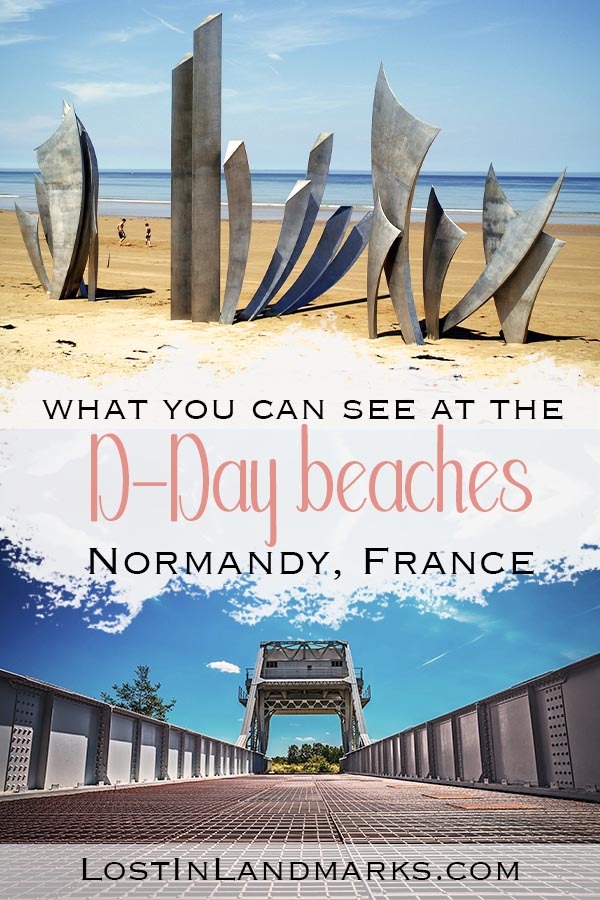
Kirsty Bartholomew
2 thoughts on “Visiting the beaches of Normandy: D-Day landings and WW2 sites – your ultimate guide”
Opening times typically range from 9-10am to 5-6pm, but daylight stretches much further. Therefore, my usual question: which beaches/sites can be acceptably experienced outside 9-18 time bracket?
Good question Pablo – all the beaches are accessible outside of opening times for the visitor centres. I would say to perhaps look at the tide times especially for beaches like at Arromanches as when the tide is out you can walk up to the pontoons but of course when it’s in they are covered. BUT definitely don’t let the fact that the visitors centres not being open deter you from going. Plenty to see!
Leave a comment Cancel reply
Normandy Travel Guide
Courtesy of © Marco Bottigelli | Getty Images

18 Best Things To Do in Normandy
Updated Feb. 11, 2021
Normandy's attractions are spread across the region, so we suggest you either spend a few days in just one or two towns or you set aside a week or two, rent a car and see a cache. If you're a foodie, you'll enjoy the bounty in Trouville and Honfleur
- All Things To Do

D-Day Beaches D-Day Beaches free
World War II's successful Operation Overlord took place on the coast of France. Although there were heavy Allied casualties, this invasion turned the tide in the war and helped lead to the fall of Nazi Germany. Today this piece of coastline, which includes Sword, Juno, Gold, Omaha and Utah beaches, is collectively known as the D-Day Beaches.
Visitors can tour the approximately 50-mile stretch of sand and pop by a number of museums, memorials and cemeteries that are spread out alongside the coastline either with a tour or on their own. If you're driving yourself, start in the town of Arromanches, which hosts two museums that help provide context for the battle sites. The American Cemetery in Colleville-sur-Mer and the Pointe-du-Hoc bomb craters are also especially moving. If you'd rather let someone else do the driving, recent visitors recommend going with a tour guide to fully appreciate the area's historic importance and receive a comprehensive overview. If you're visiting in June, you'll likely come across several ceremonies and reenactment groups commemorating the anniversary. Thanks to Normandy's unpredictable weather, you'll want to dress in layers (no matter the time of your visit) and bring rain gear, according to past visitors.

Mont Saint-Michel Abbey (Abbaye du Mont-Saint-Michel) Mont Saint-Michel Abbey (Abbaye du Mont-Saint-Michel)
Surrounded by sea in the high tide and sand in low, Abbaye du Mont-Saint-Michel is one of France's most-toured sites outside of the popular Parisian landmarks. It's also a UNESCO World Heritage Site. Its first incarnation was raised on the 264-foot-high rock beginning in the 10th century, but additions were added well into the 19th century. Today, you can tour the abbey and the little village at its base, as well as several museums. Tours are offered year-round, but you can also traipse the massive structure on your own.
Guided tours – which are included in the cost of admission – do not require advance booking and are offered in French and English year-round. Tours are also offered in German, Italian and Spanish in July and August.

Cathedrale Notre-Dame de Rouen Cathedrale Notre-Dame de Rouen free
Dating back to the 12th century, this Gothic cathedral was the world's tallest building for about five years – 1876 to 1880. But its beauty in changing light is what drew the impressionist artist, Claude Monet, whose work can be viewed at the Musee des Beaux-Arts de Rouen , to paint it several times. Today, the cathedral is one of the defining pieces of architecture in this part of Normandy. Aside from its striking architecture, it's also famous for its tombs – one of which houses the heart of Richard the Lionheart.
Visitors recommend going inside to view the many parts of this working Roman Catholic cathedral, including the lovely stained glass in the Lady Chapel, the transepts and the ambulatory monuments. Others add that it is worth coming at night in the summer to see the free light shows displayed outside. Reviewers also recommended reading up on the history of the church before you visit to enhance your experience and develop a better understanding of the many architectural styles on display.

Popular Tours

D-Day Beaches Shore Excursion with Packed Lunch from Le Havre
(37 reviews)
from $ 205.32

Normandy American D-Day Beaches Full Day Tour from Bayeux
(1044 reviews)
from $ 137.20

Normandy Battlefields D-Day Private Trip with VIP Services from Paris
(132 reviews)
from $ 823.21

Normandy American Cemetery and Memorial Normandy American Cemetery and Memorial free
Somewhere around 9,000 soldiers are buried in this Colleville-sur-Mer war cemetery, which overlooks Omaha Beach . Most of these lost their lives during the D-Day invasion. There's also a memorial that gives a narrative of the invasion, as well as a reflecting pool and a chapel. And about 1,500 soldiers who were missing-in-action are remembered on the Walls of the Missing, in a semicircle garden to the east of the memorial.
Recent visitors advised setting aside more time than you think you might need, as there is a lot to take in and you don't want to rush through such a moving place. Several others recommended visiting with a tour company to enjoy a more in-depth understanding of the site's significance. Companies like Normandy Sightseeing Tours , Bayeux Shuttle and Paris City Vision earn high praise from past visitors.

Musée des Beaux-Arts de Rouen Musée des Beaux-Arts de Rouen
The sprawling Museum of Fine Arts features paintings, sculptures, drawings and objets d'art that date back to the 15th century. Throughout the 19th century, generous donations made the museum home to one of the largest impressionist collections in France, with paintings by masters such as Monet, Sisley, Caillebotte, Pissarro, Degas and Renoir. Other highlights include works by Perugino, Veronese, Rubens, Caravaggio, Velázquez, Ribera and Poussin.
Recent visitors praised the museum's collection of impressionist works and the impressive range of styles represented here. For many, viewing Monet's paintings of the Cathedrale Notre-Dame de Rouen was a particular highlight. However, reviewers advised going in with a plan, as the museum can be a little hard to navigate.

Claude Monet's House and Garden Claude Monet's House and Garden
Who doesn't love water lilies, haystacks and gardens? Claude Monet, one of the world's most famous impressionists, lived and painted many of these subjects in his home in Giverny. Today, Monet fans can tour his excellently preserved home, studio and gardens. Among the highlights are the water garden (home to his famous water lilies) and the artist's house (especially the kitchen and the blue sitting room), which has been meticulously restored.
Recent visitors raved about the house and gardens, but many expressed disappointment with the crowds. If you want to avoid the onslaught of visitors, heed the advice of reviewers and visit right when the attraction opens to avoid the tour buses that descend in the afternoon. Others suggested visiting the lily ponds first and saving your house visit until the end.

Bayeux War Cemetery Bayeux War Cemetery free
The Bayeux War Cemetery is one of the largest of 18 military cemeteries in Normandy, with more than 4,000 graves – many of which mark the plots of soldiers who were never identified. These headstones are inscribed with "A Soldier Known Unto God." Keep in mind that if you're an American looking for your ancestors, you'll most likely have more luck at the American cemetery in Colleville-sur-Mer . The Bayeux War Cemetery contains soldiers from the United Kingdom and "the Continent," including some from Germany.
Recent visitors found the cemetery to be quite moving and somber. Others said this is a "must-see," applauding the beautiful grounds.

Eglise Jeanne d'Arc Eglise Jeanne d'Arc free
This modern-looking church sits on the site of Jeanne d'Arc's (or Joan of Arc, to us Yanks) burning. The 19-year-old girl was burned at the stake for heresy in 1431. Today, you can tour this contemporary church built in 1979 (the exterior of which is reminiscent of fish scales) at Place du Vieux-Marche in Rouen. Pay attention to the building's design – the architect, Louis Arretche, wanted it to resemble the shape of an overturned boat.
Recent visitors loved the church's gorgeous stained-glass windows and say it was quite moving to be in the spot where Joan of Arc was killed.

All-in-One Paris Highlights Shore Excursion from Le Havre Port
(28 reviews)
from $ 124.08

American D-Day Beaches Private Tour Full Day Tour from Bayeux
(324 reviews)
from $ 362.21

Utah & Omaha Beaches D-Day Group Tour from Bayeux
(1180 reviews)
from $ 156.96

Etretat Cliffs Etretat Cliffs free
These stunning white chalk cliffs have drawn people, especially artists, such as Claude Monet and Guy de Maupassant, to the area for eons. The cliffs are often compared to the famous White Cliffs of Dover. Visitors can hike along the top of cliffs, as well as on the beach to check out the striking sight.
Recent visitors were astonished at the beauty of the cliffs and recommended visiting at sunrise and sunset for spectacular photo ops. Others suggested hiking to the top of the cliffs for unforgettable views. Reviewers also reported touring the town of Étretat.

Museum of Modern Art André Malraux Museum of Modern Art André Malraux
This Le Havre art museum, located in a bright 1960s glass-and-metal building, boasts enormous plate glass windows that perfectly allow in the famous light that has fascinated artists for decades. This museum was actually the first to be built after the war. Le Havre's original Museum of Fine Arts was destroyed by bombing in 1944. Two local painters who immortalized the Normandy coast are highlighted here. The collection of works by Raoul Dufy includes oils, watercolors and sketches. Works by Eugène Boudin include his Normandy beach scenes and landscapes. It also has a number of works by Renoir, Pissarro, Sisley and Degas.
Past visitors raved about the museum's stunning coastal location and the collection of impressionist works. Others praised the friendly, knowledgeable staff.

Bayeux Tapestry Museum Bayeux Tapestry Museum
You might ask why on earth would you make a stop to see a tapestry when Camembert cheese, hard cider and the rolling Normandy hills are beckoning? Well, because the Bayeux Tapestry, an astonishingly long and beautifully made work of art, chronicles the 1066 Battle of Hastings.
The approximately 230-foot-long tapestry is displayed in a dark room with special lighting, so you can see every detail. Though it's described as a tapestry, it is actually linen cloth embroidered with wool thread. In another room of the museum, a permanent exhibition describes how it was made and gives an overview of the historical context and the Anglo-Norman kingdom in the 11th century. There is also a short 16-minute film, which details the making of the tapestry and includes reconstructions of scenes from the Battle of Hastings.

Mémorial de Caen Mémorial de Caen
This museum details events leading up to WWII as well as its decadeslong aftermath, with exhibits ranging from photos and documents charting the Nazi's rise to power in the 1930s, to life before and after the fall of the Berlin Wall. A tabletop map shows the location of the D-Day landings and a split-screen presentation of the D-Day invasion from both the Allied and Nazi standpoints gives a good overview. A 17-minute film, called "Europe Our History," is shown in a 360-degree theater and included with admission. Outside, you'll find three gardens dedicated to the memory of the Resistance fighters and Allied soldiers who died in Normandy.
Recent visitors appreciated the comprehensive and educational way the museum covers the war. Others said a visit here is a must before a trip to the D-Day Beaches as it provides important context to the sites. Reviewers said you should plan to spend half a day here to make the most of the museum's offerings and that the audio guide is essential. One particular highlight for travelers was the reconstructed underground bunker of a Nazi general.

Musée du Débarquement Musée du Débarquement
The Musée du Débarquement, located on the seafront where one of the most incredible achievements of WWII happened, shows how the prefabricated Mulberry Harbour was constructed. An engineering feat, the harbors were used to unload troops, vehicles and supplies during the Allied invasion of Normandy in June 1944. While not much is left of the floating harbors, you can still see some remnants of the concrete blocks that were towed across the English Channel. Museum exhibits include models, mock-ups, and photographs depicting its creation and the D-Day landings.
Recent visitors praised the small museum's models and explanations of how the harbor was conceived. However, some said its exhibits are a little dated.

From Le Havre: Paris Seine River Cruise and Highlights Shore Trip
(9 reviews)
from $ 174.52

Versailles Palace and Giverny Private Guided Tour from Paris
(42 reviews)
from $ 713.45

Paris Deluxe Shore Excursion from Le Havre Cruise Port
from $ 75.74

Palais Bénédictine Palais Bénédictine
Bénédictine liqueur is a big deal in Normandy and if you want to learn more about it, as well as take in the Palais Bénédictine – a Gothic- and Renaissance-inspired building erected in the late 1800s – this is the spot. Le Palais Bénédictine was built in honor of the Bénédictine liqueur by Alexandre Le Grand, a wine merchant from Fécamp who discovered a lost recipe for a potent elixir dating back to 1510 created by a Bénédictine monk. Le Grand named the liqueur after the monks. He also stocked the palace with his art collection.
Today, visitors can explore the museum on a guided tour, which features collections of sacred and ancient art related to the legacy of Bénédictine, as well as a room dedicated to its industrial history. After the museum tour, you head to the only Bénédictine distillery in the world and enjoy a tasting of the liqueur in the palace's Winter Garden.

Chateau Gaillard Chateau Gaillard
This castle fortress was amazingly built in a mere two years, between 1196 and 1198, at the direction of Richard the Lionheart, King of England and the Duke of Normandy to protect Rouen against the French. It was captured by Philip II after a six-month siege; Henry IV later ordered that it be destroyed. Today, its clifftop ruins are a reminder of its dramatic past and a fascinating place to visit.
Recent visitors were fascinated by the complex history of the fortress. Others raved about the views and recommend bringing a picnic to enjoy on the grounds. According to recent travelers, there is a large free parking lot within walking distance.

Historial Jeanne d’Arc Historial Jeanne d’Arc
Read More »

Cité de la Mer Cité de la Mer

Airborne Museum Airborne Museum

Paris On Your Own from Le Havre Port: Round Trip Bus Transfer
(15 reviews)
from $ 92.80

D-Day Omaha Beach Morning or Afternoon Group Tour from Bayeux
(783 reviews)
from $ 90.55

Omaha and Band Of Brothers Full Day Tour
(609 reviews)
from $ 155.86
Explore More of Normandy
Best Hotels

When To Visit
If you make a purchase from our site, we may earn a commission. This does not affect the quality or independence of our editorial content.
Recommended
The 28 Best Water Parks in the U.S. for 2024
Holly Johnson|Timothy J. Forster May 8, 2024

The 18 Best Napa Valley Wineries to Visit in 2024
Lyn Mettler|Sharael Kolberg April 23, 2024

The 25 Best Beaches on the East Coast for 2024
Timothy J. Forster|Sharael Kolberg April 19, 2024

The 50 Best Hotels in the USA 2024
Christina Maggitas February 6, 2024

The 32 Most Famous Landmarks in the World
Gwen Pratesi|Timothy J. Forster February 1, 2024

9 Top All-Inclusive Resorts in Florida for 2024
Gwen Pratesi|Amanda Norcross January 5, 2024

24 Top All-Inclusive Resorts in the U.S. for 2024
Erin Evans January 4, 2024

26 Top Adults-Only All-Inclusive Resorts for 2024
Zach Watson December 28, 2023

Solo Vacations: The 36 Best Places to Travel Alone in 2024
Lyn Mettler|Erin Vasta December 22, 2023

26 Cheap Beach Vacations for Travelers on a Budget
Kyle McCarthy|Sharael Kolberg December 4, 2023

- Travel Planning Guide
The Best Tours to the Normandy D-Day Beaches from Caen

Tours to the Normandy D-Day beaches from Caen, France, offer visitors a profound and immersive experience delving into one of the most pivotal moments in modern history. Departing from the city of Caen, these tours take participants on a journey through the poignant landscapes and historic sites associated with the Allied invasion of Normandy on D-Day, June 6, 1944.
These tours typically include visits to significant locations such as Omaha Beach, Utah Beach, Gold Beach, Juno Beach, and Sword Beach, where Allied forces landed amidst fierce German resistance. At each beach, knowledgeable guides provide insights into the strategic importance of the landing sites, the challenges faced by the troops, and the ultimate triumph of the Allied forces.
Participants have the opportunity to walk along the same sands where history was made, visit key landmarks such as bunkers and gun emplacements, and pay their respects at memorials and cemeteries honoring the fallen soldiers. Highlights often include the Normandy American Cemetery and Memorial at Colleville-sur-Mer, where thousands of American soldiers are laid to rest overlooking Omaha Beach.
Additionally, tours may include visits to museums and interpretive centers dedicated to preserving the memory of D-Day and the subsequent Battle of Normandy. These institutions offer exhibits, artifacts, and multimedia presentations that provide deeper insights into the events of the invasion and the experiences of those who participated.
Some tours from Caen also incorporate stops at other significant sites in the region, such as the Pointe du Hoc, where U.S. Rangers scaled cliffs to neutralize German artillery positions, and the historic town of Sainte-Mère-Église, the first town liberated by Allied forces on D-Day.
These tours from Caen to the Normandy D-Day beaches offer a moving and educational experience, allowing visitors to connect with the past, honor the sacrifices of the soldiers who fought for freedom, and gain a deeper understanding of one of the most consequential moments of World War II.
(Prices are listed in U.S. Dollars.)
Small Group Guided D-Day Tour and Mémorial de Caen Museum
Mémorial de caen museum admission and guided tour of d-day sites, private day tour including normandy landing beaches & battlefields from caen, private tour: d-day beaches from caen, the normandy landing beaches - private tour, d-day private tour omaha beach from caen with audio guide., d-day omaha beach sector - small group from caen aboard a van, fly above normandy's hallowed coastline in a private plane, private transfer to the landing beaches, d-day sainte mère eglise - small group from caen aboard a van, d-day gold beach, arromanches - small group from caen abard a van, how much do normandy beach tours cost in caen.
In Caen, Normandy Beach tours cost on average $719 based on our research of 31 different tours. Many of these tours offer varying activities, add extra services, and last different lengths of time, so it's not always possible to compare every option equally. Also, the highly rated options tend to cost a bit more on average.
Caen Travel Costs Caen Hotel Prices
If you have a specific amount of time for your trip, see our advice about how much time to spend here: Should I spend 1, 2, or 3 days in Caen? and Should I spend 3, 4, or 5 days in Caen? .
Subscribe to our Newsletter
By signing up for our email newsletter, you will receive occasional updates from us with sales and discounts from major travel companies , plus tips and advice from experienced budget travelers!
Budget Your Trip

Some of the links on this website are sponsored or affiliate links which help to financially support this site. By clicking the link and making a purchase, we may receive a small commission, but this does not affect the price of your purchase.
- Privacy / Terms of Use
- Activities, Day Trips, Things To Do, and Excursions
- 0 Favorites
- Things to see and do
Normandy Tourism, France
- Active & outdoor
- Lifestyle & Wellness
- Discover Normandy
- Plan your trip

Things to see and do in Normandy
© G. Wait / Calvados Attractivité
Find out more
Updated on 6 July 2021
Reading time: 1 minutes
Amazing countryside walks, invigorating coastal hikes, scenic cycle routes, lively historical cities, UNESCO World Heritage Sites, picturesque fishing ports, chic seaside resorts or quaint country villages, there are endless places to discover and things to do in Normandy, whether you’re visiting for a weekend or for a holiday, you’ll want to come back again and explore more!
If you’re after family fun, there are loads of family-friendly attractions and activities. If you’re after adrenaline-filled things to do, you can find the best places for water sports, horse-riding, skydiving, cliff-climbing, bungee jumping and more. If your idea of bliss centers around peace and quiet, hit one of our glorious beaches, ramble in miles of unspoilt countryside, visit historic buildings and awe-inspiring gardens, browse museums and art galleries.

The best things to see and do
Normandy is full of diverse and beautiful landscapes, famous for inspiring painters and home to a key battle that led to the Liberation of Western Europe.
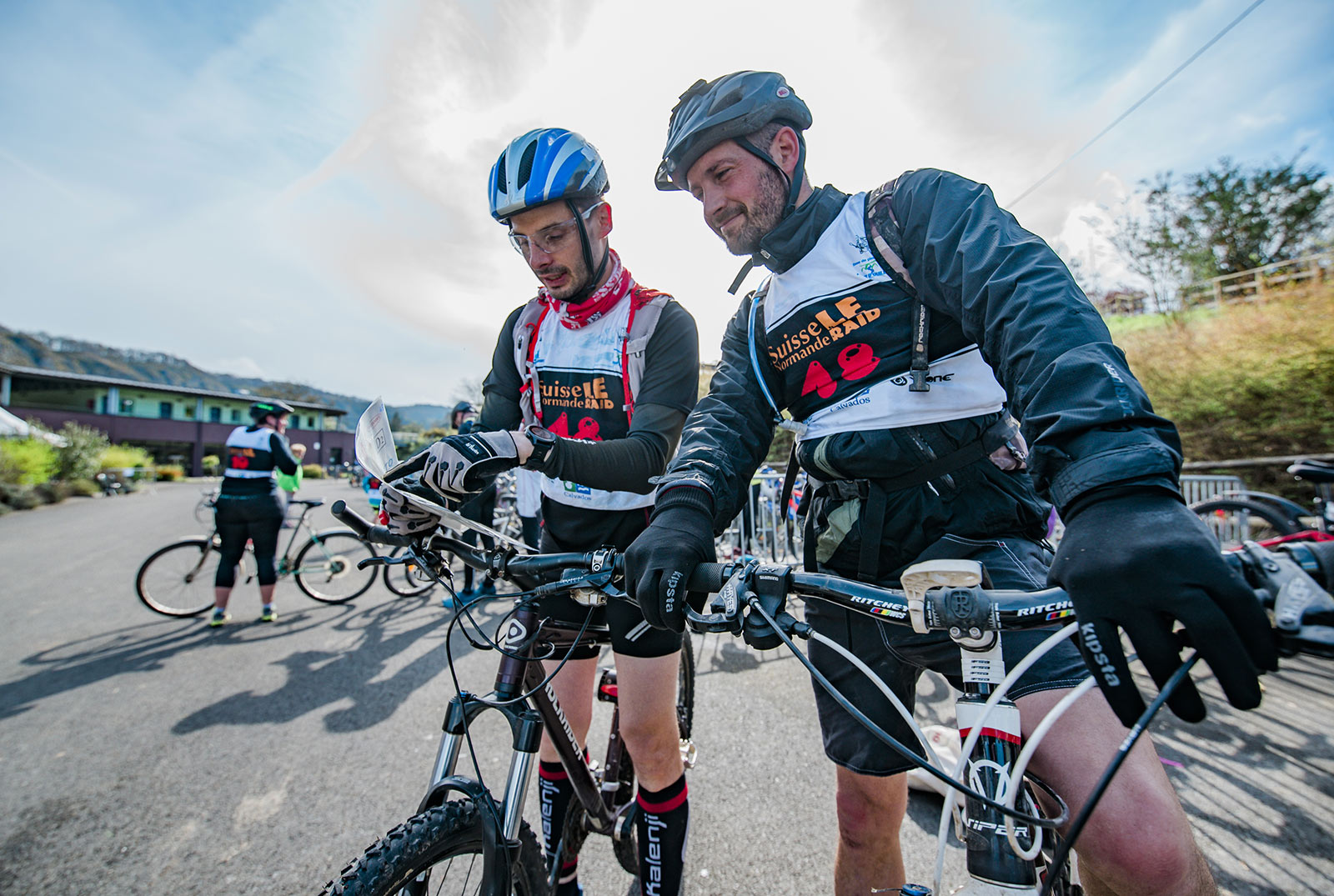
Sports Activities
See the best of Normandy’s natural beauty from dizzying heights, from deep down in the ground or from its dramatic shores. The great diversity of landscapes throughout Normandy offers the perfect backdrop for adventure activities like climbing, hiking, sailing, cycling, skydiving and more. Ideal for adding a touch of action and thrills to your holiday!
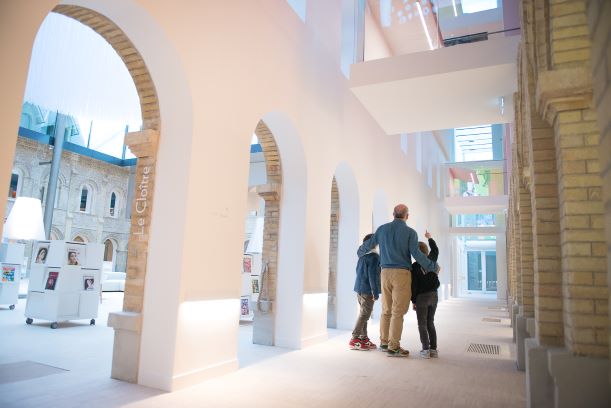
Leisure activities
Normandy is well known for its simple pleasures and relaxed way of life. Whether you’re here for the weekend or on a longer break, there’s a wealth of leisure activities to enjoy – both fast-paced and laid-back – for all ages, all year round.
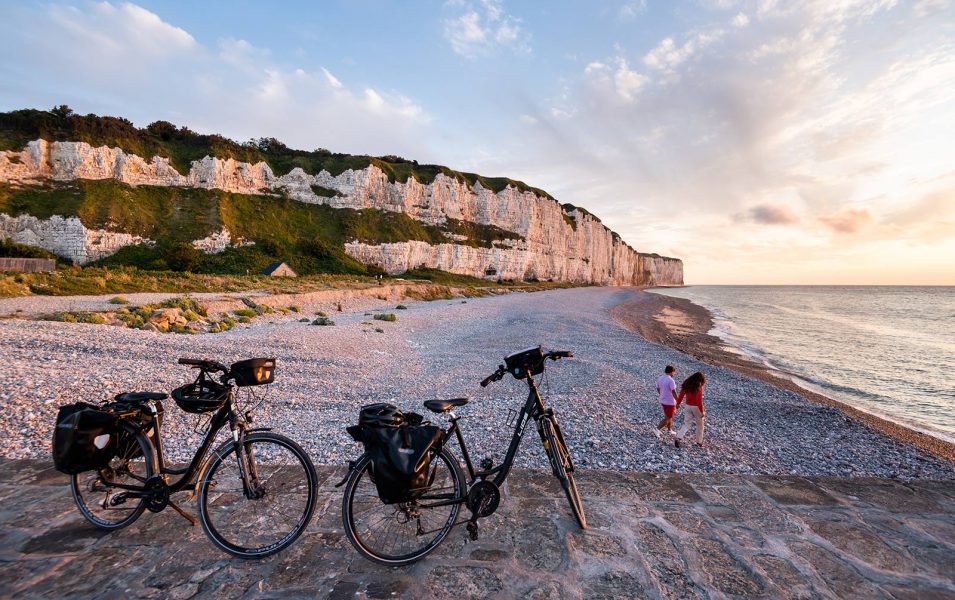
Coastline and Beaches
Normandy’s coastline comprises stretches of golden sand, dramatic cliffs, pebble coves, sand dunes and sheltered bays interspersed with harbour towns, fishing villages and modern coastal resorts.
Return to top
Are you already in Normandy?
Plan what to see and do while you’re here by visiting normandy-secrets.com, which lets you in on all of the local secrets and hidden gems in the immediate vicinity!
Close search box

IMAGES
VIDEO
COMMENTS
Juno Beach. On D-Day, 14 000 Canadians and 6,400 British troops landed on Juno Beach, taking heavy casualties. At Courseulles-sur-Mer, the Juno Beach Centre is the only museum entirely funded by veterans and their charities, and commemorates Canada's unique contribution.
Beaches of Normandy Tours Band of Brothers Tours 48 Rue de Thouays, 50480 Sainte-Marie-du-Mont, Normandy, France. Phone: +1 855-473-1999 Monday - Friday, 10am - 6pm ET e-mail: [email protected]
Visit the D-Day landing beaches in Normandy : Map + tips The 5 landing beaches - map and introduction. Operation Overlord, a.k.a. the Normandy invasion, began on June 6, 1944. 5 main areas were strategically chosen by the Allies on the Normandy coast. They cover a section of more than 80km (50 miles). Code names have been given:
6 June marks the 75th anniversary of the D-Day beach landings, the largest seaborne invasion in history. Early on the morning of 6 June 1944, swarms of landing craft arrived on the beaches of northern Normandy in France, and 135,000 Allied soldiers started to pour onto French soil. The 80km stretch of beaches, north of Bayeux, were code-named ...
Gold Beach was one of three Normandy landing beaches assigned to the Commonwealth forces on D-Day. The landing zone stretched 8 kilometres from Port-en-Bessin in the west to La Rivière, Ver-sur-Mer in the East. The seaside resort of Arromanches lay in the west of the landing zone. Deeper inland from Gold sat the historic town of Bayeux.
Calvados. Discover the best attractions in D-Day Beaches including Longues-sur-Mer Battery, Normandy American Cemetery & Memorial, and Overlord Museum.
Recounting the Normandy Campaign from the Allied troop preparations to D-Day on June 6th, 1944 and the liberation of Paris on August 25 th, the 2,300-square-meter exhibition includes military equipment used on the landing beaches, as well as an excellent film "Normandy 44, a Decisive Victory in the West." This film, combined with the exhibits ...
The Normandy Coastline: D-Day Beaches and Popular Towns . Normandy is perhaps most famous for the events that took place on five of its beaches on June 6, 1944—known around the world as D-Day.It was on this day that the Allied Forces carried out the largest seaborne invasion in history to seize control of France's crucial ports from the Axis Powers during World War II.
4. Omaha Beach. It goes without saying that Omaha Beach can't be missed at the Normandy beaches. The Allied forces decided to call the beach landing part of the attack Operation Neptune. They designated five beaches as landing zones, and Canadian and British soldiers landed at Juno, Gold, and Sword beaches.
Suggested Tours: Normandy Beaches: From Paris - a full-day tour including lunch and From Paris - a full-day small group tou r. From Bayeux - American D-Day sites (4 to 8 hours) From Bayeux- Canadian D-Day sites. How To Visit The D-Day Beaches In Normandy: By Local Bus. On this trip of mine through Normandy, I relied on the local buses and ...
10. Best bonus D-Day sites tour. My pick for best bonus D-Day sites tour: Utah & Omaha Beaches D-Day Group Tour from Bayeux. This tour visits many of the same sites as the others, but I'm calling this a "bonus" tour because it passes by a number of additional sites you might not otherwise see.
D-Day, also known as Operation Overlord, was a significant event in history that took place on June 6, 1944. It marked the beginning of the Allied invasion of Normandy during World War II - which continued until July 24, 1944. On this day, a massive amphibious assault was launched on the beaches of Normandy, France, by British, American ...
Visiting the beaches of Normandy, with its wealth of D-Day and world war 2 sites, ... Guided tours from Paris to Normandy are plentiful from the capital with some taking in the area over a couple of days and others just doing a day trip.
Holly Johnson December 1, 2023. Ranking of the top 18 things to do in Normandy. Travelers favorites include #1 D-Day Beaches, #2 Mont Saint-Michel Abbey (Abbaye du Mont-Saint-Michel) and more.
Our first-class historical tours take you on a journey through iconic World War II sites around Europe, as well as the most emblematic moments of American heroism of the time. From the Normandy beaches to Bastogne and the Bavarian Alps we guide you through the significant events and experiences of the war that changed the world.Band of Brothers Tour is a registered brand and protected ...
Tours to the Normandy D-Day beaches from Caen, France, offer visitors a profound and immersive experience delving into one of the most pivotal moments in modern history. Departing from the city of Caen, these tours take participants on a journey through the poignant landscapes and historic sites associated with the Allied invasion of Normandy ...
In 2024, Normandy honours the memory of these events and the men and women who came from all over the world to liberate us. IT'S NOW OFFICIAL! The international ceremony will take place on Omaha Beach on Thursday 6 June 2024. Many heads of state, veterans and officials will commemorate the 80th Anniversary the D-Day Landings and the Battle of ...
The 6 June 1944 was a turning point in the Second World War with the Allied landings on the Normandy coast during Operation Overlord - the Invasion of mainland Europe. On what is our main WW2 Introductory Tour we see some of the most iconic D-Day locations and visit all the D-Day landing beaches along the Normandy coastline as well as seeing ...
The great diversity of landscapes throughout Normandy offers the perfect backdrop for adventure activities like climbing, hiking, sailing, cycling, skydiving and more. Ideal for adding a touch of action and thrills to your holiday! Normandy is well known for its simple pleasures and relaxed way of life. Whether you're here for the weekend or ...